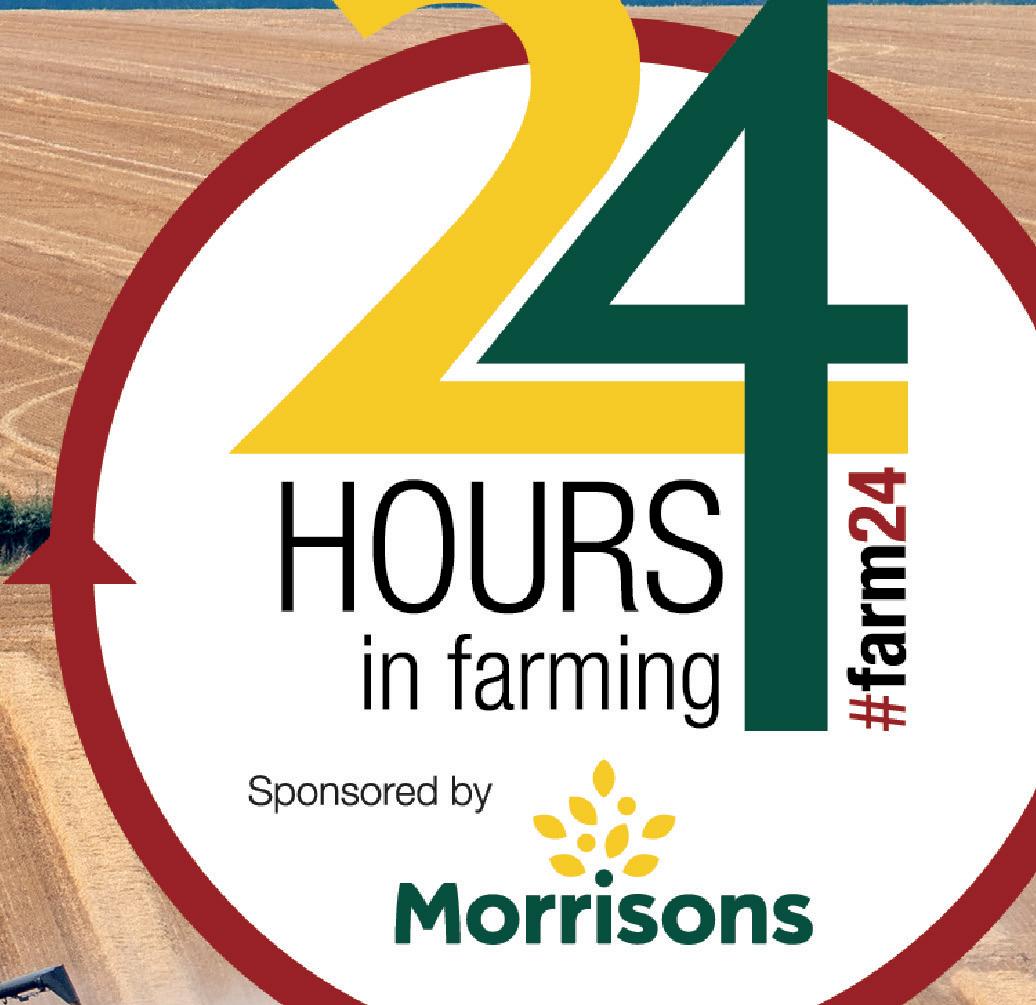














































































































Content Editor/Designer
Mike Begley 01772 799 405 mike.begley@agriconnect.com
Picture Editor
Marcello Garbagnoli 01772 799 445 marcello.garbagnoli@agriconnect.com


Head of Commercial Solutions
Mike Hartley 01772 799 532 mike.hartley@agriconnect.com
Account Manager
Mark Jackson 01322 449 624, mark.jackson@agriconnect.com
Classified Advertisements
01772 799 400 fgclassified@agriconnect.com
Advertising Production
Justine Sumner 01772 799 437
01772 796
justine.sumner@agriconnect.com
Circulation and

Subscription rates:
1475-6994
© Farmers Guardian
£65
rights reserved. No part of this publication may be reproduced or transmitted in any form or by any means, electronic or mechanical including photocopying, recording, or any information storage or retrieval system without the express prior written consent of the publisher. The contents of Dairy Farmer are subject to reproduction in information storage and retrieval systems.
Who would have thought this time 12 months ago that we would be talking about milk prices of 50ppl. But as we all know a lot can, and certainly does, happen in 12 months.
Freshways became the first processor to reach this milk price milestone, with its price rise coming into effect from September.
The company says it has made this move to reflect the ever-increasing costs of production faced by its farmers, but it also wants to secure the milk supply it requires going forward.

With more farmers choosing not to ‘turn on the taps’ in terms of milk volume, and UK and GB volumes being down compared to previous years, surely other processors will have to follow suit and we will start to see further 50ppl breakthroughs?
But as the last 12 months has certainly shown, it is not easy to predict what will happen.
Kingshay’s latest annual dairy costings focus report has shown that small improvements in efficiency can have more of an impact than ever in light of these high costs and high milk prices.
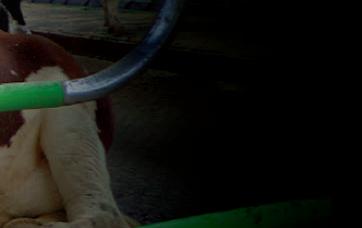
So as Kingshay’s Kathryn Rowland discusses in Dairy Matters (see p14-15), perhaps now is the time to look at the best ways to future-proof farming businesses? This, she suggests, could include re-investment in grassland improvements, infrastructure or cow management and comfort.
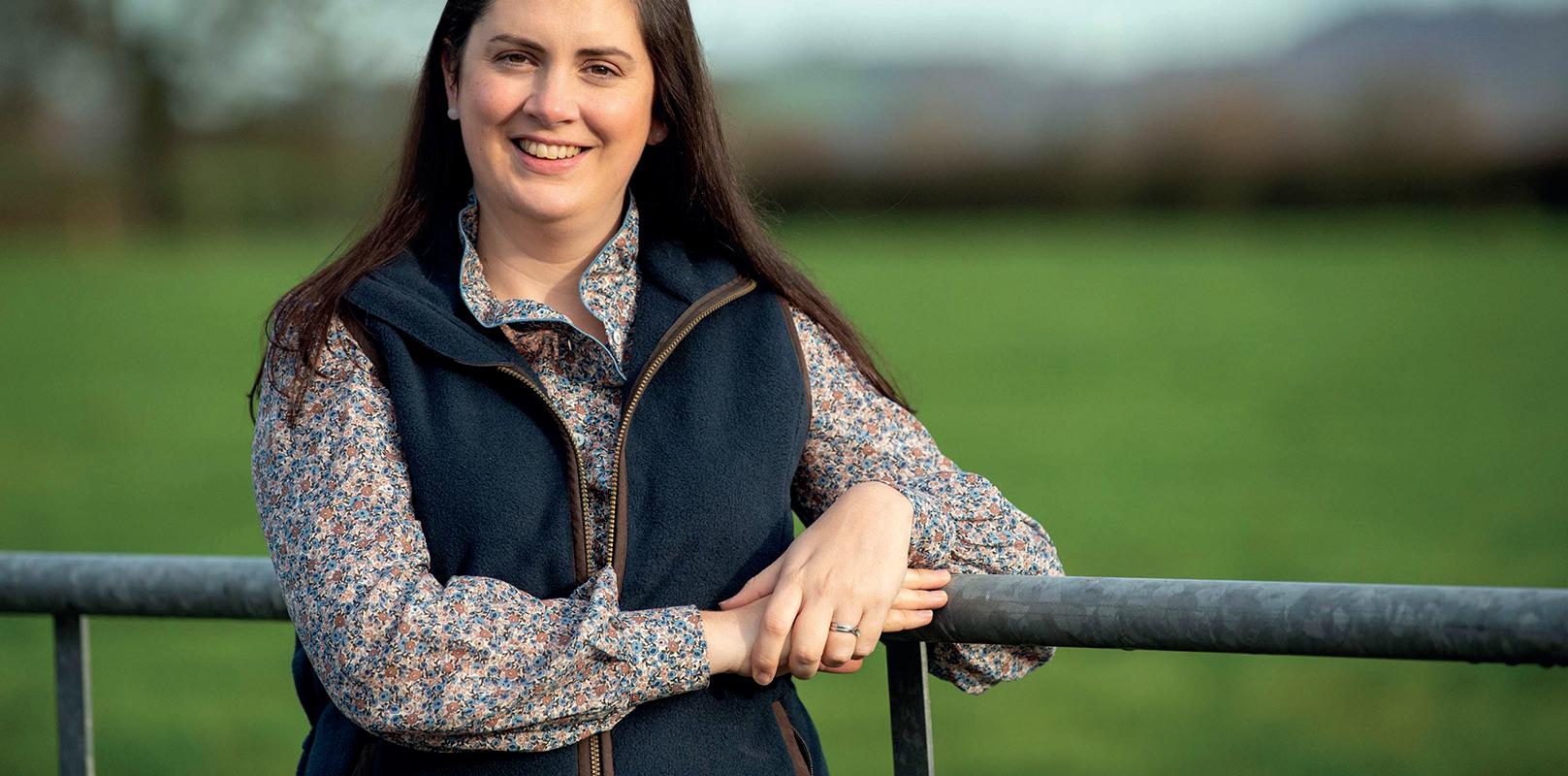
And finally, for all the latest dairy industry news and updates, make sure you visit the new online Dairy Hub at FGinsight.com/ dairy-farmer-hub, where you can also sign up for our dairy-specific e-newsletter.

VIEW
MILK PRICES
ANALYSIS

Dairy farmers have seen no ‘net’ benefit to their finances from record high milk prices with input cost rises can celling out the price increases.
Data from Defra showed farmgate prices have increased at roughly the same rate as agricultural input costs so far in 2022.
improvement in production. This deficit has persisted into 2022, even through the peak production period.”
She added the delayed re sponse in milk prices to rapid inflation suggested farmers will still be working to fully recover the relatively large cost increase from late last year.
STORAGE
NEW PRODUCTS
MACHINERY
firm
DAIRYING
GOOD EVANS
BUSINESS CLINIC
AHDB lead dairy analyst Patty Clayton said milk pro duction typically responds ‘positively’ to higher farmgate milk prices, assuming costs remain relatively stable.

She said: “However, with the rapid increase in input cost inflation since summer 2021, Great British milk production has been lagging behind year earlier levels.
“Despite milk prices increasing by more than 10ppl on average since the beginning of the year, we have not yet seen any significant
NFU dairy board chair Michael Oakes said there had been a lag from prices going up to milk prices catching up, but it was now in a place where it looked like there was a ‘light at the end of the tunnel’.
He said: “I have not met one farmer going out of their way to push for milk, nobody is chas ing those marginal litres. In the past people would have done.”
He said people were culling cows harder, reducing feed and growing as much grass as they could while holding back on fertiliser use.
one-quarter of dairy
to stop or are
ceasing milk production
next two years, a new study
NFU has revealed.
under 700 members
completed the Milk Production
which was designed to
producers’ thoughts on the industry at present.
those questioned, 15% said
were considering ceasing milk production, while another 7% said they planned to quit production altogether before 2024.
Smaller producers (those supplying fewer than one million litres) make up most of those intending to stop (12%) and also make up the largest group of those more likely to be unsure of continuing.
Mr Oakes said people were wondering what would happen next and whether prices were approaching the peak.
Farmers were uncertain whether prices would keep rising, which had been highlighted when Muller
announced a price hold for August.
Mr Oakes said many Muller farmers would nd the announcement disappointing, given many middle-ground
players were talking about paying in the region of 50ppl for August.
He said: “ is price will not get Muller any more milk as it will not incentivise farmers to increase production and could ultimately lead to less milk for the processor.”

JA farm which featured on a BBC Panorama programme showing shocking footage of animal abuse has been recertified by Red Tractor (RT) after meeting the requirements for a reapplication.
The undercover footage, which aired in February, sparked outrage among the public and farmers and led to the termination of the farm’s RT membership.
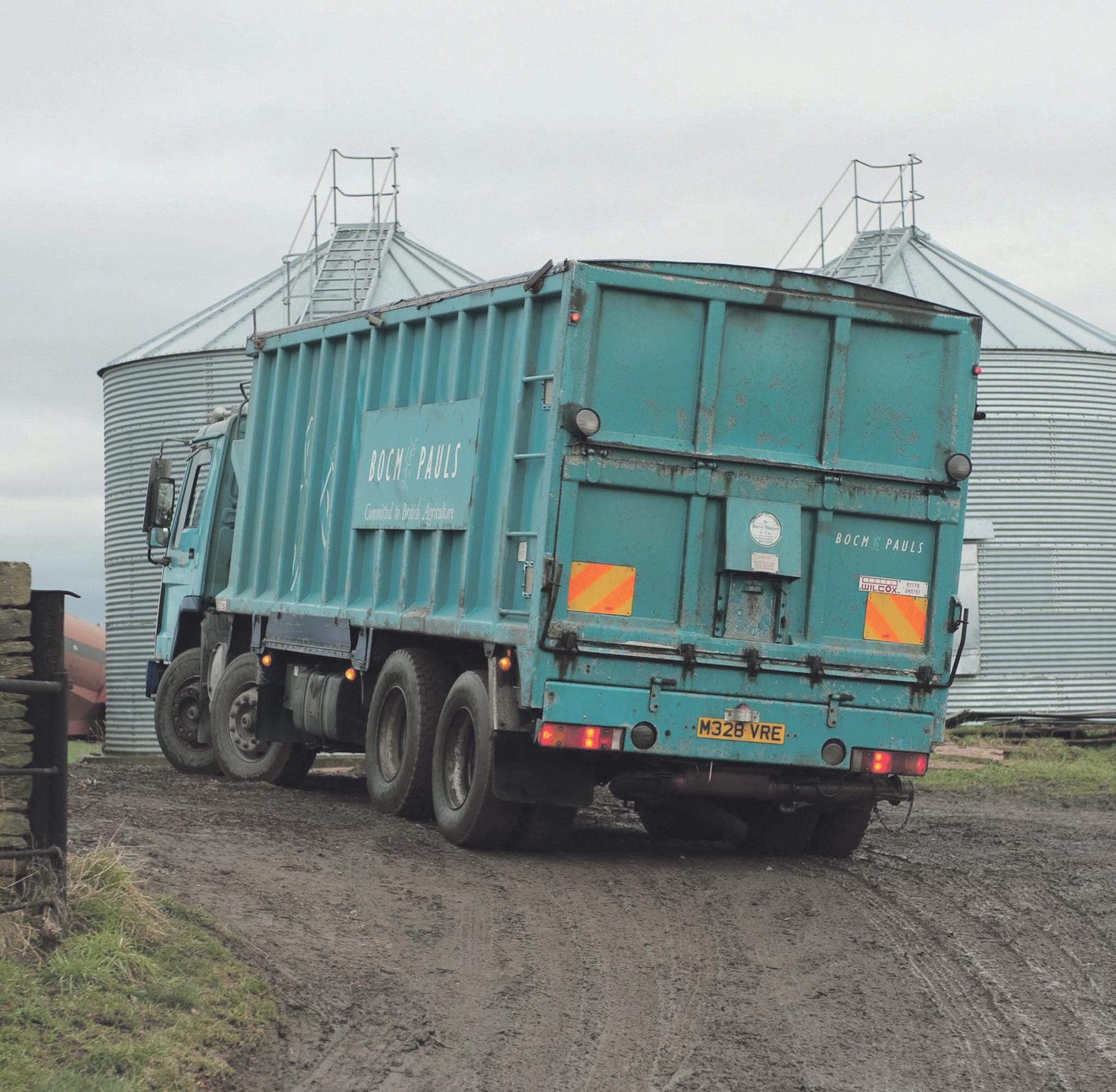
JDairy Crest, now owned by Saputo Dairy UK, has been given a £1.52 million fine after it admitted causing pollution incidents in Cornwall. For committing this catalogue of offences, the firm was fined £1.52m at the Crown Court on June 23.
JA new event, Grazewell, will explore how regenerative farming techniques can exploit the advantages of grassland farming to develop systems which are fit for the future.
It takes place on September 22, 2022, at Higher Thornton Farm, Kenn, Exeter EX6 7XH, from 9am until 5pm by permission of Chris and Sarah Berry. rFor more information, go to facebook.com/grazewellevent
Labour shortages are already reducing dairy production and contributing to food price inflation. That was the message from Arla as it warned the situation would get worse unless urgent action was taken.
A survey of 541 UK Arla farmers showed 80% of farmers looking for workers have received ‘very few’ or ‘zero’ applications from people with the right experience or qualification, with 61.3% finding it more difficult to recruit now than in 2019.
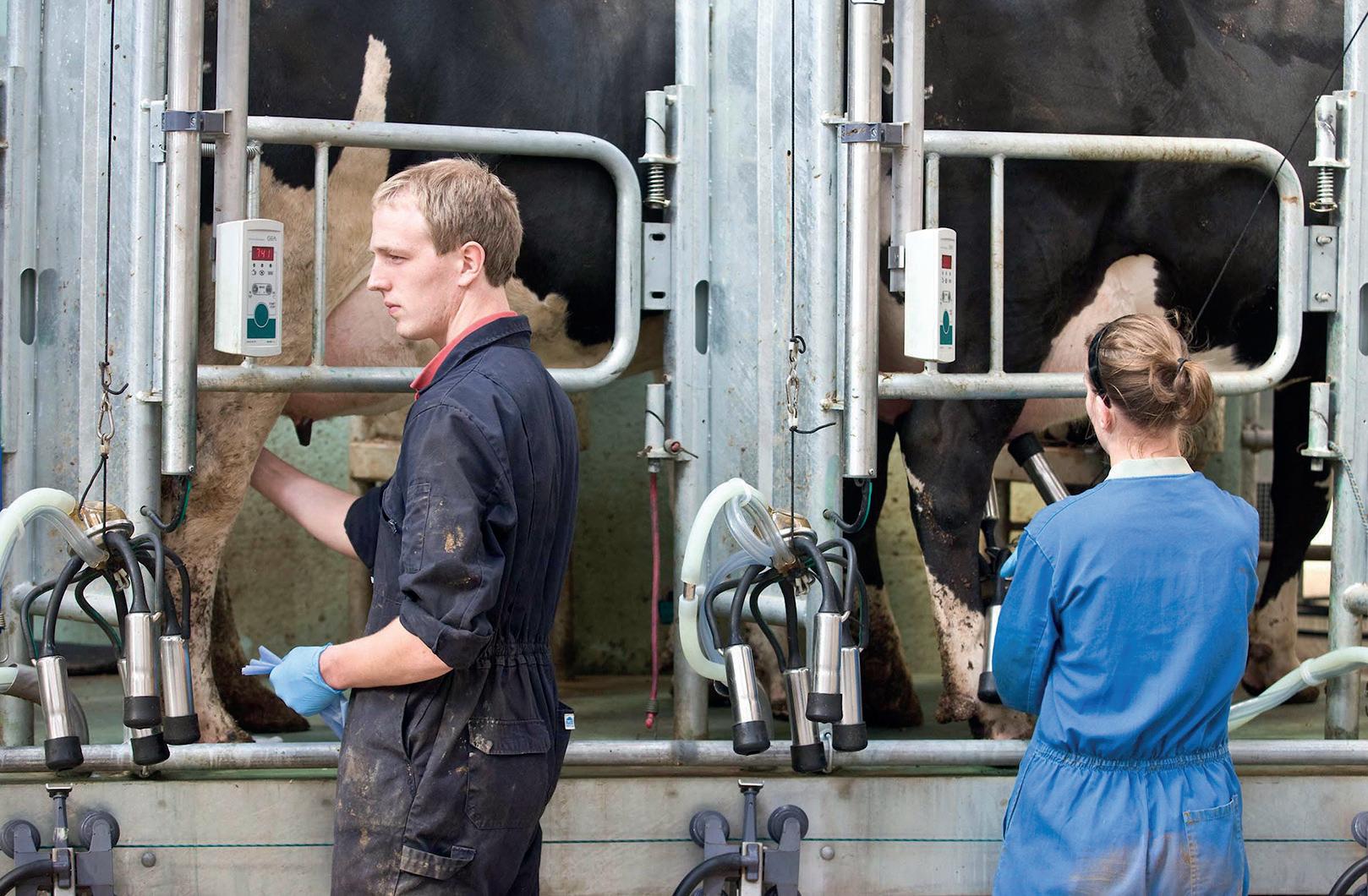
The survey revealed 4.3% of farmers had already cut the number of milkings, with 6% reducing the size of the herd and more saying they would take these steps or leave the industry if nothing changed.
Arla has been calling for specialist roles, such as herd manager, to be added to the Shortage Occupation List, and has also been engaging with the Institute of Agriculture and Horticulture and said it sup ports the focus on improved skills and qualifications for farm workers, as well as recruitment.
But it was now calling on the Government to go further.
Arla’s UK managing director Ash Amirahmadi said: “Addressing
the labour shortage and the implications this could have for food security is vitally important.
“Now is the time for all of us, across Government and industry, to work urgently and collaboratively to shift outdated misconceptions about farming and bring new talent into the industry.”
Mr Amirahmadi said he had written to the Secretary of State
JBoris Johnson has had plenty of criticism thrown his way since he took up a career in politics, writes Abi Kay. But until recently, none of it stuck.
For his long-suffering Minis ters, who had been wheeled out to defend his conduct on many occasions, the sexual harassment scandal involving Chris Pincher, his deputy chief whip, was the straw that broke the camel’s back.
Now, Mr Johnson’s time in Number 10 is drawing to a close. But what does this mean for dairy farmers?

As I write, Penny Mordaunt has, for the first time, become the bookies’ favourite to win the contest.
And what does she think about farming? I scoured Hansard, her website and social media channels to find out and the answer is ‘not much’.
The only time she ever spoke about any agriculture-related matter in Parliament was in 2013, when she gave a speech on poultry welfare for the sole purpose of saying c**k as many times as possible in the House of Commons after losing a bet
with the letter calling on Govern ment to accelerate the review of the labour market promised in the Food Strategy White Paper, and to com mit to a new cross-departmental strategy to bring talent into food and farming, making it a career of choice for people from all backgrounds.
He said: “This will need to include on-farm skills and training, but will also address teaching in schools, the
understanding and attitudes of careers advice providers, support for people wanting to change career and a marketing campaign aimed at promoting careers in our industry.
“If we do not act now the current shortages of people will only get worse, jeopardising production on farms, undermining our food secur ity and further fuelling higher prices for consumers.”
to her Royal Navy colleagues.
Most farmers would not find her record in Government, where she served as a Minister at the Department for Inter national Trade (DIT), much more encouraging.
During her time at DIT, she vigorously defended the trade deals recently signed by the UK, despite the fact that the Government’s own impact as sessments show they will reduce domestic farming output.
If recent accounts of civil servants at the department are to be believed, she did not take
her responsibilities there too seriously, with one claiming she had neglected her duties so consistently that they were ‘a Minister down’ for six months.
If – to borrow her campaign slogan – PM is to become PM, the agriculture industry will expect much more.




Wallace Gregg runs the family farm in mid-Antrim, near Ballymena, Northern Ireland, where he milks 180 pedigree Holsteins under the Frocess prefix and sells his milk to Dale Farm Co-op. Wallace is actively involved with Holstein UK, representing Northern Ireland at local and national level.

Isuppose one of the best things about being a farmer is that every day, and indeed every season, is different so that we don’t get bored doing the same task every day. This spring has certainly been different and has resulted in major challenges to our business.
The objective was to make top quality first cut silage, so that we could lower feed rates of really expensive concentrate over the winter. However, the weather just didn’t play ball, with non-stop showers for the majority of May, combined with high growth rates which saw us only getting our first cut in the pit on Friday, May 27. Now we were fortunate to get the crop in dry, with no effluent, but quality was way down.
The hold up in silage making also meant that afterwards, grass was supposed to be coming into the grazing rotation, but has been very slow. This has meant we have had to buffer feed the cows at grass, more to keep the rotation at around 21 days.
Managing grass during these swings in weather and grass growth has been challenging, as we have tried to match demand with growth. However, like all dairy farmers, we just got on with it by pre-mowing paddocks and taking out surpluses and we will target high quality leafy second and third cut silage to improve our forage quality situation. The plus side to a late cut is that we should have no worries about running out of silage over winter.
We get our vet to scan and pregnancy diagnosis cows every four weeks and touch wood, we have had a quite successful year with pregnancies and we would OvSynch any cows that are not served after 70 days in milk. We have found this works well combined with a heat detection system when the cattle are inside.
Our normal practice on our farm was to run two Holstein bulls, one with the cows and one with the heifers, during June and July, to help catch the last few services, but I think we will stop this as both our Holstein bulls have turned cross and hard to handle, not to mention that Holstein bull calves are virtually worthless at the minute due to high costs.
As we are all aware, costs and inflation have
increased exponentially for everyone and although milk price has increased, unfortunately we entered into a fixed milk price scheme over a year ago which, at the time, seemed okay paying 29ppl for October to March and 26ppl for April to September, for about 15% of our milk supply. With current costs this decision is costing us a small fortune and our dairy co-op is in negotiations with the clients to see if they will make a goodwill payment towards these suppliers. I believe they should for two reasons.
Firstly, a fixed milk price scheme was never intended for either party to make or lose excessive amounts of money, but as a mechanism to guar antee supply at a reasonable price to help with forward planning. And secondly any participating farmers will probably never enter any such scheme again after getting ‘burned’ so badly this time and will resent the excessive profiteering these firms are carrying out at their expense.
In conclusion, a shout out to all the local agricultural shows that are back up and running after Covid-19. We were recently at our local show, Ballymena and had a great day, so thanks to all the volunteers that help at all the shows throughout the UK to help preserve this great part of our rural community.
Claire Eastham farms with her husband Martyn in Dorset, where they milk 120-spring calving cows. After gaining knowledge and experience working for other businesses, the couple started their own dairy farming journey in 2015 by taking on a share farming agreement before progressing to their current county council farm.

Martyn and I recently applied for a much larger opportunity on a longer Farm Business Tenancy (FBT).
Unfortunately, after making the final three, we were unsuccessful this time around, but this got me thinking about how vital it is to have a range of farm sizes.
By not having a range of farm sizes, we are cutting rungs out of the farming ladder, meaning it is stagnating as it takes so much longer to reach the next rung and free up space for those starting out.
Medium-sized holdings seem to have disappeared or amalgamated, which creates an easy solution for a landlord to only have to deal with one tenant.
We are fortunate to have our county council holding and are halfway through a 10-year FBT, so have no pressure to move. But we want to progress our business, are able to do so and should hand the opportunity back to the next new entrant.
As George Henderson wrote in The Farming Ladder: “Once started you will find others on the ladder too, some above and some below; give them all a helping hand.”
Many farmers will soon be faced with some tough choices due to a reducing Basic Payment Scheme (BPS), a lack of reliable labour and high input costs.
Do these farmers radically change system, give up or help someone else on their way by forming a joint venture?
Full of new fresh ideas and enthusiasm to push forward a business if both parties are open, this is a great way forward and an alternative way to give people that first chance.
If this Government was serious about helping new entrants into farming, there would be the retention of BPS or similar for under 45-year-olds – perhaps even with a scalable pay rate geared towards smaller holdings, low interest rate, Government-backed loans for those who propose a sensible business plan and a matching scheme for such joint ventures.
However, there also needs to be a variety of second and third rungs. I would say to any estates before taking back in hand or amalgamating, consider if you are cutting rungs out of the ladder and what that chain brings to the rural economy and communities.
Back on-farm, seemingly like the rest of the country, we are very dry with no real rain forecast, we have been
buffer feeding already to extend our grazing round and keep fresh grass going into the cows, but growth is so low.
We have grazed the herbal lays after letting them flower and so this long cover slowed the round down and with some trampling effect would have helped to nourish our soils.
Building organic matters to help with water retention and build drought resilience as well as improve carbon capture is our key focus on farm.
The noise increase was also noticeable as we crossed the threshold from a straight ryegrass and clover ley into our more diverse swards.
The variety of insects and butterflies was astounding. This was definitely the motorway of bug life. We cannot see how this is not the future of dairy grazing. We are on heavy soil and the birdsfoot trefoil and yarrow have performed exceptionally well.
This year we have so far used only 20kg of nitrogen on average per acre across the whole 264 acres and will still hope to utilise 10.5 tonnes of home-grown dry mat ter, so are well on the way to a very low input system.
The hay we grow has all been cut and baled and is heading into the shed as I type. It was perhaps a little overstood and not quite as sweet smelling as previous years, but this will be used for our dry cows come winter.
Breeding has finished and so we will have our PD sessions soon and possibly with the dry weather and good cull value we may sell our empty cows slightly earlier this year.
A 90% rate calved within six weeks is currently being achieved by a Leicestershire-based farming couple who started out as new entrants in the late 1990s. Wendy Short reports.
Gaynor and Kieran Wellwood operate a 10-month grazing regime for their 320-cow herd and try to match milk solids production to cow weight on their New Zealand-type system at Saltby Dairy, Melton Mowbray.

A breakdown of fertility performance gures shows the high calved in six weeks gure is made up of 90% calved during the period, with 78% for heifers in the rst three weeks, says Gaynor.

e o cial calving period runs from February 14 until May 10.
Gaynor says: “It is very important
for the business to maintain a tight block-calving period, as it simpli es management and allows the herd to be fed as one.
“ e designated limit is 12 weeks and any females which calve in the last three weeks of the block are sold as fresh calvers.
for aiming for a tight calving block. Our children work overseas and it suits us to have a non-milking period in January as we can y out to visit them.”
Replacements are selected from cows with high milk solids gures, a good breeding record and a clean bill of health.
e fertility year begins ve weeks pre-mating, when they are tail painted. Checked three or four times daily, the few individuals which show no signs of bulling are checked and treated by the farm vet before the planned start of mating.

e vet will also examine any animals which have not been served within the rst three weeks of the mating period.
Gaynor says: “In our opinion, the secret to maintaining a tight calving period is to use only easy-calving bulls; our calving assistance gure is 2%.
“Cows which calve without incident recover rapidly and are far more likely to get in-calf without
rThe yield average from the 320 KiwiCross females, which carry New Zealand Holstein Friesian and Jersey bloodlines, is 6,300kg at 4.57% butterfat and 3.66% protein
rThe herd is milked twice a day in a 24:48 herringbone rGaynor and Kieran are assisted by two full-time employees, while agricultural and veterinary students help out at calving time rGaynor also works part-time as an independent dairy consultant
“We also have personal reasonsGaynor and Kieran Wellwood. The tight calving period helps to simplify the management of the calves. PICTURES : Tim Scrivener
Cows are turned out during the day from February 20 and will stay out until mid-November.

issues in the following year. We also remove cows which are persistently prone to lameness and/or mastitis, as they will have reduced fertility.”
Longevity is another desirable trait, says Gaynor. “ e current average is 4.6 lactations, although the aim is for ve. ere are economic reasons for this target, but we are
also aware that we need to minimise our carbon footprint and longevity is an element of the rating system.

“Our milk buyer, Arla, has helped us with carbon auditing and the results were encouraging, although there is always room for improvement.”
e ideal cow weighs 500-525kg and is expected to produce its weight in milk solids on an annual basis. Gaynor says: “In our best year we achieved 6,000kg of milk from 300kg of concentrate per cow. However, in our worst year we had to feed 900kg/cow to get the same result.
“A lot depends on the weather and its e ect on grass growth. Over the past couple of years, grass performance has been held back by the cold spring, but conditions were be er this season.”
Grass surplus to grazing is made into baled silage. e forage is supplemented with clamp silage that is bought-in by the tonne, while concentrates are fed in the parlour according to grazing conditions.
Fresh calvers start on 3kg/head/ day, dropping down to 1-2kg at peak grass production.
It is essential that only top quality silage is fed to milking cows to optimise performance, Gaynor says.
Meanwhile, dry cows and youngstock are o ered baled haylage.
e business operates DIY arti cial insemination and has ‘dabbled’ in the use of sexed semen, but the results to date have not matched the traditional product.
e lower end of the herd is inseminated with the Hereford and their beef calves are sold privately,

How do you make the best milking robot we’ve ever produced better? You add the ability to automate pregnancy checks and heat detection during milking. It’s called the DeLaval VMS™ V310 – and it is a total game changer. Talk to your dealer about how you can make it your milking system.

along with the dairy bull calves, at two or three weeks old.
Speakes Slipstream, LuckAt-Last Inspired, Busy Brook MGH Mordor and Drysdales Sovereign are among the latest bulls which have been selected from the KiwiCross portfolio.
Gaynor also picks out Crossans Critical, a sire which has had a positive in uence on performance, conformation and health traits.
Cows are usually fully housed in the cubicles by mid-November, a er which they are milked for four weeks and dried o . If the weather is favourable, they will be turned out during the day from February 20 onward. Rainfall in the area is relatively low at 575mm, but the clay soil is prone to poaching.
e average paddock size is two hectares (4.9 acres), with each containing two troughs mounted on concrete pads.
Cows enter the paddocks at about 2,700-2,800kg dry ma er (DM) per ha (1,125-1,166kg DM/ acre) and are removed at 1,500/kg DM/ha (607kg DM/acre).
Gaynor says: “Cows graze for only a few hours a day in the early turnout period. During that time
The top end of the herd, judged on milk solids figures, fertility and health, is inseminated with conventional semen to produce heifer replacements.
they will eat two-thirds of their DM requirement from grazed grass; as fresh calvers their intake potential is relatively low.
“ e average stocking rate over the year is 2.8 livestock units per hectare, which includes the youngstock kept on the grazing platform.”
e farm has an annual grass reseeding target of 10% and uses a mix of perennial ryegrasses, Timothy and white clover.

Fertiliser goes on to the land post-grazing and paddocks are also given a mid-season sulphur application. Residuals are controlled by pre or post-mowing where necessary.
e couple, who were born in Cheshire, started out as dairy farm workers in the mid-1980s.
ey took on their rst dairy farm tenancy in 1998, when they were awarded a county council tenancy on 14ha (37 acres) near Plymouth.
Progressing with Devon County Farms, they moved their 60 crossbred cows to a 51ha (127-acre) unit in 2003.
e Wellwoods had the good fortune to take over a unit with excellent infrastructure when they moved again in 2011, this time to
the 138ha (341-acre) Saltby Dairy on a Farm Business Tenancy. e site has a slurry lagoon, two se lement ponds and an irrigation lake, although the extended grazing season keeps slurry production to a minimum.

A number of milk producers have switched to block calving and Gaynor thinks there is room for a variety of production systems within the UK industry.
Having reached optimum cow numbers, the Wellwoods will continue to try and improve performance gures.
Gaynor says: “ e key to maintaining a high standard of herd fertility is to breed the right cow for the system and focus on a ention to detail at all times.
“One future aim is to try and enhance the herd’s performance e ciency, while at the same time continuing to work towards minimising the farm’s carbon footprint.”


Generally, the approach has been to supply higher levels of minerals to avoid deficiency problems, yet this can work to unnecessarily increase costs and impact the environment through excretion. A responsible approach ensures diets contain an optimum balance to support performance and farm profitability, while minimising consequences on the animal and environment.
Recently revised mineral requirements for dairy cows by NASEM 2021 have not only adjusted requirements, but now also acknowledge how the dairy cow may utilise different mineral sources. This means now is the optimum time to consider not only the amount, but also the source of minerals in diets.

As an example, UK dairy cow diets currently exceed the revised copper requirement by around 170% when taking into account an average mineral containing 2000mg/kg copper sulphate fed at 150g/h/d alongside compound and forages. Similarly, zinc requirements have also been reduced for dairy cows. Currently, supplementation of zinc oxide alongside what is supplied from background in the ration means UK dairy farmers could be oversupplying by an average
of 145%. However, manganese requirements have increased by 55% yet the UK still oversupplies manganese by an average of three times the updated requirement. Evidently, there is room for a more optimised mineral balance and while copper sulphate, zinc oxide and manganese oxide are the typical sources of these minerals in dairy cow supplements, their efficiency due to being an inorganic source is limited.
The majority of minerals oversupplied in supplements are in the form of inorganic minerals which have low bioavailability, meaning less is available for use by the animal. Sulphates are highly reactive in both the rumen and feed, impacting feed palatability, are susceptible to antagonism and harm rumen microbes due to their antimicrobial effects as demonstrated by their use in footbaths. Impacts on rumen microbes limits rumen fermentation and the overall effectiveness of a diet in terms of both animal performance and cost. Meanwhile, oxides are not a consistent source of mineral as a result of their origin and therefore can never be accurately balanced, increasing the risk of deficiency or toxicity.
The solution to concisely and responsibly meet the updated requirements through a better and more reliable source, are Hydroxy Trace Minerals (IntelliBond). IntelliBond minerals are more bioavailable, meaning less is more, and enables farms to reduce their mineral usage in a cost neutral way alongside improved animal performance and reduced environmental concern.
Accurately reviewing your mineral labels means not only considering the total amounts, but also sources used and feed rates. Higher total levels do not always equal quality. Studies have shown that 1000mg/kg copper IntelliBond offers the same bioavailable level as 2000mg/kg copper sulphate, with the added benefits of:
• More for less
• Palatability
• Ration digestion
• Sustainability
• Improved quality
Over the next 4 issues, we will explore the benefits to challenging the supply and source of minerals to enable UK dairy farmers to be at the forefront of a responsible mineral strategy and optimising their profitability on farm. In the meantime, if you want to start to take action now reach out to us at trouwnutrition.co.uk/intellibond
Kathryn Rowland has been at Kingshay for 20 years and originally hails from a dairy farming family. Heading up Kingshay’s farm services team, she has overseen the recent publication of the 11th edition of the annual Dairy Costings Focus Report.

The UK dairy industry has certainly seen its fair share of challenges; producers are having to juggle rising costs and labour challenges with contract obligations and seasonality, as well as respond to growing consumer demands and market influences.
But there are some tremendous opportunities too. Small improvements can have a big impact on the bottom line and producers could be mak ing more out of their milk contracts, as reflected in the latest Dairy Costings Focus Report.
Producers have doubled down on efficiencies and succeeded in boosting margins, health and fertility across the board. Margin over purchased feed (MOPF) averaged £1,920 per cow and 22.71ppl – some £206/cow and 2.57ppl more than last year.
In the last five years, cases of lameness and mas titis have fallen from 43 and 41 cases per 100 cows to 35 and 30 cases per 100 cows, respectively.
In fact, cases of all diseases in the report declined, demonstrating the correlation between improved health and fertility gains.
Calving interval rolled back by four days to 393 days and service also improved to 2.3 services per conception. And while there was no change to conception rate (38%) and culling for infertility
(6.7%), there was an improvement in both the 100-day in-calf rate and the 200-day not in-calf rate, the latter falling sharply from 16% to 13%.
Fertility remains the leading reason for cows leaving the herd at 25%. But the static culling rate, alongside this year’s fertility gains, indicates that producers have tightened up their breeding management and become more efficient.
Milk from forage has also been very strong over the last couple of years, despite falling shy of predictions. This year there have been a few challenges and forage quality was not quite there for some herds to get the best yields.
Within every production system there is a wide efficiency range. But even high margins are quickly being eaten into by soaring overhead and input costs and the cost of inefficiencies only becomes more pronounced as prices rise.
The milk price has soared, starting at 29.2ppl (March 2021) and closing at 36.9ppl (March 2022), averaging 33.6ppl for the year ending May 2022.
When we did this report this time last year we could not have predicted what has happened, but who could have? Luckily, the increase in milk price has tracked input costs and costs of produc tion. Nevertheless, this could change. Is 50ppl as high as milk prices will go or will they rise further?
In March, concentrate prices were averaging £274/tonne, with total feed costs at 9.34ppl.
Ammonium nitrate prices had rocketed to £839/t, while red diesel had jumped to 96ppl.
Health and fertility are a case in point for making significant marginal gains. The average cost of all health issues has increased by a staggering 28% to £29,068, with increased costs and a high milk value.
All estimated costs per case have gone up on last year; mastitis and lameness by £90 and £109, respectively. There still remains a huge gap between the top quartile of producers and the average, worth £13,482 in health costs.
While higher cull values and enhanced
efficiencies have seen infertility cost drop by 9.6% to 187ppl, further gains can be made. At a cost of £5.23/cow for each extra calving interval day, the sums quickly add up; £1,046/day in a 200-cow herd.
Not maximising forage use will be costly.
Ranked by milk from forage, purchased feed costs ranged from 7.85ppl in the top 25% to 11.13ppl in the bottom 25% – a difference of £52,692/year for a 200-cow herd. Winter feed costs are looking like they could be £40-£60 higher than summer contracts.

So where do I think this is all going? I would love to get my crystal ball out and say what the market might do over the next 12 months; Brexit, Covid-19 and Russia’s invasion of Ukraine will likely have a lasting impact and industry experts indicate that costs are not going down.
Looking ahead, there is a massive range in efficiency across systems and it is wider than ever. Some herds are losing money while some are nervous of tax bills due to considerable profit. And while producer numbers are declining, there is potential for shared farming partnerships to encourage younger entrants into dairy farming.

To keep pace, producers need to analyse costs of production quarterly and MOPF monthly and update forward budgets frequently to closely monitor financial performance.
Invest in areas which will future-proof your business. For many reinvesting in their swards, infrastructure, cow management and cow comfort have paid dividends and helped lower tax – shiny, new tractors need not apply.
Irrespective of milk yield, herd size or system, all dairy herds have a degree of ketosis on-farm which, if not appropriately treated, will have a negative effect on health, fertility and milk production. Dairy Farmer reports.
It is crucial that ketosis is not just seen as a problem among high yielding herds, but instead presents a threat to all dairy cows says Kate Heller, ruminant technical con sultant at Elanco.

She says a study in Ireland showed that grazing herds averaging 6,758litres had 27% incidence of ketosis, which is directly comparable to what is seen in higher yielding herds, with the figure for this category standing at 28.5%.
“Every cow will experience a negative energy gap in the run up to calving and consequently will be at risk of ketosis.
Kate Heller says clinical ketosis is often just the tip of the iceberg where herd health is concerned.
JSam Bowker works on his Exeter-based family dairy farm and as a farm animal vet for Blackdown Farm Vets in Devon.

The farm runs 220 Irish Holstein cross cows on an autumn block calving system, with cows average 7,600 litres per cow over their lactation.
Since stepping back into a more active role on the farm, Mr Bowker has taken a keen interest in whole herd management, with a particular focus on the transition period.
This has delivered multiple improvements in production, health and fertility rates, including a 10% increase in conception across the herd.
“We try to breed all of our own replacements, so fertility is a key focus for us,” explains Mr Bowker.
“We have made a number of changes to how we handle the transition period, including introducing a specific TMR, and body condition scoring the whole herd.
“Far off dry cows are grazed on standing hay. Traditionally we just fed hay and dry cow rolls during the transition period but following work with our nutritionist, we now feed a transition specific TMR two to three weeks pre-calving to prime them for early lactation.
“The diet consists of mainly maize and chopped straw with some grass silage,
condition,” Ms Heller explains.
pointing any sick, old, fat, thin or twin-bearing (SOFT) cows, as well as those which have pre
drying off with a target score of between 2.75 and 3. When they come in for transition, they are scored again before moving onto the TMR, which helps to reach our goal for a body score of 3 at calving,” he explains.
“It is vital that we track all body scores to regulate cows that could be at risk of ketosis.
treated wheat, soya and dry cow minerals. This more intensive diet helps to reduce the negative energy gap,” he says.
The Bowkers have also increased a focus on body condition scoring (BCS) both pre- and post-calving.
“All cows are scored at
“When scoring the herd at transition, we also administer a monensin bolus to all cows that are at a heightened risk of the disease.
“This includes cows in their fourth lactation or older, any with a BCS 3.5 or over and any twin bearers, to assist with energy conversion.
“However, there are outliers in the herd which will be far more likely to suffer from the
“To identify those most at risk, I would recommend pinSam Bowker
rNutrition: Ensure adequate dry matter is available and introduce a transition specific diet.




rHerd environment: Avoid overcrowding or changing groups during the transition period.


rPrevent cows from getting
fat: Fat cows have are inclined to eat pre and during calving, resulting in increased fat mobilisation, speeding up the risk of ketosis.
rKnow your herd status: Regularly monitor your herd throughout the transition period and address any
viously su ered from a post calving disease or a previous case of ketosis. ese cows should be prioritised for preventative treatment.”
When thinking about ketosis, Ms Heller says many immediately presume that looking out for a suppressed appetite, reduction in milk and poor rumen ll alongside a smell of pear drops are the key indicators.
Clinical
However, by the time these symptoms are visible, clinical ketosis has already taken hold.
“Clinical ketosis is o en just the tip of the iceberg and indicates there are many more cows within the herd with high levels of ketone in their blood.
“ is in return will be a ecting their health and performance, but is classi ed
“The other key part of our transition management plan is conducting ketone tests on all fresh cows at 10 to 17 days in milk. This allows us to see any that may be at risk of high blood-ketone levels allowing us to react quickly to prevent ketosis.”
Tailored transition management has led to general increased herd health and better conception and fertility rates on the Bowkers’ farm.
“Since implementing an all-encompassing transition management plan we have seen a significant decrease in post-calving diseases with just one case of milk fever, one retained cleansing and no cases of displaced abomasum last year,” says Mr Bowker.
“Last year’s conception rates were 56% which is a huge increase on previous years.”
issues or symptoms immediately.
rTreat those at risk: Treat all at risk cows with a monensin bolus three to four weeks pre-calving.
Administering a bolus three to four weeks ahead of calving can reduce the
as sub-clinical ketosis, as no clinical signs are presented.
“By having a well-rounded, holistic approach to transition management, encom-






incidence of ketosis by up to 74%.
The active ingredient, monensin, is released into the rumen over 95 days, stimulating glucose production, to decrease the energy gap that leads to ketosis
passing nutrition, herd management and environment, farmers can get ketosis under control and see the bene ts of this in yield and herd health”, explains Ms Heller.
Buoyant milk prices and high bought-in feed costs provide added reasons to do a great job of making maize silage this season.

ith soaring feed costs it makes a lot of sense to maximise milk production from home-grown forage, says Volac silage scientist Dr Mark Leggett. Moreover, healthy milk prices add to this argument.

But there is another reason why it is important to retain as much feed value as possible when
Wensiling maize crops this season.
Higher fuel and fertiliser costs mean maize has cost more to grow this year. So any losses in dry matter (DM) and nutrient content which are allowed to occur will steal some of that extra investment, he adds.
Dr Leggett says: “With its high starch content, maize is an ideal source of home-grown metabolisable energy compared with buying-in energy from extra concentrate.
“However, a key challenge is that maize plants play host to a lot of undesirable micro-organisms – in the form of bacteria, yeasts and moulds [see infographic, above right].
“If allowed to multiply in the clamp, these can cause significant

feed value reductions, both during storage and when the resulting silage is fed out.”
Although difficult to quantify precisely, Dr Leggett says even typical losses in maize clamps equate to about one in every 10 trailer-loads of DM ensiled being lost, but they can be higher, for example two out of every 10 trailer loads if clamp management is not up to scratch. When spoilage occurs in the vulnerable top and shoulders of the clamp, he says half the DM in these areas can go to waste, or more.
Dr Leggett says: “The other important point to stress is that it is the most digestible parts of the DM that undesirable microbes feed on first – the sugars and starches.

A key challenge is that maize plants play host to a lot of undesirable micro-organisms
DR MARK LEGGETT
Clean the clamp To remove undesirable bacteria, yeasts and moulds before harvest surviving on old silage and in cracks
Harvest maize To provide a balance of: promptly at 30-33%
Starch content in cobs – for energy dry matter (DM)
Foliage that is still green – for digestibility
● Crop still sufficiently ‘soft’ for consolidation
Potential sources of undesirable microbes (bacteria, yeasts and moulds) on maize plants which feed on nutrients and interfere with preservation in the clamp
Leave at least 15cm Because the stem base is: of maize stubble
Low in nutritional value
● At risk from soil bacteria that interfere with fermentation
● At risk from yeasts and moulds
Chop to the So the maize is: optimum length
Short enough to aid clamp consolidation (1.5-2cm)
Long enough to perform in the rumen
Various fungal diseases living on the maize plant

with a
To reduce fermentation losses (due to inefficient dual-acting additive fermentation bacteria naturally present on the crop)
To target the yeasts and moulds that cause losses from heating
Dead or dying leaves and stem tissue harbouring yeasts and moulds
Fill the clamp in
To aid consolidation and keep air out: oxygen maximum 15cm trapped in silage allows yeasts and moulds to thrive layers, roll with (Typically, maize at 30% DM requires 25% of its sufficient weight weight arriving at the clamp/hour to consolidate it. and sheet thoroughly So 100 tonnes/hour requires 25t rolling constantly) (side sheets, an O2 barrier film and wellweighted top sheet)
“So not only is there less DM available to feed, but the DM that remains contains less energy for the cow.”
As an example, Dr Leggett says maize is notoriously prone to losses from aerobic spoilage (heating), caused by yeasts and moulds feeding on the silage in the presence of air.
But it is not just losses from heating which maize suffers from. Invisible losses from poor quality fermentations can account for as much as half the overall DM losses in maize clamps, he says.
So when planning how best to
conserve maize, it is important to consider both problems.
Dr Leggett says: “Preserving maize silage is not a single-step process. It requires a joined-up approach [see table, above]. This starts even before harvest by thoroughly cleaning the clamp to remove contamination from old silage.
“It doesn’t end until you can see the silage at feed-out is staying cool.
“Fortunately, some steps, such as achieving a good consolidation,
MAIZE silage heating is a sign that dry matter (DM) and nutrients are being ‘burned up’ by yeasts and moulds.
But besides heating, bad microbes can cause other problems.
Dr Leggett says: “Palatability can also be reduced, resulting in lower DM intake and greater rejection, which will push up bought-in feed requirements.
“Additionally, moulds can cause mycotoxins, requiring
Soil microbes and mould spores splashed up around the stem base, especially in muddy conditions
can benefit not only the fermentation but also help in reducing aerobic heating losses. An integral part is also to choose the correct type of additive. To target both sources of loss, I would advocate an additive which is dual-acting.
“The additive Ecocool, for example, contains two types of beneficial bacteria. The first, Lactobacillus plantarum MTD/1, which is also found in Ecosyl, is targeted at improving fermentation.
“But in Ecocool, MTD/1 is blended with a second bacterial strain, Lactobacillus buchneri PJB/1, which is included to inhibit yeast and mould growth. In trials, compared with untreated maize silage which contained 440 million colony-forming yeast units per gram after exposure to air, maize silage made with Ecocool contained less than 1,000.
“Ecocool has also been shown to keep maize silage cool and stable for more than 10 days after removal from the clamp.
remedial action. Both of these are added reasons to pay close attention to crop and clamp management and additive choice from the outset.
“Prevention is certainly better than cure.”
“With a lot at stake with high feed and milk prices, an additive looks a worthwhile investment.”
For more information on Volac’s Cut to Clamp initiative, visit cuttoclamp.com
Speakers at a breeding conference organised by ProCROSS discussed issues of in-breeding, the future of the dairy industry and the role cross-breeding can play in the make-up of our herds. Katie Jones reports.
Cross-breeding in dairy cattle is more relevant today than ever before, according to Amy Loeschke, of ProCross and Cre ative Genetics of California.
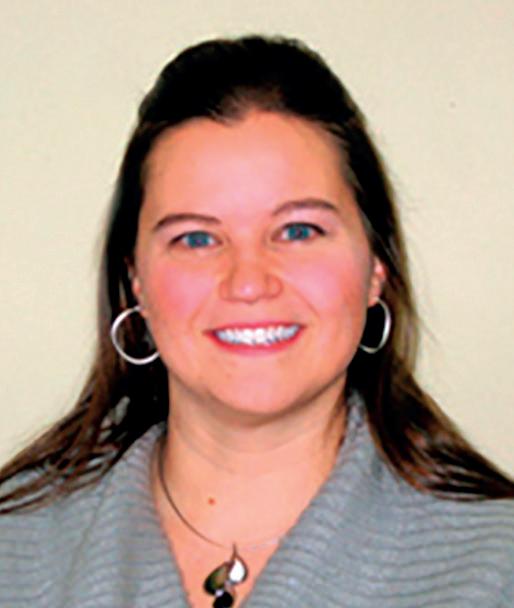
Ms Loeschke explained pure breeders should be ‘concerned’ that in-breeding is higher than it had ever been before and its rate was showing no signs of slowing.
And she said hybrid vigour was as effective as it had ever been due to these high levels of within breed genetic similarity.
She conceded that line breeding, which she described as ‘in-breeding with intent’ was use ful to concentrate desired genes.
She said: “Line breeding is a high-risk, expensive breeding programme to be taken on by genetic companies and you would expect to see more failures than successes.
“In-breeding comes with pure-breeding as selection can become too concentrated.”
She went on to explain that the consequences of reduced genetic
diversity included decreased fitness, expression of genetic defects and reduced additive genetic variance.
She highlighted how the in-breeding co-efficient - the probability that both copies of the same gene variant have been inherited from an ancestor com mon to both the sire and damhad risen in the US Holstein herd in recent years.
“In the US, Holstein females born in 2020 have an in-breed ing coefficient of 8.69% and for females born in 2021, this rose to 9.16%.
“For perspective, a first cousin mating would lead to a in-breed ing coefficient of 6.25%, a full sibling mating 25%, and a sire daughter mating 25%.”
She explained that while the US had an average annual increase in the in-breeding coefficient of 0.26%, this fig ure was 0.12% for Holsteins in Sweden and 0.10% in Denmark. This was, she said, because these
countries were limiting the influence of certain bulls.
Ms Loeschke added that she thought it was ‘crunch time’ for the Holstein breed.
“When the breed population falls below 40 unique individuals then we really are in trouble. We need make sure we are manag ing things so that we do not go down to this level. We have 40 to 50 unique individuals now for Holsteins, whereas some breeds have a figure as high as 75 unique individuals.”
She said this speeding up of in-breeding was important due to its negative financial implications.
“Various research has shown that there is a $25 penalty for every 1% increase in the in-breed ing co-efficient, so for America where the average in-breeding co-efficient is 9.16%, this would lead to a lifetime penalty of $229 or $0.23 per daily over an average herd lifetime of 2.69 years.”
Ms Loeschke said that cross-breeding would help limit the effect of in-breeding depres sion and take advantage of hybrid vigour when distinctively different breeds are crossed.
She added that cross-breeding could be expected to lead to a hybrid vigor of at least 10%.
“I often get asked if a four-breed rotation should be considered. And while the answer could be yes, you do not really gain a lot of hybrid vigour from four breeds, and it can also be difficult to find a complementary fourth breed.
“Three breeds will maximise hybrid vigour.”
When looking at cross-breeding in general, Ms Loeschke advised choosing distinct, pure breeds with sizable populations and progres sive selective programmes.
“Look for breeds that are com plementary in their strengths and weaknesses and only use the high est ranking bulls in each breed.”
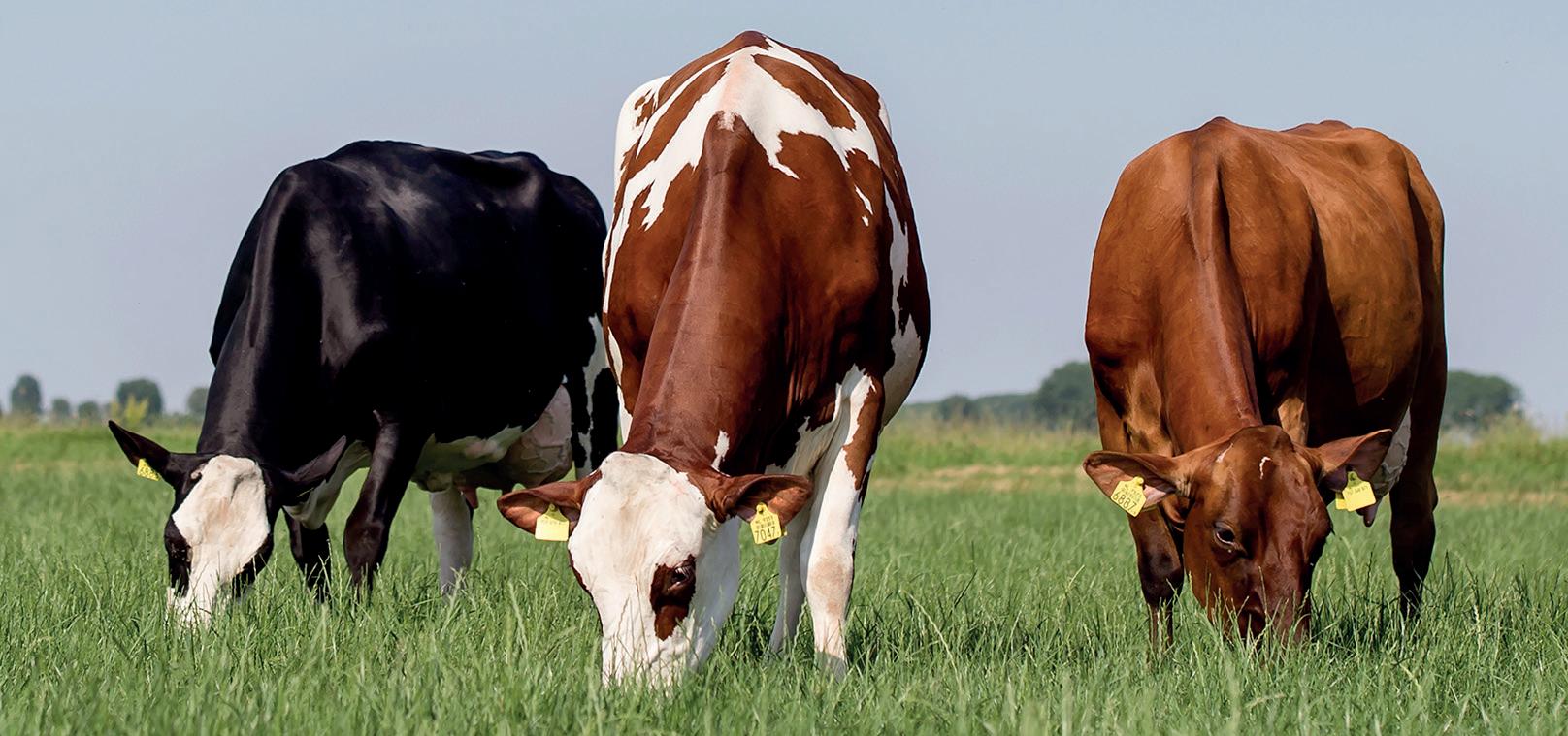

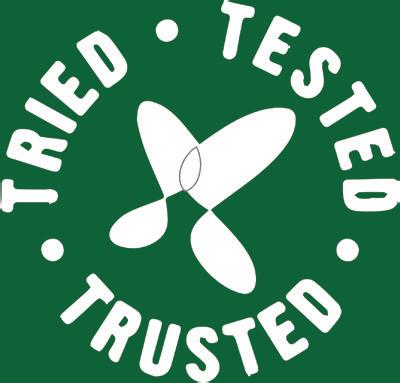


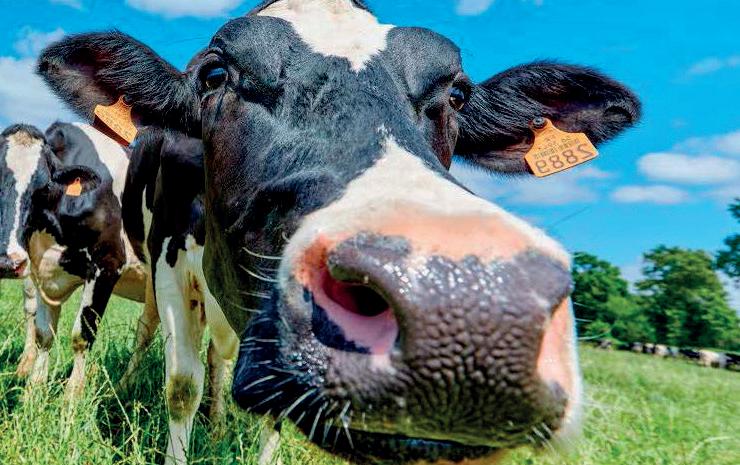







JDairy farmer Peter Cock was an early adopter of the ProCROSS programme after he purchased Viking Red semen for use on his high yielding Holstein herd in 2012.
Back then the cows were averaging at a peak of 12,000 litres on three-times-a-day milking.
He said: “We had a desire to move to tighter calving blocks but found this challenging with the Holsteins.
“When people think of crossbreeding they will often think about spring calving herds of Jersey type cows, producing low value calves.”
However, he said this was not the case with his 600cow herd, which is now 75% cross-bred. “The herd is now averaging 8,300 litres with cows turned out in early March. We have seen a lift a 12 point lift in conception rates, which now stands at about 45%, an improvement in calving interval, vet input is almost nil, and the stillborn rate has halved.”
He said other benefits included an uplift in milk quality from 3.88% butterfat and 3.17% protein at the start of the period of transition, to 4.47% and 3.54% respectively.
JMarket analyst, Chris Walk land, gave some insight into the industry’s current situation and offered a few predictions for the future.
He suggested that while milk prices had been rising, he also thought the situation was ‘top ping out’, and said milk volumes were dropping off at a faster rate than in the previous five years.
“The processors do not like that, they have not got the milk.
“For the first time in years we have got milk recruitment in the UK; that is good for farmers.”
He also said that in the short-term, global milk volumes would be under pressure for the rest of the year due to farm
policy reform, high costs, and environmental pressures.
This he said meant that prices were ‘maxed out’ with buyers and sellers possibly looking at a stand-off.
He said the milk contract refer endum was ‘not good news’ and said the industry should ‘pre pare for bedlam’.
“Since October last year there has been 180 moves across 26 main processors. When it comes to fixed price contracts, one of the countries that pioneered this is Ireland. But now they are begging for mercy.
“We really need to get heads around what might be coming
down the line with contracts. If we get contracts wrong then we are going to be screwed.”
He also said a challenge going forward could be a desire from farmers to produce more milk.
“The big game changer could be farmers turning the tap on if the milk price goes to 50ppl.
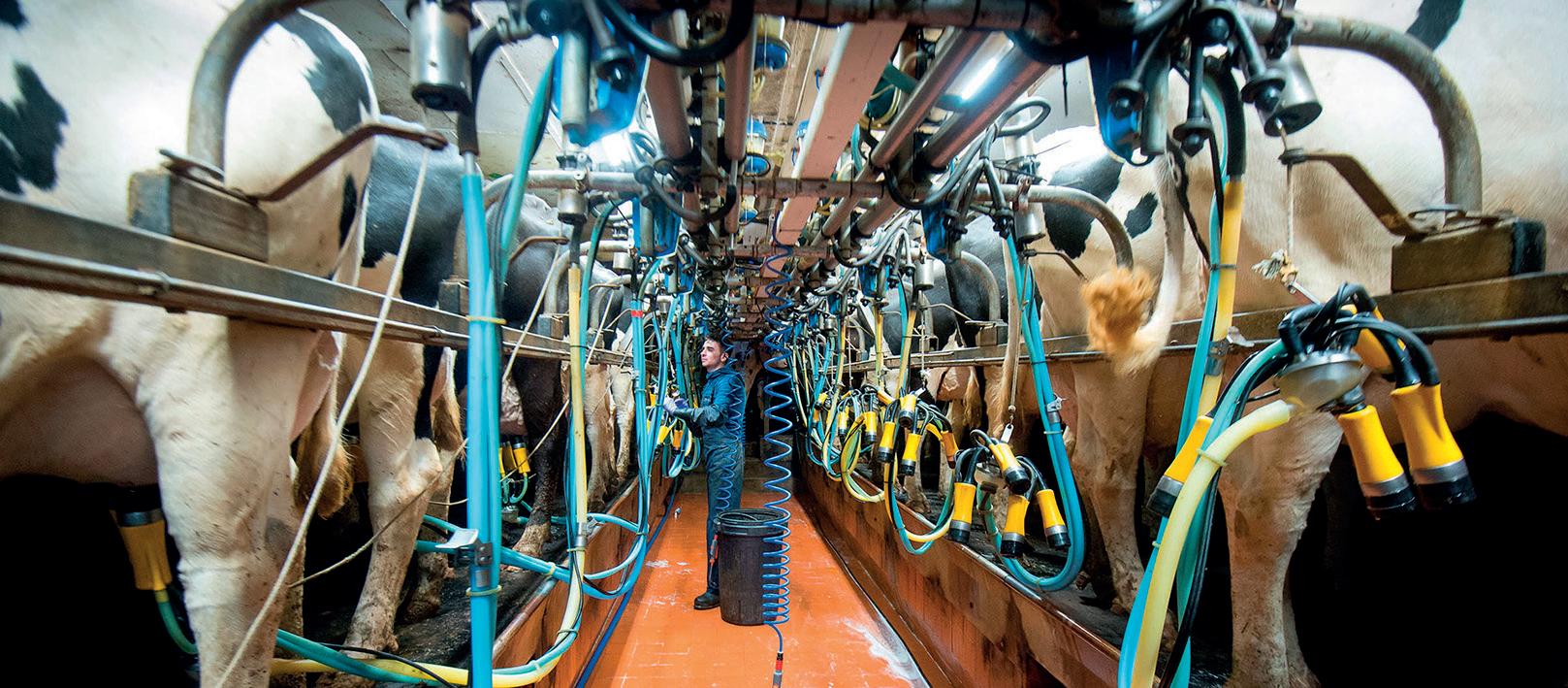
“I understand the dilemma [this move would bring], but it would not be good for the market. How ever, I am not seeing a lot of farm ers wanting to produce more milk, and have not detected a massive exuberance on the part of farmers.
“While farmers are certainly juggling more money than they have before, they are not ac tually making any more money.”
J
The widest ever range of European cattle genetics will be heading to the UK, thanks to a new and intensified relationship between France’s largest breed ing organisation, Innoval, and Germany’s dominant breeding company, MASTERRIND.
Through Innoval’s exporting arm, Evolution International, genetics from up to 65% of the
French market will be sold in the UK through the MASTER RIND subsidiary, Mastergen.
Innoval’s French line-up is dominated by Holstein genetics but also features bloodlines from the Normande, Pie Rouge and Brown Swiss breeds.
Alison Dunphy, managing director of Mastergen, says: “Innoval runs an exceptional
programme of research and development and has one of the largest breeding programmes in the world. It represents 65% of the French market and distrib utes its semen in 70 countries.
“With over 6,000 Holstein males genotyped every year and one of the largest semen sexing laboratories in Europe, we can look forward to the continued
availability of diverse and industry-leading bloodlines.”
Much of the semen from Evolution will be marketed to UK customers by Mastergen it self, but existing routes, through third parties, will also be stepped up. This ensures farm ers committed to working with other breeding companies will have no disruption of supply.









Building a new clamp rather than relying on baled silage can help dairy farmers reduce costs, minimise use of plastic on-farm and lower their carbon footprint signi cantly, according to forage production specialists.
Over a 20-year period, costs of ensiling each tonne of silage would be halved, use of plastic would be nearly 20 times less and associated CO2 production would be reduced by nearly 95%, says Will Wilson, of forage systems specialists ARK Agriculture.

He says: “Modern high oxygen barrier lms combined with the latest technology in clamp building are giving producers a real opportunity to move their forage production forward and make the most e cient use of home-grown feed materials while minimising environmental impacts.
“It is a great example of new technology making established practices signi cantly more e cient and more aligned with processors and consumers’ desires to see farming reduce its carbon footprint.”
He adds that many of the practices producers have relied on are becoming ‘increasingly unacceptable’ in the era of more sustainable production and he says excessive plastic use is just one of those.
Looking at the construction of a 10-metre by 45m by 3m clamp
Developments in silage clamp construction and coverings are increasing the efficiency of silage production significantly while minimising waste and the associated carbon footprint of milk production. Dairy Farmer reports.

reveals some interesting comparisons to baled silage, he says.
“Such a clamp is going to cost about £80,000 to build and, at 0.7t/ cu.m, it will hold about 1,000t of grass silage, so every 1t stored costs about £80 in build costs. Over 10 years, that is going to be £8/t stored and, over 20 years, it will be £4/t.
“Wrapping a 700kg bale including contractor charges is about £7/bale, which equates to about £10/t – signi cantly more than the £8/t over the rst 10 years of the newly built clamp.
“Over a 20-year period, well within the serviceable life of a modern silage clamp, you will be storing your silage for much less than the same operation using big bales.” e numbers get even more
a ractive when you factor in plastic use, says Lucy Johnson, of silage lm specialists Silostop.

“You should be able to cover 22 x 700kg bales with six layers of lm for every 24kg roll of wrap, so that is about 1.09kg of plastic per bale or 1.54kg/t; 1,000t of wrapped bales will require 1,540kg of plastic per year, costing about £4,500/year at £75/roll.

“Looking at the clamp situation, a roll of 50m orange high oxygen barrier lm weighing 26kg will cover our 1,000t of clamped silage.
“Side wall lm will add a further 44kg, so that is 70kg.
“You will also need two 12m anti-UV covers weighing 120kg in total, but these will last for six years, so that is 20kg/year of plastic.
“ is is a total of 90kg of plastic used to produced 1,000t of forage in a clamped situation, compared to 1,540kg of plastic for the equivalent weight of baled silage – over 17 times more.”
Cost-wise, Ms Johnson says the plastic required for the big bales will cost £4,425/year at £75/roll, whereas the high oxygen barrier lm and covers for the clamp will cost about £870 for 1,000t of silage at current prices.
To clamp 1,000 tonnes of forage, about 90kg of plastic is required, compared to 1,540kg of plastic for the equivalent weight of baled silage.
She says: “Assuming both types of lm require the same amount of energy to produce and release the same amount of greenhouse gases in the production process, the lm will have a carbon footprint about 95% less than for the plastic required for the big bales.”
e numbers associated with clamped silage over the baled equivalent are impressive, but they are not the only advantages, she says.
“ e general direction of travel in dairying is for be er use of resources and proper management of waste, so unnecessary use of big bale silage is contrary to this.
“Bales are normally stored on porous hard-standing or soil, so e uent management is more dicult than with a properly designed and managed clamps.

“Baled silage also takes up more space on the ground as they can only really be stored three-high as a maximum. Even at three high, the bo om bales are compressed and this can allow air ingress and e uent leakage as the wrap moves.
“Baled silage also has more variability in terms of quality and is harder to evaluate for rations unless each separate eld is marked and fed accordingly. Clamped silage has more even quality as the forage is mixed thoroughly during the ensiling process.
“Wrapped bales are very vulnerable to bird damage both in eld and in the stack and do not forget all waste plastic on-farm must now be recycled by law.
“Waste companies do not tend to like bale wrap as it is thin plastic with high contamination levels due to the silage and soil contained, so it can be very expensive to deal with.”

Mr Wilson agrees, saying with
Will Wilson says clamps are as important as any other piece of infrastructure and are critical to the economics of production.
more dairy companies factoring the carbon footprint of the milk they are buying, high energy, high input practices will come under greater scrutiny in the future.
“A farm’s carbon footprint is increasingly being benchmarked by dairies and milk buyers with plastic use guring in these totals more and more. Historically, such things have been fairly low on the agenda for many milk producers, with other important management decisions taking priority.

“ e expansion in herd size over recent years has meant cow accommodation and manure storage have o en been seen as more important than the extra forage storage capacity needed for this, but things are changing.”
Home-grown forage is becoming even more important in the dairy pro tability equation and is seen as one of the most important ways to reduce input costs in the future with poor forage management less tolerated than ever, Mr Wilson says.
“Over lled clamps or poor compaction levels, for example, are not only bad news for cows, they are dangerous to operators and shorten the longevity of the clamps themselves. I think this is being recognised.
“We are de nitely starting to see be er producers realising good clamps are as important as any other piece of infrastructure on-farm and are critical to the economics of production.
“ ey represent a longer term investment than bagged silage, but the return on investment is signi cant and quickly achieved, particularly when used with the newer technology lms which reduce plastic use signi cantly and improve forage quality.
“Add in the tax e ciency of using Capital Allowances for construction and Countryside Stewardship grants available for roo ng silage clamps and I think we are going to see construction of new clamps becoming increasingly popular in the future.”
Sustainable management of inputs and people was the key message of the 2022 Positive Farmers Conference, Cork. Anna Bowen reports.
Changing milking intervals may have positive impacts on farm management and minimal effects on productivity, according to recent research from New Zealand.
Dr Paul Edwards, senior scientist at DairyNZ, explained he had led a trial at Lincoln University in New Zealand where the dairy herd was split into full-time twice-a-day milking, full-time three milkings in two days (three-in-two) and part-season three-in-two milking.
He said the trial showed that full time three-in-two milking resulted
in 5% less milk solids than trad itional twice-a-day milking.
However, he stressed that the drop in production could be offset by investing the time saved.
He asked: “What are you doing with that extra time? If you are spending 25% less time milking, is that time being spent on better farm management which balances out the loss of production or does it help staff have more time off and do a better job when working?”
Further trials looked at varying intervals between milkings in three-in-two systems and found no significant difference in milk solid
production, although protein produc tion decreased and fat increased with a longer interval between milkings.
Dr Edwards and his team have also investigated the sleeping patterns of people working on twice-a-day and three-in-two farms. The trials started recording data before calving.
He said: “After the third week of calving, people on three-in-two milking farms got an average of 27 minutes more sleep per night.
JDifferent approaches to managing stocking rates were explored by dairy farmers Barry Bateman and Mike Birmingham, together with Teagasc research officer Dr Brendan Horan.
Mr Bateman explained he had run high stocking rates to facilitate stocking additional units.
By contract rearing heifers and consolidating on one block, Mr Bateman said he had avoided the increased fuel and labour demands of running off-lying ground.

He explained his 211-cow spring calving herd was managed on 75 hectares (185 acres), utilising 13 tonnes of dry matter (DM)/ha (5.3t DM/acre). The stocking rate had ranged from 1.8 to three livestock units/ha (0.7-1.2 livestock units/acre).
He said: “We will average 2.7 cows/ha to comply with regulations, but in the past we have farmed a higher and lighter stocking rate.
“I enjoy the simple system that we have and financially there is never been a return for stocking heavier than this.”
He added that a lighter stocking rate was not necessarily easier to manage.
He said: “When you have a farm which grows a lot of grass, it can be difficult at a lower stocking rate.”
For Mr Birmingham, an easier life was a key driver for his stocking rate. His 37ha (91-acre) farm is stocked with 96 cows.

He said: “For the past few years we have been stocked at 2.6 cows/ha. This is a lifestyle stocking rate which gives us
time to do things such as watch my daughter’s sports matches and attend discussion group meetings.”
Mr Birmingham said he measured grass twice a week through summer and focused on improving swards through incorporating clover, achieving optimal soil indices and reducing nitrogen applications.
He said that in 2023 he aims to spread less than 200kg N/ha (81kg N/acre) and has already changed his approach to application based on clover content.
Dr Horan commended both farmers. He said: “These farms have done well by matching grass to demand and a really tight calving pattern. Stocking rate is a great tool
for increasing productivity and profitability of dairy farming.”
However, he added there were limits to this.
Dr Horan said: “You can still increase productivity once past the ideal stocking rate, which is where the risk is that profitability does not increase with productivity.
“Higher stocking rates are easier to manage in most cases and can improve pasture quality right through to the mid-season and minimise that drop in sward quality.
“One of the challenges at farm level is that traditionally higher stocking rate has a negative environmental effect.”
In response to this, he said he had seen more farmers embracing clover, especially in light of high fuel and fertiliser prices.
“It might not seem a lot, but when people are ge ing ve hours of sleep a night, it is quite signi cant.
“Milking exibly can help people t work with routines such as school drop-o s. ree-in-two is a fortnightly schedule which does mean you do not know by the day of the

A change in milking intervals could have a positive impact on staff well-being and cow performance.
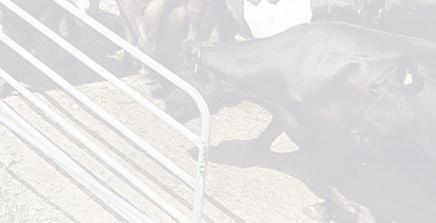



week how many milkings you have, you need to know the week too, which can drive people crazy.”
Dr Edwards concluded by reminding delegates that changing milking frequency needed to be accompanied by other changes, such as allocating dry ma er on a 48-hour rather than 24-hour routine, in order to meet farm objectives.
JThe Economic Breeding Index (EBI) is a valuable tool for dairy farmers but has room for improvement, according to Prof Donagh Berry, research officer at Teagasc.
He said: “I can unequivocally say that no index in the world has been scrutinised scientifically as much as the EBI.”
He added that research had shown that for every unit increase in EBI, net margin increased by €2 per lactation (£1.70/lactation).
Despite some industry questioning of their value, Prof Berry said he was confident in the benefits of genomic bulls.
He said: “Every time we look at it there does not appear to be any systematic issues with genomic evaluation. Some bulls drop and some bulls increase.
“I went back to the year 2014
and broke the animals available down into three groups: genomic bulls; non-genotyped bulls such as stock bulls; and proven bulls. I followed them for the next seven years and only retained animals which had more than 100 progeny in 2022.”
He added that the changes were impacted by a base change in evaluations in 2016 which recalibrated all animals and said there was variability in individual animals, with some genomic bulls plummeting in value. Proven bulls, by their nature, showed half the movement as genomic bulls.
Prof Berry said EBI as an evaluation held its value when checked against anticipated future trends in fixed cow numbers and greenhouse gas emissions, nitrogen restrictions and higher costs.

The dairy farming industry on the Faroe Islands might well be classed as small, but it is still vital for the country’s economy. Chris McCullough reports.


ith just over 1,140 dairy cows on 16 farms producing milk for 53,800 people, the dairy industry on the Faroe Islands is quite a vital sector.
Looking at a map, the Faroes are located halfway between Iceland and Norway, north west of Scotland, and extend to 1,400sq.km in size.
Faroe Islands is one of the three constituent countries which form the Kingdom of Denmark, along with Denmark and Greenland.
Aside from the shing industry there, which is by far the biggest in terms of food production, dairying, sheep farming and vegetable growing, are the main agricultural sectors.
Due to challenging climatic conditions, soil types and eld structures, most of the dairy cows on the Faroes are kept indoors.
One of the more modern farms
Wis owned by business partners
Roi Absalonsen, Nils Absalonsen and Esmar Sorensen, based at Vioareioi, in the north of the island.
Dairying has been a traditional enterprise on this farm for hundreds of years, but as Roi says, there have been major changes there in recent years.
Roi says: “We milk 120 cows which are yielding 32 litres per day on average at 4.2% bu erfat and 3.45% protein.
“ e milk is sold to MBM, the only dairy processor on the Faroe Islands. Our current price we receive for the milk is about seven Danish Krones or 94 euro cents per litre.
“Cows are being milked an average of 2.8 times per day through our two DeLaval VMS300 robots, with 60 cows grouped to each robot.”
Looking back at the history of the farm’s infrastructure, Roi’s grandad
built a new barn there in 1980. Roi’s uncle and business partner Nils took over the farm in 1987 and continued to milk cows.
However, with a restructured ownership, the trio decided to heavily invest in the farm and built a new barn for the cows in 2019. at was not the only investment required though, as extra quota needed to be purchased to increase cow numbers.
Roi says: “In total, we have about 60 hectares here on our farm and we manage to buy or rent another 5ha each year.
“Our cows are kept indoors all year long, but youngstock graze outdoors during summer from June to September.
“Nils, Esmar and myself rst drew up the plans to build a new barn in 2013. At that time, Nils had 212,000 litres of quota, so we bought another 320,000 litres that same year.
“With more quota purchased in

2019, we now have a total of 1.3 million litres to work with each year.”
Most of the cows in the herd are Holstein Friesians, plus there are a number of Norwegian Red cows. Arti cial insemindation is used across the herd.
e Faroe Islands has a quite mild climate, with temperatures dropping to 3degC or 4degC in winter. Summer days are mostly overcast with temperatures never really ge ing
Dairy industry in the Faroe Islands
rThe Faroe Islands are almost self-sufficient in dairy products, with the exception of cheese
rOver the past 10 years, milk production on the islands has increased by 10%, but the number of farms including dairy cattle has fallen from 28 farms in 2012 to 16 farms in 2021
rStatistics show that in 2012, the Faroe Islands produced 6.8 million litres of milk from 1,138 cows; this compares to 7.5m litres produced from 1,147 cows in 2021
rDue to advances in breeding, the average yield has also increased from 6,000 litres per cow in 2012 to 6,600 litres in 2021
15degC and
island


210 rainy or snowy
With this in mind, dairy farmers tend to keep their cows in during the year to avoid damaging the soils. Forage is transported into the









































cow barn all summer and silage is fed in winter via a robotic feeding system.
Roi says: “We feed cows with a robotic TKS system, which is a Norwegian system. e robot is set to feed the cows eight to 10 times per day. ey are being fed grass and silage as well as mash




from the local brewery, plus concentrated feed.”
One of the main problems associated with dairy farming on the Faroe Islands is the lack of a slaughterhouse, therefore there is nowhere to kill cull cows.
Roi says: “This is a job we must take on ourselves. We slaughter older cows ourselves and sell the meat to the public, just like door to door selling. It is a tedious task, but it has to be done.”
Looking to the future, Roi and his
business partners have a goal to expand their milk production keeping a close eye on new technology.




He says: “We have invested heavily to reduce labour in the new barn with the milking robots and the robotic feeding system. At the moment we have ca le in a barn in a di erent location, so in the future we would like to extend the barn so we can house all ca le under one roof.”
For




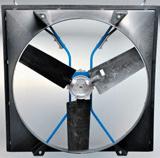
Quality not quantity was the recipe for success for one regenerative cheese producer speaking at Groundswell, Hertfordshire. Chloe Palmer reports.


Moving away from the ‘treadmill of production’ towards producing an artisan, more nutritious product with a strong story is the way forward, according to several high pro le regenerative cheese producers and retailers speaking at this year’s Groundswell event.
Jonny Crickmore, of Fen Farm Dairy, Su olk, admi ed he ‘sleepwalked into pushing for a high yielding cow’ before he decided he wanted to do ‘something di erent’. A er looking at other business models, he realised ‘the value was in the tank’.
He said: “We considered what else we could do with our milk and set out on a mission to make our cheese. A er nine years, we are using most of the milk we produce from our Montebeliarde cows to produce our cheese, which is entirely consistent and sells across the UK.
“While developing our product we visited cheesemakers across the UK and France and realised the farmers who make good
cheese allow animals to graze on pastures which are diverse.
“ ey do not encourage cows to produce too much milk and we could see the way we farm in uences the quality of the cheese we make.
“For us, growing good quality grass silage and cu ing grass more frequently has allowed us to save £40,000 in concentrate costs and prevented our cows from becoming too fat.
“We are now direct sowing plantains and clovers into our grass leys and growing almost everything we feed. We are using less fertiliser and are now noticing a range of di erent plants growing in our swards.”
He added that he used spreadsheets to record data on everything he was doing, which showed although milk yield reduced, the quality of milk increased.
Mr Crickmore said: “We have taken control of our business and we are in a very strong position.


“I do not really need my milk buyer anymore.”
Clare Hill, regenerative agriculture director at FAI Farms and consultant supporting farms adopting regenerative agricultural methods, said the dominance of ‘yield-based models’ in dairying ran contrary to a regenerative approach.
She said: “Some milk processors are o ering 1ppl for regenerative practices, but this still incentivises production. Milk contracts and borrowing are based on high yields, so everything needs to support this, meaning inputs have to increase.
“If we are looking to scale up regenerative agriculture, it cannot be done top down as it is a bottom up approach. Regenerative agriculture is difficult to standardise and categorise, because it is a grass roots movement, so no-one can control it.”
James Ru er, of Paxton and Whit eld Cheesemongers, agreed and suggested regenerative cheesemaking should not be about a brand or a sticker, rather it should be a ‘process, a force for good’.

We are noticing a range of different plants growing in our swards
JONNY CRICKMORE

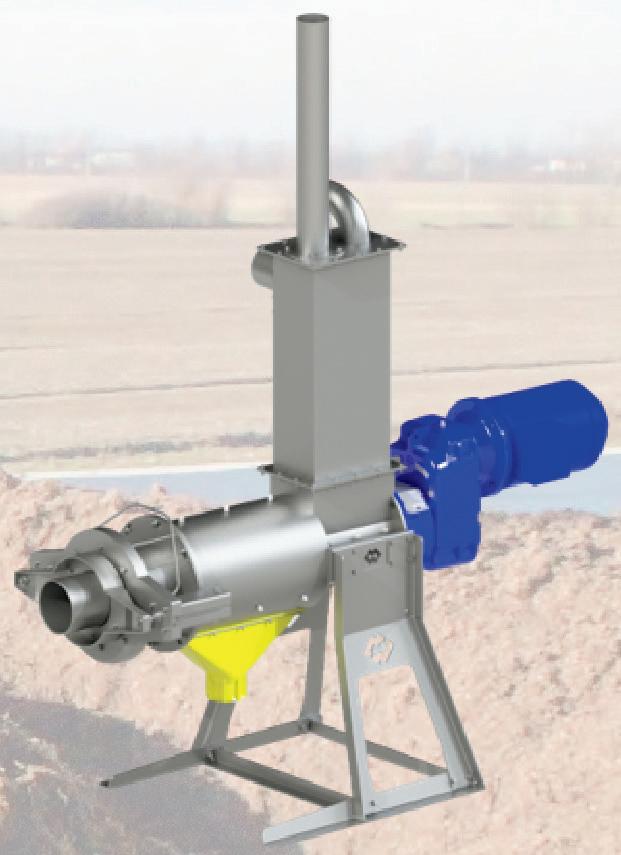
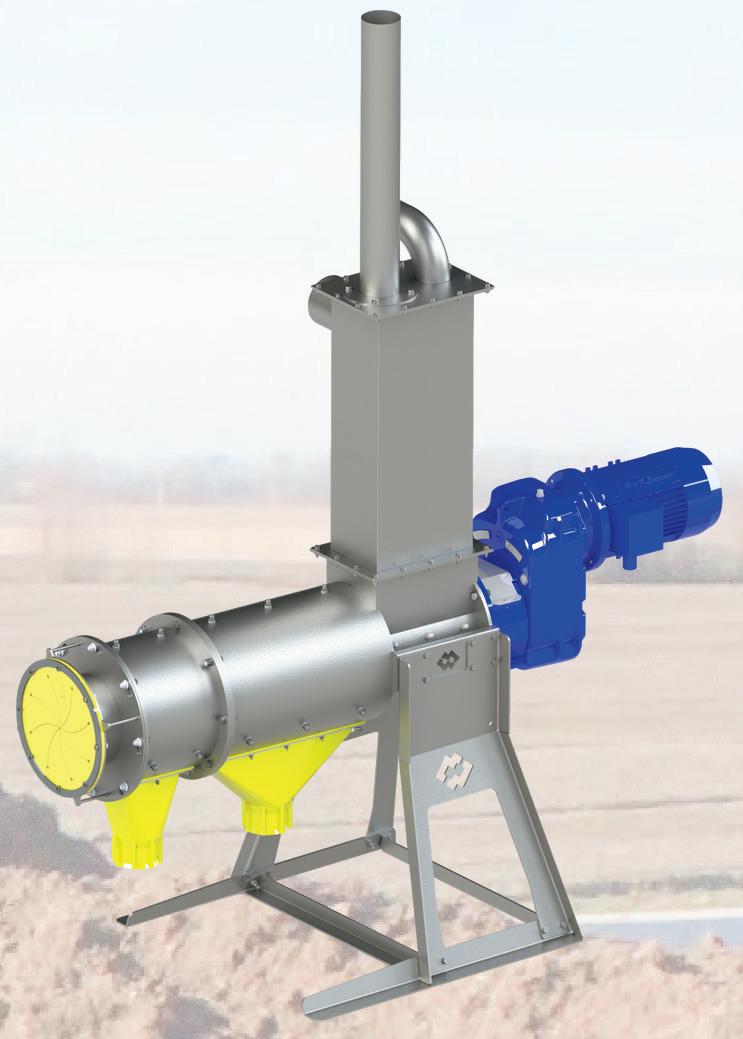


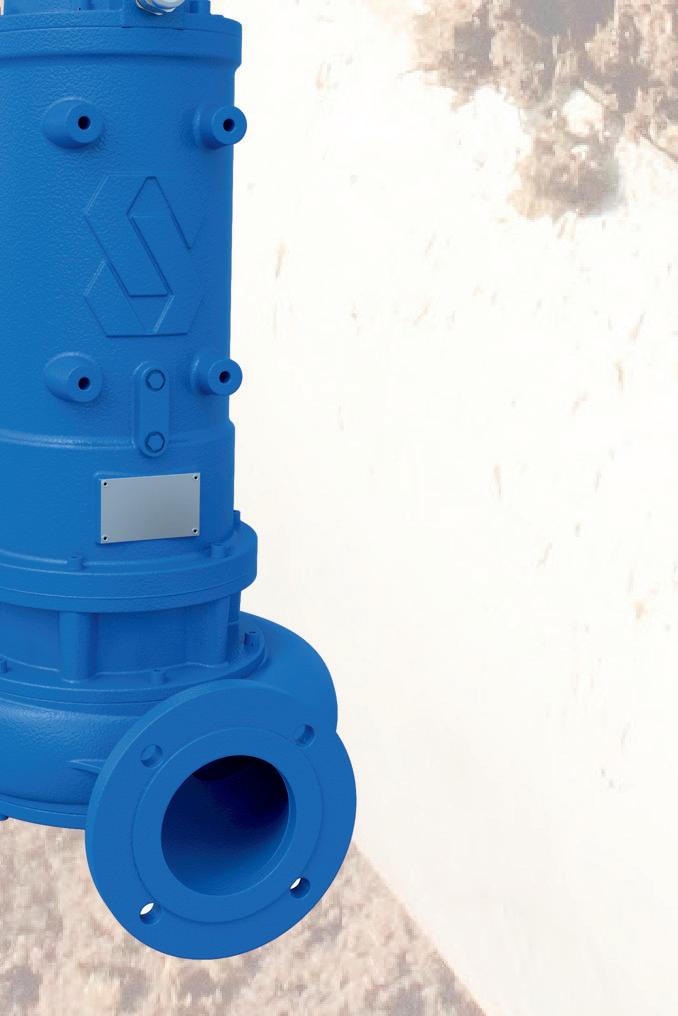



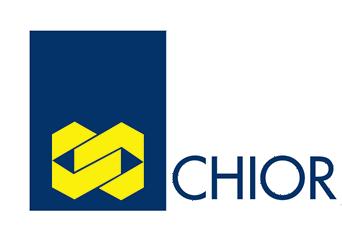











The theme for this year’s Gold Cup Open Day, hosted by the 2020 winners – the Torrance family, Albyns Farm, Essex – was ‘the road to net zero’. Sarah Alderton finds out more.

The Torrances are milking 685 cows with just over 500 followers and are breeding for lifetime production and feed e ciency. ey are yielding 13,100 litres on three times a day milking with 58 100-tonne cows in the herd.
All heifers are genomically tested at birth and anything with a Pro table Lifetime Index (£PLI) under 485 is served straight to beef. eir top £PLI animal currently stands at 811.
eir breeding outlook changed in the late 2000s when they joined a discussion group and switched to breeding smaller, more functional cows which were easier to maintain. eir continual selection of £PLI for the last eight years instead of the Holstein Index has resulted in longer living, healthier animals, explained Liam Healy, GB genetic service manager for Genus.
At the same time, the family also invested in a sand-based 360-cow shed and slurry system, which was replicated two years later with a dry-cow shed, eradicating the need for antibiotic dry cow therapy.
ey have not used intramammary antibiotics in 24 months, opting only for teat sealants at drying o . eir success lies with breeding a herd ranked in the top 1% on £PLI managed in a system that allows cows to exhibit their genetic potential.
Speaking at the open day, Christine Pedersen from e Dairy Group, said: “ e things that make a pro table herd are the things that also help reduce emissions.
“John is breeding a herd in the top 1% on £PLI and health, welfare and fertility go hand in hand.
“He is achieving a pregnancy rate of 29%, which shows you can have high-performing cows and good fertility.”
Ms Pedersen explained how, unlike many milk producers, Mr
Torrance had moved away from targeting milk from forage, with only 30% of the milking cow ration made up of grass.
She explained: “When John looked at the opportunity costs for growing grass compared to wheat, forage was expensive. Instead, he uses multiple co-products, which in turn, is also helping reduce his carbon footprint.”
Milking cows are fed a maintenance (M) +45 litre ration total mix ration and later in lactation move onto a M+40 litre ration and M +35 litre ration. Maize makes up the majority of the ration (21-22kg a head a day), with three co-products also included – brewer’s grains (5-10kg/head/day), potato chips (4.5-7kg/head/day) and citrus pulp (4-6.5kg/head/day).
Straights are also included. e target is to aim for a dry ma er intake of 26kg/head/day containing 16% protein.
Co-product feeding helps reduce the carbon footprint of the farm, which currently stands at less than 900g of CO2 equivalent per kg of fat and protein corrected milk produced.
Emily Keep, UK head nutritionist at Duynie UK, said co-products o ered a solution to reduce feed
costs and carbon footprint and remove soya from the diet.
“Co-products replace crops grown on land with products harvested from the surplus in the human food chain. is reduces the land required per kg of milk and meat in any livestock enterprise.
“You can not get net zero without addressing feed carbon. Co-products are virtually all very low carbon plant-based products, as the primary product used in the human food chain takes responsibility for the carbon.
“John is using co-products to reduce his reliance on wheat; on top of that, they are highly palatable and nutritious, so help drive intakes.”
Ge ing cows eating and digesting their food relies on well thought-out accommodation in this housed herd. Ideally, cows should eat or lie down for more than 20 hours a day.
Cows at Albyns Farm are housed on 5in-deep sand beds, each 3.9 feet (1.2 metres) wide and 8.2 (2.5m) long, with a fallen curb at the back of each cubicle and a gradient of between 1-2% on the oor. is allows muck to drain
easily to the centre of the building, helping keep cows clean.
Tim McKendrick from e Dairy Group explained how sand was the most ‘forgiving’ bedding for cows.
“Cows are most comfortable on sand and are not fearful of it as they have grip when standing.
“You can see that the cows always lie straight on this farm, which is what you want.”
e passageways have a parallel groove imprinted to prevent slipping and rubber mats at the feed fence. is herd’s outcomes are a testament to the Torrance family’s building design and management.
Mr McKendrick added:
“ e best way to measure if a housing design is successful is by the outcomes, such as mastitis rates, mobility, fertility and somatic cell counts.”
Mr Torrance and his team are constantly monitoring cow performance through Cow Manager and assessing their body condition every month. is ensures cows dry o and maintain the target body condition score through the dry period and into lactation.
r
Entries for the 2022 Gold Cup are now open. Visit rabdf.co.uk/ gold-cup-comp








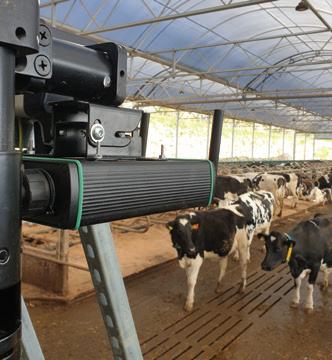








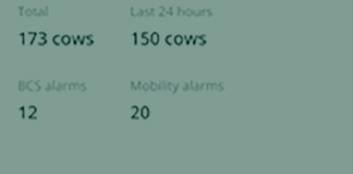



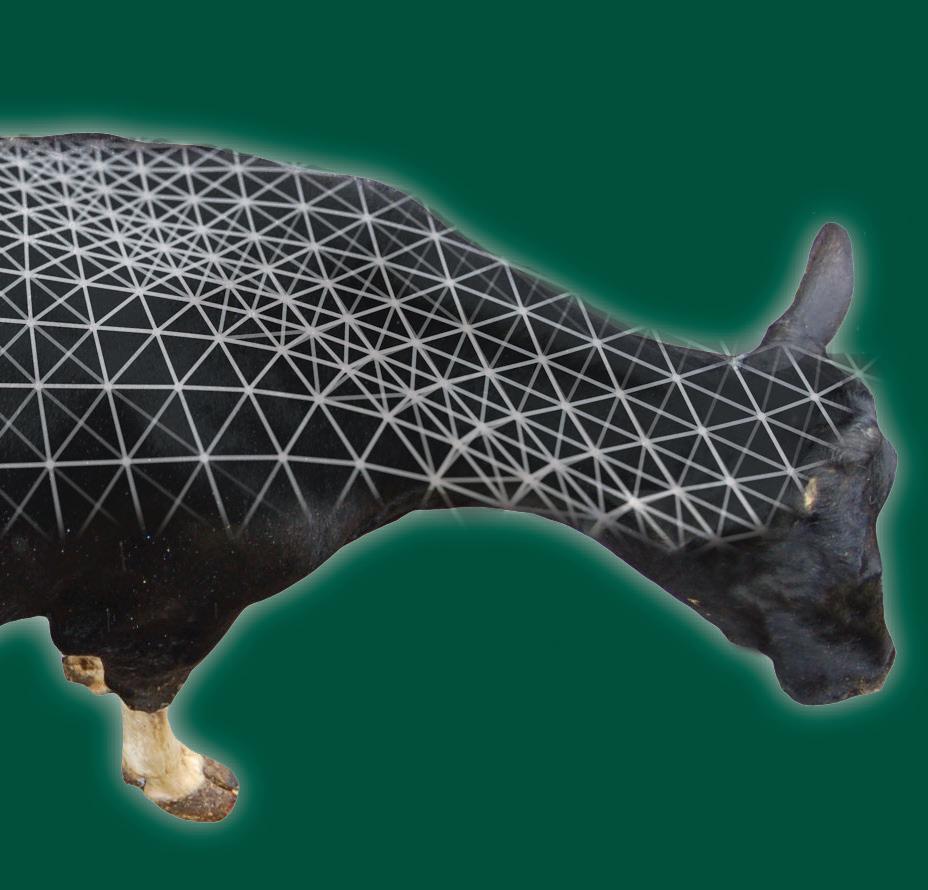












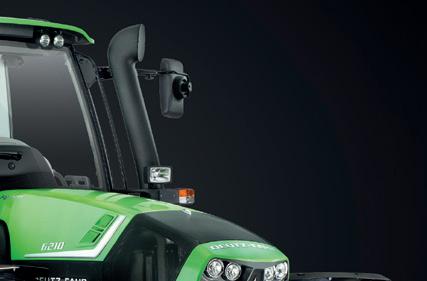






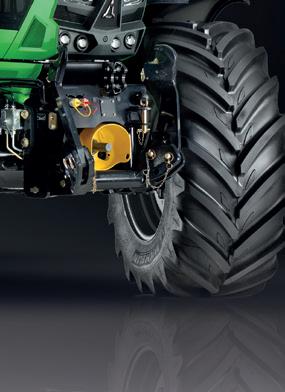


















A Leicestershire farm which generates 85% of its power requirements from a wind turbine has recently been announced as winner of a sustainability award. Jonathan Wheeler reports.

Three generations of the Hunt family run an 80 strong mixed breed dairy herd on 138 hectares (340 acres) of grassland at Buckwell Lodge farm, near Lutterworth, with the business converting to organic production last year.
They were recently announced as a 2022 winner of the VetPartners Sustainability Dairy Award, with the competition judges praising the family for its commitment to sustainable production and engage ment with the local community.
Alba Moran, from Cross Country Farm Vets, which is part of the Vet Partners group, says: “The Hunts are an obvious choice for the award because the family has always put sus tainability at the root of how it farms.
“They prioritise soil health, the strategic use of wormers and genetics, generate 85% of their electricity using a wind turbine and engage with the local community by running farm tours.”
The family has been at the farm since 1939, initially as tenants before buying it in 1953.
They have never shied away from making bold decisions and changing what they do, the latest being the switch to organic production.
This was a logical move, says Marcus Hunt, who farms with his father David and son Sam.
Marcus says: “Basically, we
had been farming organically for about 15 years, but without being fully certified. The change has not been much of a shock to us.
“We felt we were not really getting the results we wanted from chucking fertiliser about. For the first couple of years, grass growth reduced a little bit, but it recovered and now we seem to have just as much grass as everyone else in autumn.
“We might not have as much as others in spring, but we still have enough – 1,600-1,800 tonnes – to fill the silage clamp every year.”
Rather than use nitrogen, they apply nitrogen fixing bacteria when the soil has warmed up in spring.
Marcus says: “We have always worked to get our soils right. In the past we used quite a lot of lime, minerals and trace elements, but now they are in balance.
“As a result, we have not used any nitrogen for 12 years and are concentrating on maximising the contribution made by the clover.”
To boost forage supplies, the family has started to use mixed swards which combine red and white clover, chicory and plantains, with Timothy and ryegrass.
With such a high reliance on grazing and grass silage, they had to have cattle which suited the sys tem and have moved to a three-way cross of Fleckvieh, Norwegian Red and Normande.
That move coincided with a decision to replace a conventional parlour with milking robots as the family aimed to reduce the time and work taken to run the unit.
Sam says: “We had been milking our Meuse Rhine Issel cows through
a 6:12 herringbone that was 30 years old and needed replacing. They were all quite big animals and had outgrown the parlour.
“We noticed they also tended to have low slung udders which would have made it difficult for them to use the robots.”
The family did some careful research before buying the first robot.
Sam adds: “We had to travel quite some distance to do that 10 years ago. We could see that it would also prevent cows standing around for three hours for milking. It just made sense.”
The first robot was built into a new cubicle building in 2010 and triggered wider changes, says Sam.
“We had to think about how we managed the herd and calves and how we organised the grazing. Because we are not in the parlour for so many hours every day, it gave us a chance to think about how we moved the farm forward and properly looked after the cows.
“When we put the first robot in,
The 50kW wind turbine, erected in 2015, provides 85% of the farms electricity.
rCurrently some sexed Norwegian Red semen is being used to build numbers, with the target being a 100-cow fully closed herd rLast autumn, a select few cows were inseminated with Wagyu semen
rAt housing, hygiene is maintained by the robotic sweepers, which apply a probiotic spray as they work rCows also receive a spray
of the treatment to all four feet and their udder as they leave the milking robot
rThe VetPartners dairy sustainability award recognises the adoption of innovative approaches to farming, which benefit the environment and community, as well as making good business sense; Buckwell Lodge was one of three finalists for the award
Once we had explained how the power would be used on-farm, they realised how beneficial it would be
MARCUS HUNT
we always planned to add a second, because 70-80 cows was too many for a single robot and we have plans to expand the herd to 100 head.
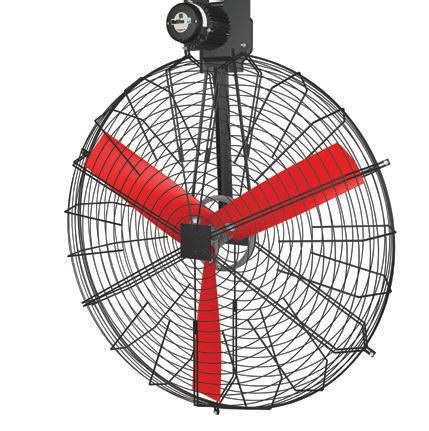
“ e second shed, which we put up in 2021, is larger than the rst. We increased passage width from 4.5 metres to 5.5m, so cows have more space to move.”
Giving the ca le more room provided an instant bene t, Sam says.

“We noticed we were ge ing more milk from the same number of animals and heifers especially seemed to bene t and yield be er.
“ e older cows occupy one
half of the shed and the younger ones and heifers the other half.”
Separating the two halves reduces bullying. Farm records show the cows visit the robots on average 3.2 times a day and the heifers 3.4 times/day, with heifer yields being noticeably higher since the system was installed.


Yields now average 6,500-7,000 litres/head at 4.3% bu erfat and 3.65% protein, with milk going to Arla.
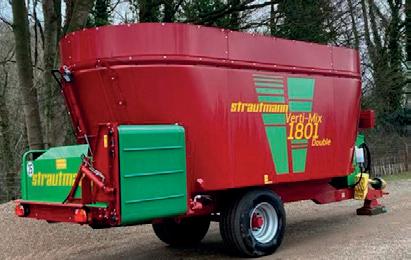
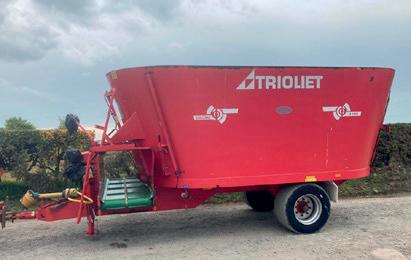
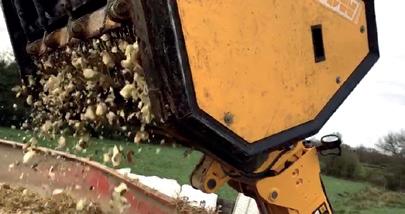

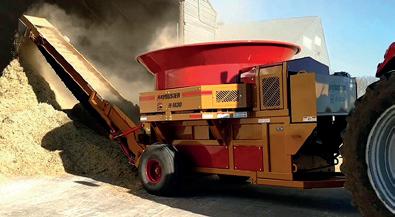

eir current three-way cross suits their system well, says Marcus. “We are looking for a wellbuilt cow. We get the height of the Fleckvieh, the milking quality of the



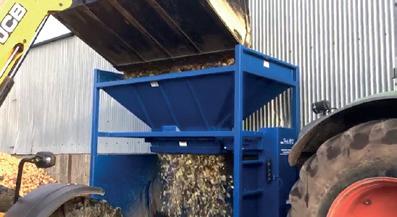
Norwegian Red and the bee ng contribution from the Normande.”
at last trait is important as the beef from their 24-month-old nished animals goes via APB to Marks & Spencer and Sainsbury’s.
In addition, they add more bee ng quality by using British Blue semen on selected older cows.
Good hygiene extends right across the farm, with careful pasture management meaning they have not used wormers for three years because they have broken the parasites’ life cycle.
Marcus says: “We do still use Huskvac and other routine vaccines, but by moving ca le regularly we avoid other diseases and problems.”
Cows calve outside from May through to September, which minimises disease risks.
Calves are reared in suckled groups. From every group of four cows they select one which acts as a nursing mother to her own and three other calves, while the other cows enter the milking herd.
e nursing mother rears the calves outside for 14 weeks before weaning them o and entering the milking herd herself.
Sam says: “We have had a couple of cows join the milkers a er this
To help stop cow walkways becoming waterlogged, the Hunts are experimenting with planting willow strips besides them.

period and instantly start to yield 40 litres milk/day, while also ge ing back in-calf very easily.”
e herd is housed for as short a period as they can manage, typically November to March, despite the farm being on the sort of heavy Leicestershire clays which typically necessitates far longer housing periods.

Pastures are laid out in a radial pa ern from a central hub, on which the water trough for that
eld is located, and from which woodchip surfaced walkways lead to the farmstead and milking robots.

To avoid the risk of tracks becoming waterlogged, they are experimenting with planting willow strips beside them.
Willow roots are notorious for blocking eld drains, but in this situation they o er a double bene t, says Marcus. Firstly they
Pastures are laid out in a radial pattern from a central hub.
soak up a lot of moisture and help ensure the tracks lie drier than they otherwise would.
Secondly, the Hunts intend to coppice the plantations every few years, using the woodchip to top up the walkways.
Towering over everything is their 50kW wind turbine, erected in 2015.
While it originally alienated local people, to the extent that the parish council objected to it at rst, it provided the perfect medium through which to connect with the community.
Marcus says: “We went out and talked about the plans with all our neighbours and hosted a number of farm walks. Once we had explained how the power would be used on-farm, they realised how bene cial it would be and people accepted it.”
Hosting those farm walks got them into the habit and they now run regular farm tours, including one for a vegan group.
Sam says: “I do not know if we converted any of them to meat eating overnight, but they did seem really interested in what we do and how we treat our ca le.
“We issued an open invite for people to visit us a er the recent Panorama programme. We want to show we have absolutely nothing to hide and invite them to come and see what we do.”

CRV UK is part of one of the largest, most progressive international cattle breeding companies in the world. CRV’s products and services are marketed worldwide in more than 60 countries to 60,000 customers, primarily dairy and beef farmers.
CRV has invested heavily to continuously develop its own Global breeding programmes for Holstein, Red & White Holstein, Fleckvieh, NZ Grazing, Jersey, MRI, and Beef sires CRV distinguishes through innovative genetics and data solutions in Health and Efficiency, being a leader in Feed Efficiency.
Tasks and responsibilities
As a Breeding Sales Advisor for CRV UK you are a real business developer: you are responsible for all aspects of your area, finding new customers and developing long lasting relationships. You have access to all CRV technology support tools, SireMatch (mating program), HOGO (genomic testing) and Ovalert (heat and health monitoring). Providing farmers professional, actual, real-world solutions for their own individual farms.


You are operating independently in your region and are challenged to reach your sales targets. Profile of the ideal candidate


We are looking for smart, energetic, independent, entrepreneurial and result driven people with a real love of all things dairy. You have great people skills, an understanding of bovine genetics and an ethical approach to doing business. Whilst a driving licence is essential, a clean one is desirable.
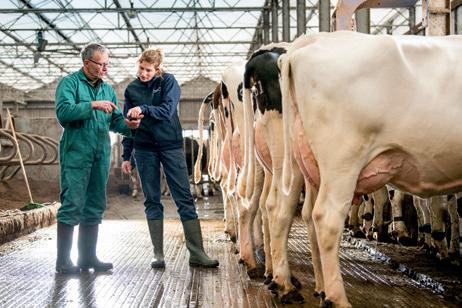

This is a full time, home based role with 25 days annual leave plus bank holidays. Salary and package will be dependent upon previous experience and knowledge base.
CRV has daughter companies in twelve countries, so there are potentially international career development possibilities.
If you are that enthusiastic, motivated and customer focused Breeding Sales Advisor, we would like to meet you! Send us a copy of your latest CV (in complete confidence), a little bit about you and where you want your successful career to head. You can send it directly to us: claire.johnson@crv4all.co.uk
With large
Heifers are a dairy herd’s future, which makes them the most valuable animals on-farm.
And achieving an age at rst calving of 24 months for heifers is a good target for lifetime yield, longevity and individual lactation, says Jimmy Goldie, chief technical o cer at Carrs Billington.
Ge ing dry cow management right ensures the best colostrum for the calf.
He says: “ e rst 24 hours of a calf’s life determines the rest of its life. It should be fed the equivalent of 10% of its body weight in colostrum in the rst six hours.”
Get clean, good quality colostrum into the calf as quickly as possible, says Mr Goldie.
“Quality is important. Make sure to monitor the quality to ensure it is up to standard. It is not necessary
Calves require a daily rate of 0.8kg for Holsteins and 0.65kg for Jerseys to hit body weight targets for bulling at 13-15 months.
main herd
stage.
Rearing correctly is in the best interest of farmers, as it directly affects the future of the herd. So how can producers get it right? Ruth Wills reports.
to sample every batch, but knowing the general colostrum quality in the herd is important.”
A er colostrum, look into milk replacers or whole milk, he says.
“Given that the price of milk replacer has gone up quite signi cantly, some farmers have been looking into giving whole milk instead.”
Mr Goldie suggests working out what o ers the best value between milk replacer and whole milk.
“Consider the consistency of
quality given to calves on a daily basis.”
If using milk replacer, whether mixed by hand or machine, ensure the correct ratios are followed.
“Make sure the calves are ge ing the correct amount of milk powder.”
He also says producers should get hard feed or concentrates and water in front of the calves as soon as possible to aid with rumen development (see p50-51 for more on this).
Choose a pellet which o ers a
balance between bre and protein, says Mr Goldie.
“Something too starchy will cause acidosis, but good nutrition is needed. About 18% protein is su cient.”

He recommends o ering straw to help develop the rumen.
“Although straw has the lowest nutrient value of forages, it is be er for the calf, as at that age it cannot digest haylage or silage.
“If they are o ered straw, they actually do not eat much of it, but it is su cient to allow the rumen to start developing.”
Ensuring access to water is also important, as the rumen needs water alongside forage to aid development.
Mr Goldie says: “Calves are fed milk and because of the oesophageal groove which by-passes the rumen and goes straight to the small intestine, but water goes into the rumen.”
JCurrently, feeding concentrates, forage and straw to achieve growth rates of 0.8kg/day for a Holstein to calve at 24 months would cost about £2/calf/day at the rearing stage, says Mr Goldie.
He says: “The argument at

If aiming to calve at 22-24 months, heifers must reach their target body weight for bulling at about 13-15 months.
“ ey should reach 55-60% of their adult body weight by 13-15 months,” says Mr Goldie.
“To achieve this, they need a growth rate of 0.8kg/day for a Holstein and 0.65kg/day for a Jersey.”
e rst stage of life is important in that process. “A healthy calf should be weaned at double its birth weight at eight to 10 weeks of age.”


It is important calves are weaned gradually. “ is will allow the animal to adapt: a 10- to 14-day weaning period is recommended. Increasing the intake of concentrates alongside access to water is key to ensuring their weight does not change.”
Producers should also ensure minimal exposure to health risks at weaning.

He says: “ is includes keeping the environment clean and dry with good ventilation. It also links back to having a good immune system from the colostrum.”
Also, avoid stresses at weaning, such as moving or dehorning, as this can cause a drop in weight.

e next step is moving from a starter pellet to a rearing pellet.
Mr Goldie says: “Ensure these have su cient energy and protein balance to achieve required growth rates. Protein in the whole diet needs to be about 15% on a dry ma er basis to promote muscle and bone growth.”

rThe calf should be fed 10% of its body weight in colostrum in the first six hours

rEvaluate whole milk versus milk replacer in terms of quality, cost and consistency
rWater and straw will aid rumen development

rCalves should reach 55%
of their adult body weight by 13-15 months
rTarget growth rates of 0.8kg/day for a Holstein and 0.65kg/day for a Jersey
rA 10- to 14-day weaning period is recommended


rRearing a Holstein to calve at 24 months costs £2/calf/day

can also be used proactively
support calves and lambs
are potentially at risk of
















infection
if slow to suckle
weaning or feed change
from handling and
in contact with
the moment is that it would be cheaper to rear heifers for longer, so to 28 months of age, which is the national average for age at first calving.
“But in reality, saving 1kg/calf/ day of concentrate will only save 35p/calf/day, but the rearing has

been extended by 100 days. So although feed is more expensive at the moment, it is not worth rearing heifers for longer than necessary. Also consider that more accommodation is needed because there are more animals on-farm.”

therapy.
“We have used Rehydion successfully for many years. It is easy to administer as it can be diluted in milk, which means there is no interruption to milk feeding.”
The first 24 hours of a calf’s life determines the rest of its life
JIMMY GOLDIE
UK dairy farmers are making progress towards better calf colostrum management practices but still need to focus on improved performance monitoring. Katie Jones reports.

Reporting on the results of an early 2022 survey of current colostrum management practices, conducted by MSD Animal Health, the company’s youngstock category product manager Rob Simpson says this latest feedback is particularly encouraging.

He says: “100 years on from the date [1922] that the crucial importance of colostrum was first formally recognised by science, it seems farmers are now making good strides forward in this crucial area and reaping the benefits of improved calf health as a result. That is great news.”
He reminds farmers that the importance of colostrum cannot be over-emphasised.
“In addition to providing immunity against key early life disease threats, fed correctly and in enough quantity, colostrum also helps kickstart sound organ development and a healthy metabolism.
“We also know that a good colostrum intake enables a greater response by the calf to important vaccines up to six to 10 months of age.
“Indeed, the additive impact of sound colostrum feeding protocols and vaccination is the cornerstone
of immunity-led disease prevention.”

The survey results involved feedback from 248 UK dairy farmers representing both all year round and block calving herds.
Questions were designed to draw out current practices relating to the accepted five Qs of best practice colostrum management: Quality, Quantity, Quickly, sQueaky clean and Quantify.
Mr Simpson says: “Asked whether they check the quality of their cow colostrum before storing or feeding it, 49% of respondents said they always check its quality, 25% said sometimes and 26% never.
“Interestingly, when we asked this same question two years ago, 44% of farmers said they never test their colostrum.”
Newborn calves should be fed at least four litres (or 10% of bodyweight) of good quality colostrum within four hours of birth. A further two litres should be given within 12 hours of birth.
Mr Simpson says: “More than 70% of the 248 dairy farmers claimed to be feeding up to four litres, with a further 9% of respondents feeding more than four-and-a-half litres.
“Most seem to be getting it into the calf quickly; more than 75% giving it before the newborn calf is six hours of age and more than 15% within 12 hours of birth.”
He says it is also encouraging that farmers now appreciate the importance of hygiene. This is because the number of bacteria in the colostrum can double every 20 minutes if it is not stored in a fridge or frozen.
“More than 60% of farmers are feeding it within 30 minutes of harvest and another 23% within the hour.”
The final best practice Q relates to quantification and Mr Simpson stresses there is no point investing in better colostrum management and feeding practices if your progress cannot be monitored.
He says: “Failure of passive transfer of antibodies is nearly 14 times higher on farms which do not routinely monitor this goal compared with farms that do.
“However, this latest survey found that 40% of farms never check the transfer of antibodies from colostrum by calf blood analysis. And another 33% only do it in the event of a problem.”
Independent veterinary professional Owen Atkinson says farmers should be checking colostrum antibody absorption routinely.
He says: “Progess has been slow in this area, but now appears to be improving. In 2015, just 3% of farms were blood testing calves but this latest
The survey showed that nearly half of respondents always check the quality of colostrum.
survey suggests more than onequarter of the farms are now working with their vet in this area. That is really encouraging.”
Mr Atkinson says farmers may not be testing for passive transfer as it is perceived to come under the ‘important but less urgent’ category.
He says: “All the focus is on the crisis and there is less focus on less urgent issues. This is why the quantify colostrum management might drop off the radar.”
He adds the farm vet has a role to play in demonstrating the importance of this area as awareness of failure of passive transfer might be low onfarm, despite it requiring minimal time and cost to test for.
Mr Atkinson says best practice is to test 12 calves every three months to check for passive transfer, which he concedes is easier to do on larger farms where there are larger numbers of calves being born at any one time.







Improving hygiene at the calf rearing stage will help dairy farms reduce their cost of production and improve animal health and welfare. Debbie James reports.

Newborn calves have a very limited ability to defend themselves against pathogens in their environment; it is a key reason why a third of heifer replacements on UK dairy farms do not remain in the herd beyond their second lactation.
Consultant Jamie Robertson says even non-pathogenic bugs

come at a cost to a calf’s metabolism since 8% of metabolisable energy (ME) in feed intakes will be used to ght pressure from these.
Mr Robertson says many diseases in young calves are managed be er with good hygiene protocols at this all important phase.
Yet research carried out in conjunction with the Agri-Food and Biosciences Institute (AFBI)
on 66 farms in Northern Ireland has shown that many are failing at this.

Average cleaning frequency of feeding equipment was every two days but was as much as 84 days while on 18% of farms feed buckets are only cleaned when a calf is weaned.
It is a reason why so many milk-fed calves die in the rst four weeks of life as a result of
scours caused by pathogens already present on a farm, says Mr Robertson.
“Many chronic animal health problems can be improved through be er management and design of systems and housing,’’ he says.
“A lot of facilities are extremely hard to clean so for me the answer is that we must make it simpler.’’
An initial intake of 10% of a calf’s bodyweight is recommended within the first two hours, followed by a second feed within six hours of birth.


JProviding calves with enough good-quality colostrum as quickly as possible after birth is a vital first step to reducing losses in the first month of life.
Becca Cavill, veterinary adviser at Boehringer Ingelheim, recommends an initial intake of 10% of a calf’s bodyweight, ideally in the first two hours, followed by a second feed within six hours of birth.


“Colostrum is key to good protection from parasitic diseases including cryptosporidiosis, caused by cryptosporidium infection and one of the most common reasons for calf scour,” she says.
A key area which farmers often overlooked is cleanliness in the calving pen, but this is a potentially major source of pathogens.
“It might take seven days for a calf to show signs of disease therefore farmers often fail to make the connection with the calving pen,” says Ms Cavill.
To minimise exposure to bacteria, ensure this environment is clean and dry.








Dr. Laura Tennant Young Animal Feed Technical Adviser Trouw Nutrition GB
For more details about OsmoFit contact Laura at trouwnutrition.co.uk/osmofit
“Rehydration of calves with OsmoFit is easy and key to maintaining health, performance and growth.”
Colostrum is key to good protection from parasitic diseases
1Remove organic matter before disinfecting Dirt absorbs disinfectant so if a sufficient amount is not removed the chemical will not be as effective since it will be diluted by the presence of organic matter.
Mr Robertson says: “If you leave organic matter around the drinking area for example you are massively reducing the effectiveness of chemicals designed to kill pathogens.”
He advises removing all visible, loose material, physically cleaning with hand tools where needed and when washing out.

He adds: “Using a detergent before the disinfectant will also loosen the biofilm as water alone will not do this.”
2 Use the appropriate product for the job
Mr Robertson says the disinfectant needs to be the right one for the bacterial and viral flora specific to your farm: “If you have crypto or salmonella use a product formulated for tackling these organisms.
“Poultry units are already way ahead of the dairy industry on this. They will only have a couple of disinfectants they use because they will know which ones they need rather than buying a product that is on offer at their local agricultural supply merchant.”
He advises mixing the disinfectant to the right dilution by using a measuring jug and using the product as instructed on the label. “If the advice is that it needs to be left for two hours before washing on then leave it for two hours.
“Instead of sloshing disinfectant around in buckets invest in a dispenser for cleaning pens, they only cost about £25 and they will make
the job easier and the easier a job is the more likely it is to get done correctly.”
And before restocking, Mr Robertson advises allowing pens time to fully dry. “Use a hydrated lime or similar low cost material or a squeegee to aid that process.”
JAMIE ROBERTSONAllow space for emptying pens for cleaning
A lack of space to empty pens for cleaning is a major intrinsic weakness of too many calf systems says Mr Robertson.
“There will be an inevitable build-up of bugs in the environment when buildings are constantly stocked.”
“Steam clean and consider using a gas weeder to clean along the joints between the walls and the floors.”
Feed little and often Too many producers fill a bucket with dry feed and it slowly becomes unclean says Mr Robertson. “The massive benefit of a little fresh feed every day is that the producer can observe the feed intake of every animal.

Do not under-estimate the need for a calf kitchen Mr Robertson says getting the facilities together to make what is an absolutely necessary job better by being slicker and more effective.
He adds: “It will pay for itself and more.”
Adopt strategies for dealing with hard to clean equipment

“Some facilities are not designed with cleaning in mind – a case in point is a teat feeder with internal divisions,” says Mr Robertson.
“To clean these, have two containers which can be filled with a detergent solution and fully submerge the feeders in these once a week before disinfection.”
Pens must have drainage systems
Mr Robertson says three quarters of all pens he sees on farms do not have adequate drains. “So when the pens are cleaned there is nowhere for the water to drain, and there never will be until the floor is changed.
“Establish a curb in between group pens so if one needs to be cleaned the moisture and dirt does not end up getting sloshed into the adjoining ones.”
Facilities must be cleanable
Mr Robertson says the weakest point in many calf facilities are the ‘thousands of tiny cracks’ that provide a resilient home for bugs even after cleaning.
“The joints between walls and the floor are also a source of re-infection.
7 Deep clean annually
A deep clean is recommended by Mr Robertson once a year or after an outbreak of disease that may carry over to the next batch of calves, such as cryptosporidium.
10 Adopt protocols for cleaning milk machines and feed utensils
He advises having clean brushes for cleaning utensils, a measuring jug, detergent and, if needed, disinfectant.
“Rinse with cold water before soaking in a warm detergent solution at 55degC.
Rinse after brushing and wash with a disinfectant at 50degC. Rinse and dry.”
He also says to discard buckets and teats that have too many small fissures and cracks.
A dedicated kitchen area in a calf shed will more than pay for itself, says Jamie Robertson.
The joints between walls and the floor are also a source of re-infection
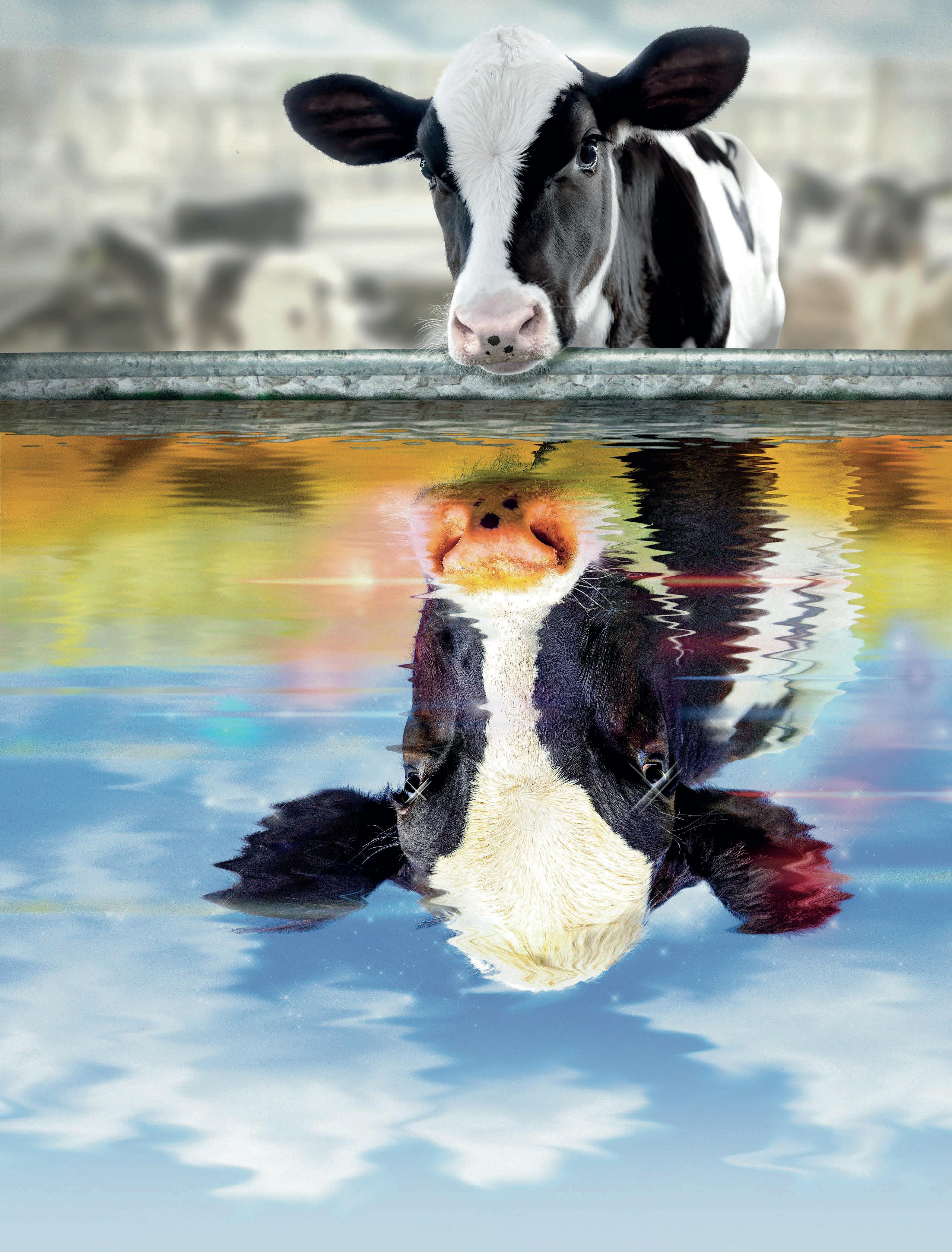

















Efficient heifer rearing and elements of longevity have their foundations in early life nutrition, making this a crucial management stage, says Dr Leonel Leal, team leader calf and heifer research at Trouw Nutrition.
In 2014, Trouw Nutrition launched LifeStart, a science-based programme which focuses on the critical first few months of a dairy calf’s life.
He says that in pre-weaned calves, early life nutrition is a major stimulus and the initial stage of the LifeStart programme was to understand the effects of elevated feeding of milk replacer on calf development, feeding a typical 600g/day of milk replacer compared to an elevated rate of 1.3kg/day of milk replacer.
“This showed calves fed more milk replacer had higher growth rates. At 54 days old, calves fed more milk replacer weighed 83kg, gaining at double the rate of the traditionally fed calves, which weighed 61kg at the same age.”
As calves were meeting more of their appetite requirements from milk, intakes of starter feed were marginally reduced, but starter intakes were still adequate at weaning.
Water intakes were the same in both groups as milk is a feed, not a drink, and calves need water for hydration. Ensuring faster calf growth, exploiting better feed efficiency in pre-weaned animals and getting them off to a good start is a vital first step in heifer rearing.
Previous LifeStart research had shown that calves fed elevated levels of milk replacer had improved development of key organs including mammary tissue. So researchers wanted to see if these benefits were carried forward.
The latest assessment of the cost of rearing a heifer is £1,891. Heifers must complete close to two lactations to cover rearing costs, meaning longevity is key to maximising return on heifer rearing. Dairy Farmer reports.

In the second stage of the trial, groups of calves fed on the two different levels of milk replacer were amalgamated and fed exactly the same diet with no differences in management. They have been followed through into the milking herd to understand how improved pre-weaning nutrition influences productivity, longevity and resilience.
Calves which received more milk replacer retained the weight advantage they had shown at weaning. Heifers were inseminated based on weight,
not age, and were served when they had reached 390kg, equivalent to 60% of mature bodyweight.
Dr Leal says: “Heifers which had been fed elevated levels of milk replacer were four days younger at first service, had a 10% higher conception rate and conceived 10 days sooner. They required fewer services per conception. These heifers were on target to enter the milking herd younger, helping save on total rearing costs. They continued to perform better when they entered the milking herd.
This is the most important data as this is when we can start to see a return on the investment in youngstock rearing.”
Heifers which were fed more milk replacer before weaning produced more fat and protein corrected milk and had higher dry matter intakes. They also had better fertility performance with higher conception rates.
In addition to being better producers, there was a significant effect on survivability through the lactations.
More of the heifers fed increased milk replacer survived in the herd longer. While 76% of these heifers completed lactation two, only 65% of traditionally fed heifers completed their second lactation.
The survival rate of the enhanced fed calves until their fourth calving was significantly improved. While less than 25% of traditionally fed heifers entered a fourth lactation, the figure for heifers fed elevated milk replacer was 40%.






































As scour is the largest cause of mortality in young calves, it is important that the problem is managed as effectively as possible. Katie Fallon looks at the role electrolytes could play in this.
Scour accounts for 50% of all calf deaths and, while calves can recover, they may experience reduced growth, delayed calving and reduced lifetime production as a result, says Dr Graham Shepherd, of G. Shepherd Farm Animal Health.
Both infection and nutritional issues can cause calf scour, says Dr Shepherd, with diseases such as rotavirus and cryptosporidium being common causes.
However, changes to milk consumption in terms of quantity and quality can be a nutritional cause.
“When calves scour their gut lining is damaged, which results in less food being digested,” says Dr Shepherd.
He explains it also causes toxins which drive water and salt loss from the calf and, as a result, directs them into the bowel causing a large amount of watery diarrhoea. This results in the calf becoming dehydrated.
Blood and tissue fluids also become too acidic for the calf to handle, causing acidosis. Dr Shepherd says: “Acidosis is a powerful depressant and is usually what will kill the calf.”
JDr Graham Shepherd advises feeding electrolytes early, with the simplest method of feed being to add a liquid electrolyte into the milk for two to three days, with clean bedding and access to water.
He advises oral rehydration therapy as the standard nutritional support for scouring
Because of this, he advises always using an electrolyte with an alkalinising agent.
The two main electrolytes for calves in the UK are either a sachet or a liquid, says Dr Shepherd.
He says: “Sachets containing an accurate amount of well mixed powder formulation are usually for mixing with water not milk.”
Water mixed formulations can be fed by a stomach tube to calves which will not drink but can stand and have a suck reflex.
Liquid electrolytes are formulated for mixing with milk or a milk replacer, says Dr Shepherd.
He says: “These can be used when the calf is drinking voluntarily, but should not be fed by a feeding tube.”
An advantage of liquid electrolytes is their simple feeding, says Dr Shepherd.
He says: “By adding them to the milk or feeding alongside milk, the calf can still benefit from the milk’s feed value, which is important as starvation starts to affect the gut adversely after two days.”
In terms of what is in a good electrolyte, Dr Shepherd says labels can be ‘complicated’ and the units
‘complex’ and, while you might think you need to be a chemist to work them out, most reputable formula tions fit into the recommendations.
Water is vital and Dr Shepherd advises that in addition to electrolyte feeds, calves should always have access to water.
He says: “Calves are 75% water and need 10% of their body weight in water per day.”
He says that diarrhoea can increase a calf’s water requirement between one and four litres per day.
Dr Shepherd says salt levels in electrolytes, including sodium, potassium and chloride levels are well researched.
“Products which are too low in sodium will not adequately restore hydration in the calf, but products which are too high may increase the risk of sodium poisoning, if access to water is not available.”
Dr Shepherd advises checking the label of liquid electrolytes when using them with milk powder, as wheybased powders can be high in salt.
“Dextrose and glycine are com ponents of electrolytes which help
DR GRAHAM SHEPHERDto drive water and salt back into the cells and the body, however, too much dextrose can be detrimental.”
He also says dextrose is included within formulations to help rehy dration, but it is not a food source, so calves benefit from milk as well. Whereas glycine is not required with milk products as the milk provides enough amino acid on its own.
Bicarbonate or similar alkalinising agents are used in electrolytes to neutralise excess acid in the calf’s blood and tissues, says Dr Shepherd. He says bicarbonate and citrate are good, but should not be fed with milk or within a four-hour window after being fed milk. He says that acetate is a better alkaliniser.
calves with a good suck reflex, which can stand and only show mild depression signs.
If the calf is standing, but has a weak suck reflex, Dr Shepherd advises being ‘aggressive’ with water-based oral fluids, fed by a stomach tube.
“If the calf is unable to stand or has no suck reflex, you need veterinary advice, as it will need intravenous fluids.
“If scour is common or severe then you need to involve your vet to diagnose the cause. Reaching the true cause can often be less than straightforward and is often a mixture of issues.”
In terms of scour management, Dr Shepherd advises to always sus pect scour if a calf looks dull or is slow to feed.
Dr Shepherd says: “Sometimes if the calf is just starting to scour, diarrhoea can be watery and is not seen on the bedding.”
He advises taking the calf’s rectal temperature to stimulate the flow of scour.
If scour is common or severe then you need to involve your vet to diagnose the cause


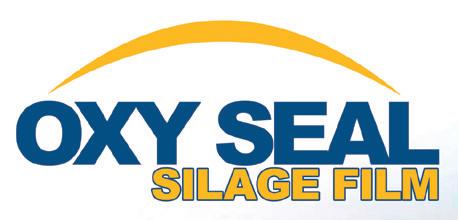

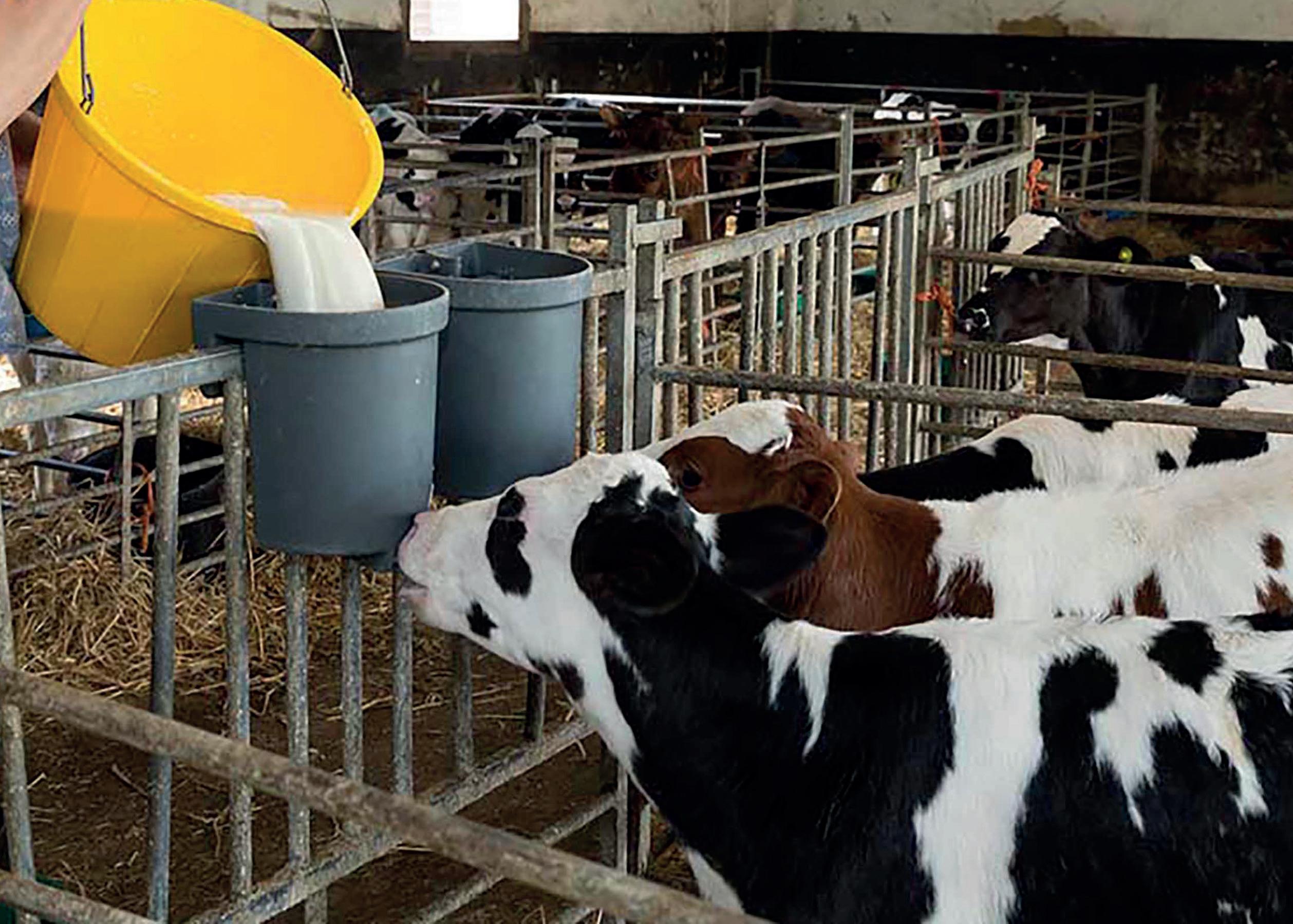

Rumen development has a huge impact on age of first calving, and ultimately on the financial performance of a farm business.
Dairy Farmer reports.
Despite the dairy industry largely agreeing that heifers should be calved at 22-24 months old, this is not always seen on-farm.
Liz Newman, heifer rearing spe cialist at Advanced Nutrition, says this is ‘crazy’ given the impact that not meeting this target has on overall lifetime production and rearing costs.

She says: “There can be several factors at play but by far the biggest influence on achieving an age of first calving at 22-24 months is rumen development.”
She says that through her work she has seen the improvements in milk powders and starter feeds. However, she adds that while these can have a big impact on how we rear our heifers, if rumen develop ment is not optimised these prod ucts are not going to do their job.
Financial impact
JCalving at 26 months rather than 24 months could cost up to £2,048 per heifer (see table).
Ms Newman adds: “On top of this there are additional
She says: “When I am on-farm with our clients, before we discuss the merits of milk powders and starter feed, I look at the bigger picture. How is the rumen being developed, and is it [being de veloped] early enough to reach the age of first calving we are aiming for?”
Ms Newman reminds farmers that a calf is born as a pre-ruminant and has to become a functioning ru minant by the time it is weaned.
She adds: “Essentially, it is up to the farmer to develop the rumen to achieve the daily liveweight gain (DLWG) and the correct age of first calving.”
She says a developed rumen acts as a fermentation vat where microorganisms digest complex carbohydrates and high fibre feed
Liz Newman says by far the biggest influence on achieving an age of first calving at 22-24 months is rumen development.
stuffs. The rumen wall is covered in finger like projections called papillae which greatly increase the surface area which nutrients can be absorbed through.
ter with it being possible for calves to start developing a rumen as early as three weeks old if they have had access to quality starter feed and water.
costs to consider if calving in past 24 months which would include additional heifers required and their rearing costs.”
Calving at 26 months instead of 24 £300 per heifer
Reduced lifetime yield* £1,748 per heifer
Total cost £2048 per heifer
In addition, if calving at 26 months £5,400 per an extra three heifers are required 100 cows per 100 cows
*At a low milk price of 38p, this is 4,600 litres.
She adds: “When a calf con sumes water and starter concen trates, bacterial fermentation is initiated in the rumen. This gener ates large amounts of volatile fatty acids (VFAs) in the forms of acet ate, butyrate and propionate. This production of VFAs, particularly butyrate, is responsible for rapid rumen development.”
Ms Newman says the earlier starter feed is introduced, the bet
JCalves should be consuming a minimum of 2kg of starter before they are weaned, recommends Ms Newman and she adds that rumen development does not end at weaning.
She says: “Regardless of when a calf begins to eat starter feed, it takes two to three weeks for microbial population to grow to a size where it can efficiently digest grain, allowing energy to be gained from solid feeds, and increasing the chance of a successful weaning without detriment to health and growth rates.”
According to Ms Newman, whatever the weaning age, choice
She says: “It is an ongoing process which continues at a slower pace until the heifer reaches maturity, therefore the rearing feed programme needs to continue to encourage rumen development.”
of milk powder and environment, it is not possible to achieve the DLWG needed at the point of breeding if the rumen is not properly developed.
She says: “Poor rumen development in the milk feeding phase of rearing means that once weaned, calves are less able digest and utilise feed, causing a reduction in health and growth rates, increasing the age of rst calving, which has a nancial impact.”

She says calves will grow well on a high milk only diet, and they will also grow well on a balanced milk and starter diet, but only one will develop the desired rumen (see rumen pictures , above right).


JMs Newman says starter feed and water intakes are essential for rumen development. Top tips to encourage starter intakes:
rOffer small amounts of starter feed fresh everyday.
rFeed should be in troughs or buckets they can reach easily.
rLighter coloured buckets with wider openings are best.
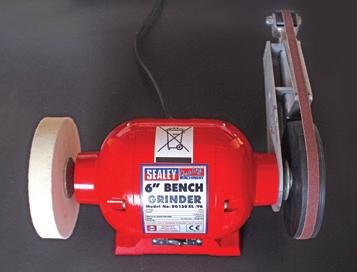


rOffer a quality feed low in dust.
rFeed should be formulated with palatable ingredients, be correct balanced in terms of protein and energy.


rOverfeeding milk/milk
replacer can reduce starter feed intakes.


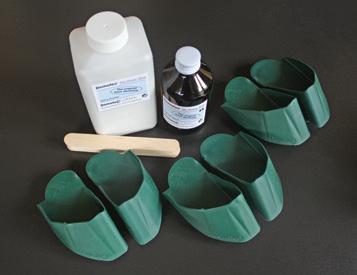

rEnsure you have a controlled weaning programme.
rPaired or group housed calves generally have higher starter feed intakes.
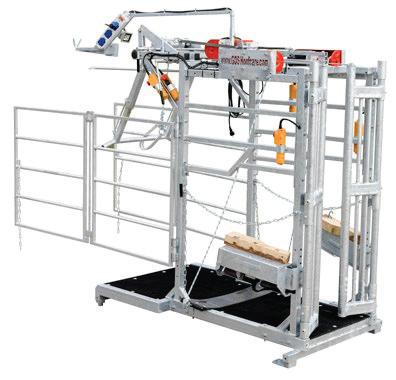
rCalves in general poor health have lower feed intakes, so the calves environment and management should promote all round good health.

r Monitor starter feed intakes, if a two-week-old calf is not eating starter feed, you need to determine why.
Ms Newman says: “Water
should also be available to calves from birth. This should also be easily accessible, clean and fresh. In warm weather water should be out of direct sunlight.
“Roughage also has a place in rumen development. It provides a scratch factor which encourages muscle development and also fills the rumen to increase the size.
“Its main function is training the animal to chew and ruminate and produce saliva to maintain rumen pH. Chopped straw should be available separately to bedding.”
From farmer cattle crushes to wooden blocks, we have everything you need to keep your cows' feet healthy!
new 66-cow dairy building.
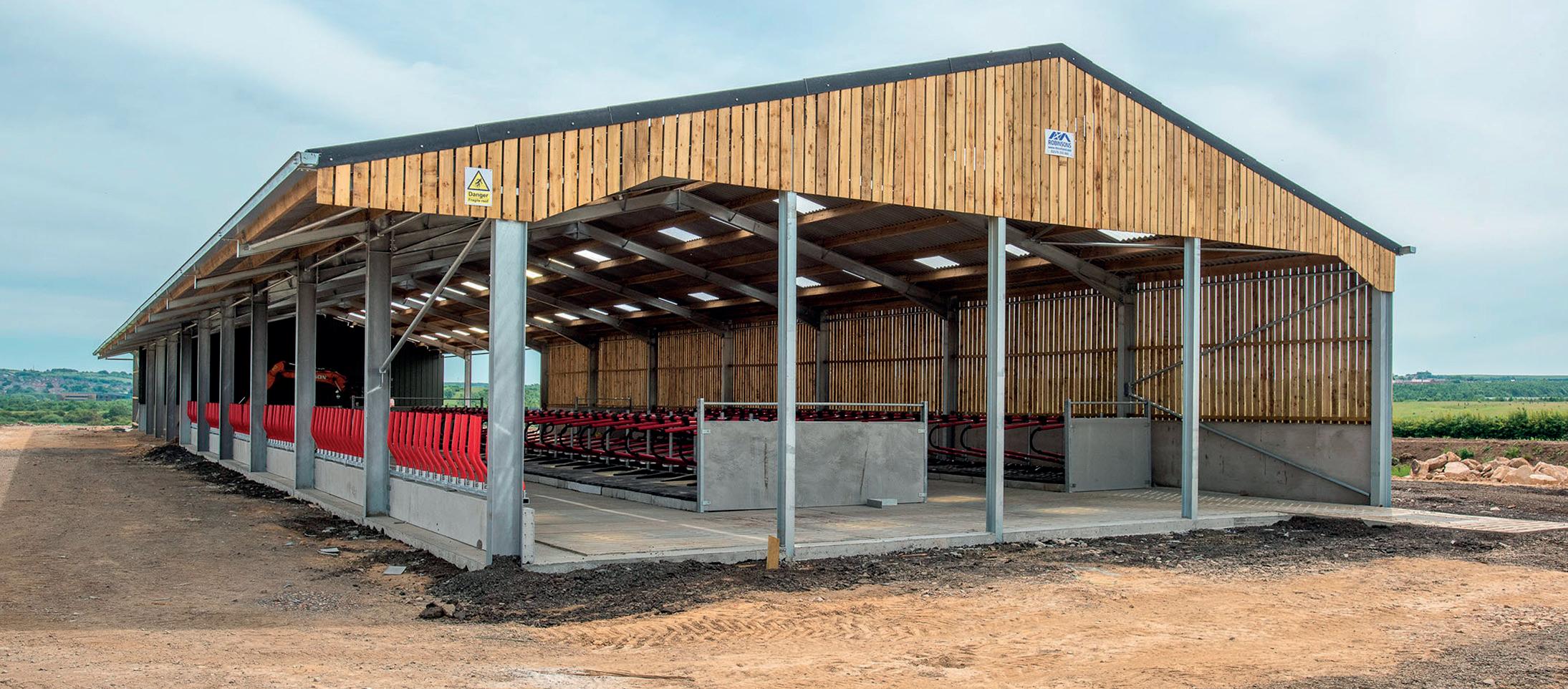
With a large number
dairy
For Tony Green and his nephew, Jake Green, going into dairy farming was a no-brainer. The pair farm 158 hectares (390 acres) of owned grassland and 16ha (40
acres) of woodland. From this land they are producing lamb and beef which they sell in their farm shop which they run with Tony’s daughter, Steph.
Alongside the farm shop they also run a tea room, butchery and plant nursery, all situated at the foot of Penshaw Monument, near Sunderland, Co Durham.
To expand the farm further and supply their own milk to the farm shop Jake and Tony have taken the plunge into dairy, installing a brand new, state-ofthe-art dairy unit at Wheatley Heads Farm, a greenfield site they bought in 2018, on the out skirts of West Rainton.

“Because we already sell our own lamb and beef through the farm shop, it seemed like a no brainer to supply our own milk too,” says Jake.
The family has already in stalled two vending machines at the farm shop which are cur rently supplied with milk from a local dairy farm.
“Going into dairy was not al ways the plan, but as the farm shop developed, now seems like
the right time to go for it,” says Jake.
“We want to sell our own milk as it allows our customers to connect with where their food comes from. Plus, the farm shop is only 15 minutes away from the dairy unit, so it keeps food miles to a minimum.”
Construction of the main
Left to right: Jake Green and his uncle, Tony Green.
dairy unit did not start until February this year but with help from industry experts, Jake has designed a welfare-focused, Dutch-style set up.
When complete the unit will house up to 70 cows with dry cow and calving pens, complete with a Lely Astronaut A5 robot, robotic slurry scraper and robotic feed pusher.
Designed
e building has been designed with the cows in mind, says Jake.
“From the start we wanted the shed to be as comfortable for the cows as possible.”
Jake has worked with Wolfenden Concrete, a UK manufacturer of precast concrete products, on the project to ensure the new dairy set-up met their needs. ey also used the company’s Supa range of products including slurry channels, slats and cubicle beds.
Jake opted to install the
EASYFIX Dream design cubicles, alongside EASYFIX Jupiter F/F45 ma resses.
e cubicles are a ‘two-bend’ design, made from rubber and plastic which allows for be er cow movement and exibility, says Jake.
All 66 cubicles have an adjustable neck rail complete with neck scratcher.
Jake says: “ e neck rails have been installed at 83cm from the end of the ma ress to the neck rail, to comply with the space
requirement for British Friesians, however they can be adjusted to t larger cows.”
e cubicle ma resses have a 45mm layer of PU latex foam, providing a cushioned top surface for cow comfort, says Jake.
As well as an integrated brisket board at the front and sides of the ma ress, the back of the
mat is sloped, allowing cow muck and urine to easily fall away.
Jake also chose to install the EASYFIX Evolve feed rail, with enough feeding space for 79 cows.
He adds: “We chose this design, as the rail gives the cows an extended reach, which creates more natural feeding behaviour.”
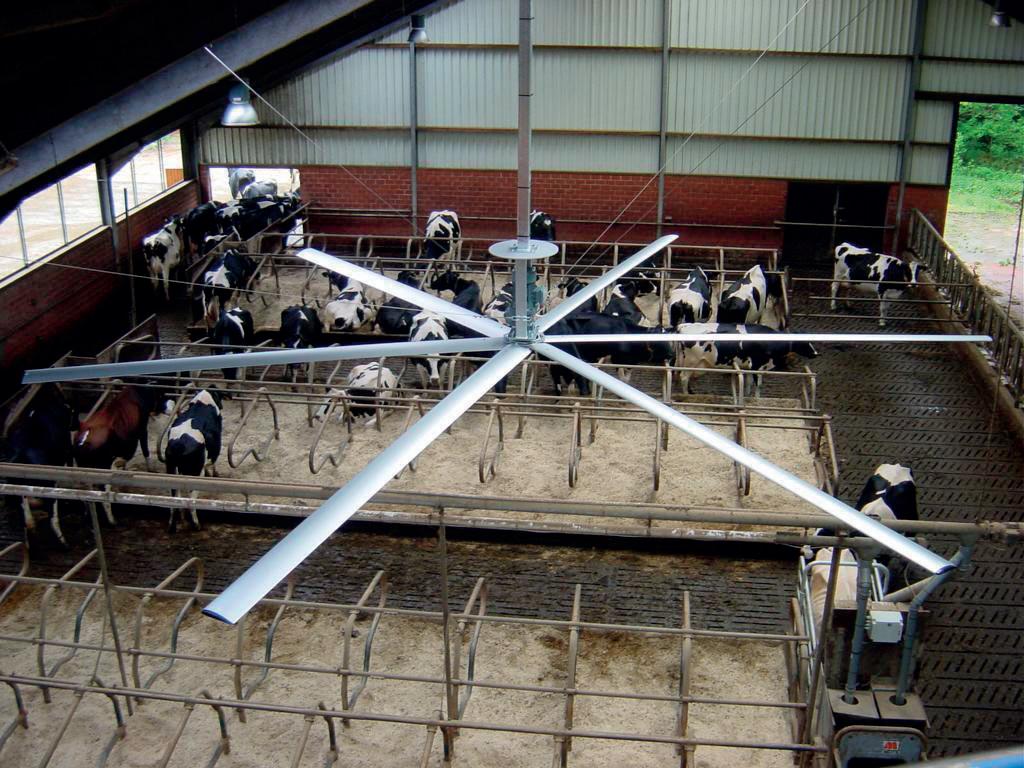
In addition, the concrete
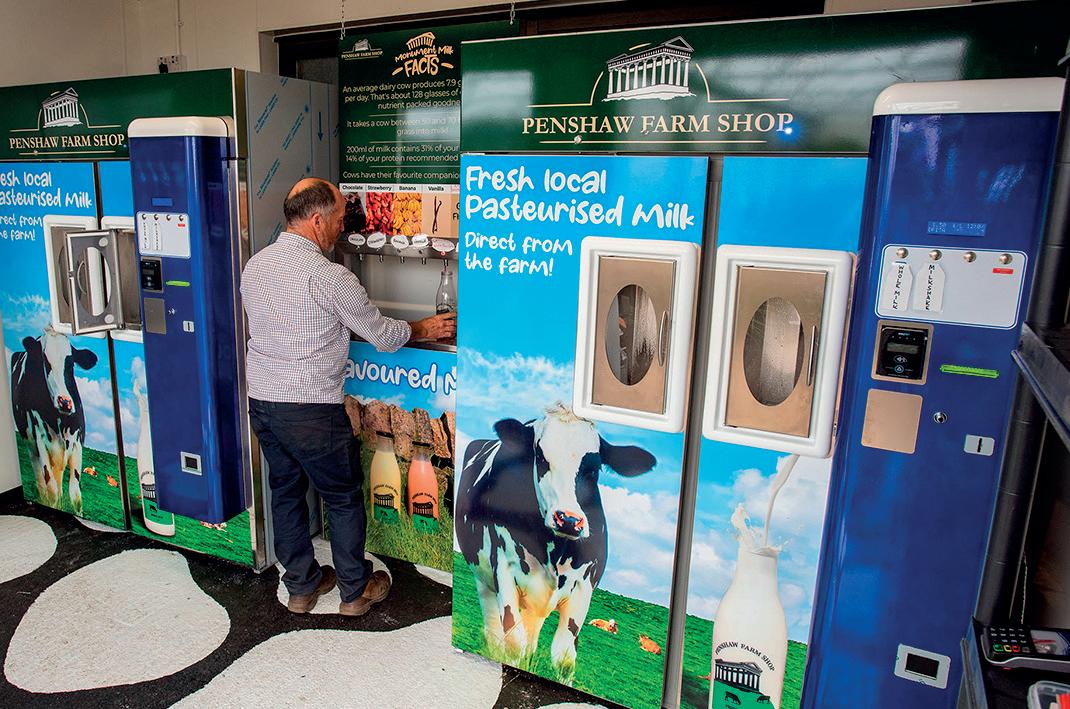

From the start we wanted the shed to be as comfortable for the cows as possible
JAKE GREEN
platform in front of the feeding rail has been built four inches higher than the shed oor to achieve optimum eating height.
In between the feeding rail and sla ed ooring, is a two-foot-wide concrete platform which will be covered with rubber ma ing.

“ e rubber ma ing is to take pressure o the cows front feet while eating, but we have kept the concrete slats uncovered in passage ways to help wear the cows feet down.”
To mitigate the risk of heat stress, the 220 metres by 55 metres, galvanised shed includes 80 sky lights along the shed roof which have been positioned to make sure cubicles have both shade and sunlight.
“We did this to allow cows to choose between cooler, shaded cubicles and warmer ones in the sunlight,” says Jake.
In terms of ventilation, the shed has an open ridge along the roof, with a perspex cover to improve air circulation.
Additionally, adjustable gale breakers will be installed at the gable end of the shed and alongside dry cow bays.
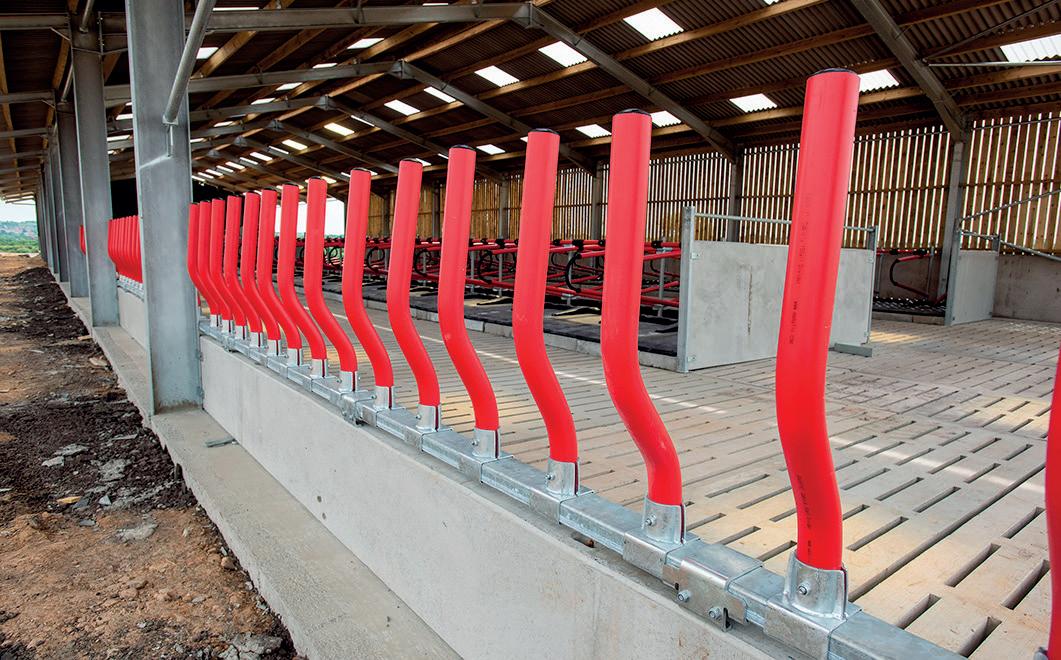
With slurry management being a large part of the building design, Jake has installed a 10foot deep slurry tank with nine months storage capacity.

“We decided to build the tank under the cow shed, so we do not have to pump the slurry to an outdoor lagoon, plus the slurry tank already has a cover on with it being under the shed,” says Jake.
Jake is also ing an aeration system into the slurry tank, to prevent any gas build up in the slurry. e tank has 15 separate zones, where the aeration system will go o every hour, to stop gas build up.
Jake says: “ is also stops a crust from forming, so the slurry never needs stirring and is always ready to spread.”
r220 metres by 55m galvanised shed
rTwo 3m stainless steel dump water troughs will be installed
rTwo cattle brushes to be installed
r10ft underground slurry tank installed with nine months slurry storage
r
Aeration system to be installed as part of slurry management
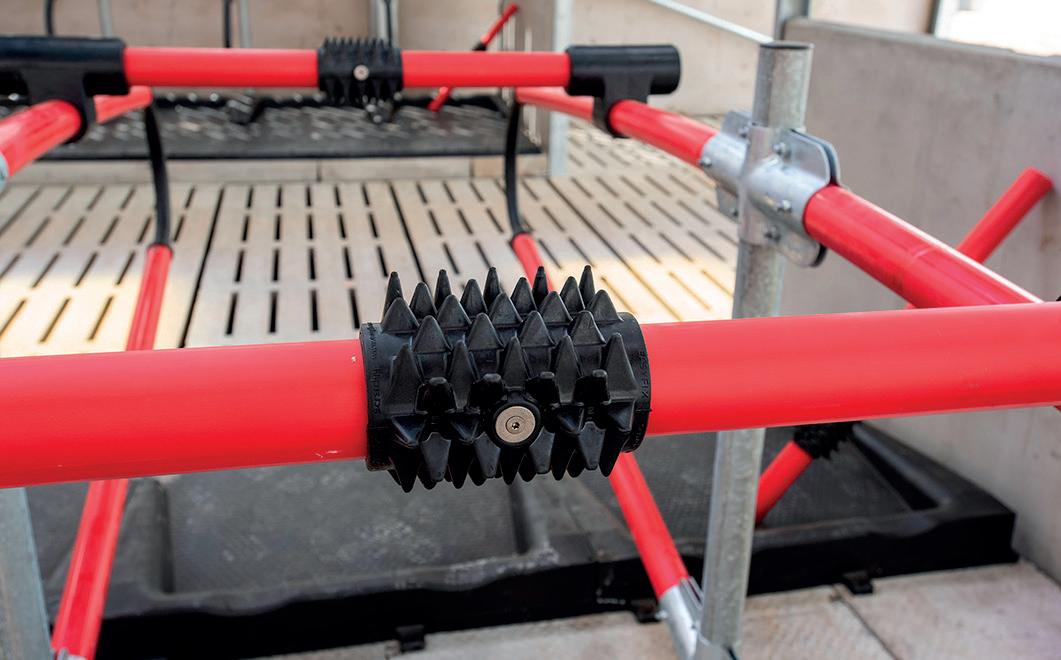
rGrazing gate to be installed once the cows have settled in
At the end of the shed, a slatted, concrete ‘je y like’ area has been built from where slurry will be extracted without needing to enter the shed.
“With the slurry access outside it means the cows

We decided to build the tank under the cow shed, so we do not have to pump the slurry to an outdoor lagoon
will never be disturbed,” says Jake. Alongside the main building, a 45 wide by 90 silage pit was built in May 2021, which currently holds 49ha (120 acres) of silage from this year’s cut.
Extended slatted area for slurry extraction.
“ e concrete is seven inches deep on the silage pit oor, including strengthening bres and a chemical resistant coating to prevent e uent corrosion,” says Jake.



He admits the design and con-
Eighty sky lights along the shed roof have been positioned to make sure cubicles have both shade and sunlight.


struction process has been challenging at times, but his enthusiasm for the project has never swayed.
“Because I am not from a dairy background I have had to rely on a lot of people for a lot of things. I spent a lot of time researching various systems and asking a lot of questions, because I am only going to get the chance to do this once.”

With the construction set to
be complete soon, Jake plans to introduce a herd of 40 British Friesian cows to begin with.
“We want to start small, so we can work out how much milk we can sell through the farm shop.” roughout the project future proo ng the business has been paramount, and space for another shed has been incorporated into the building design if Jake decides to expand the herd.
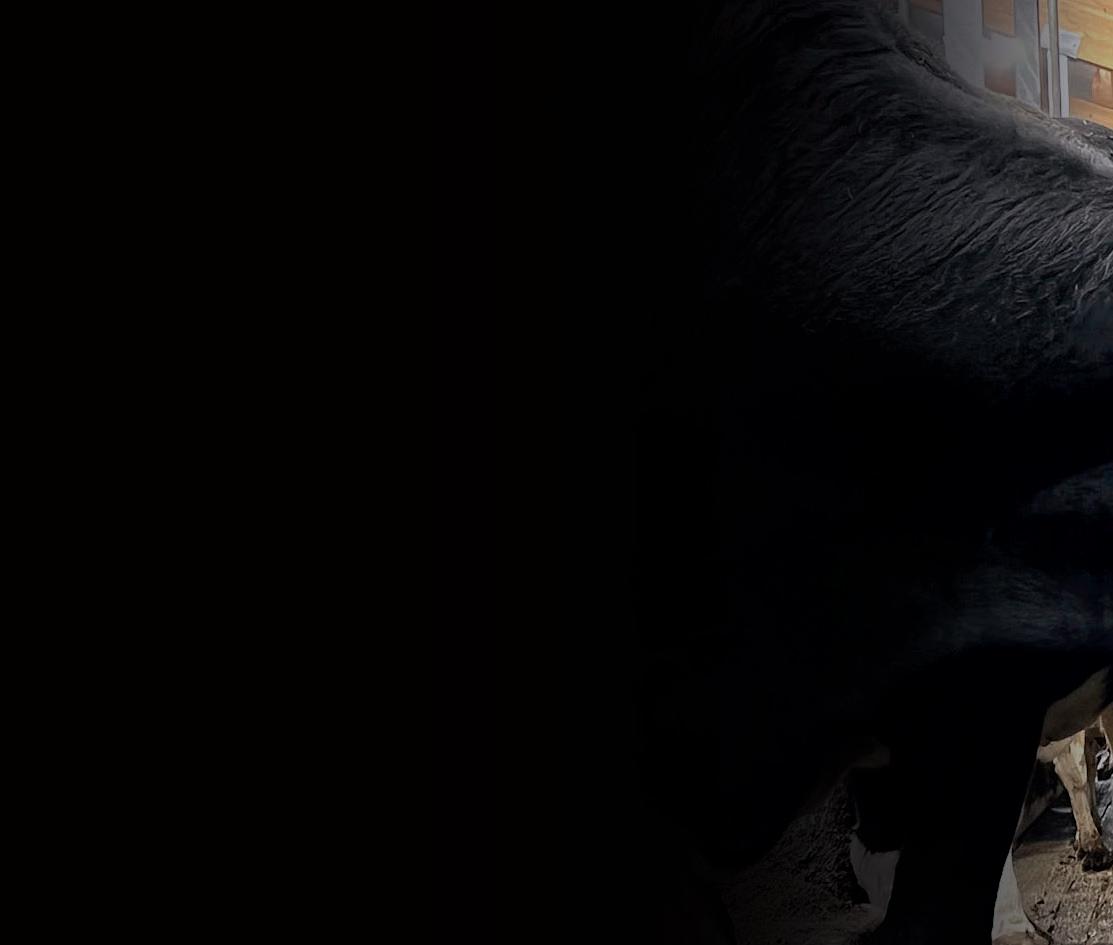

Aslurry vacuum robot is saving two hours of work a day for, Keith Davis, as well as giving an improvement in cow health due to a cleaner environment at Daniels Farm, Gloucestershire.
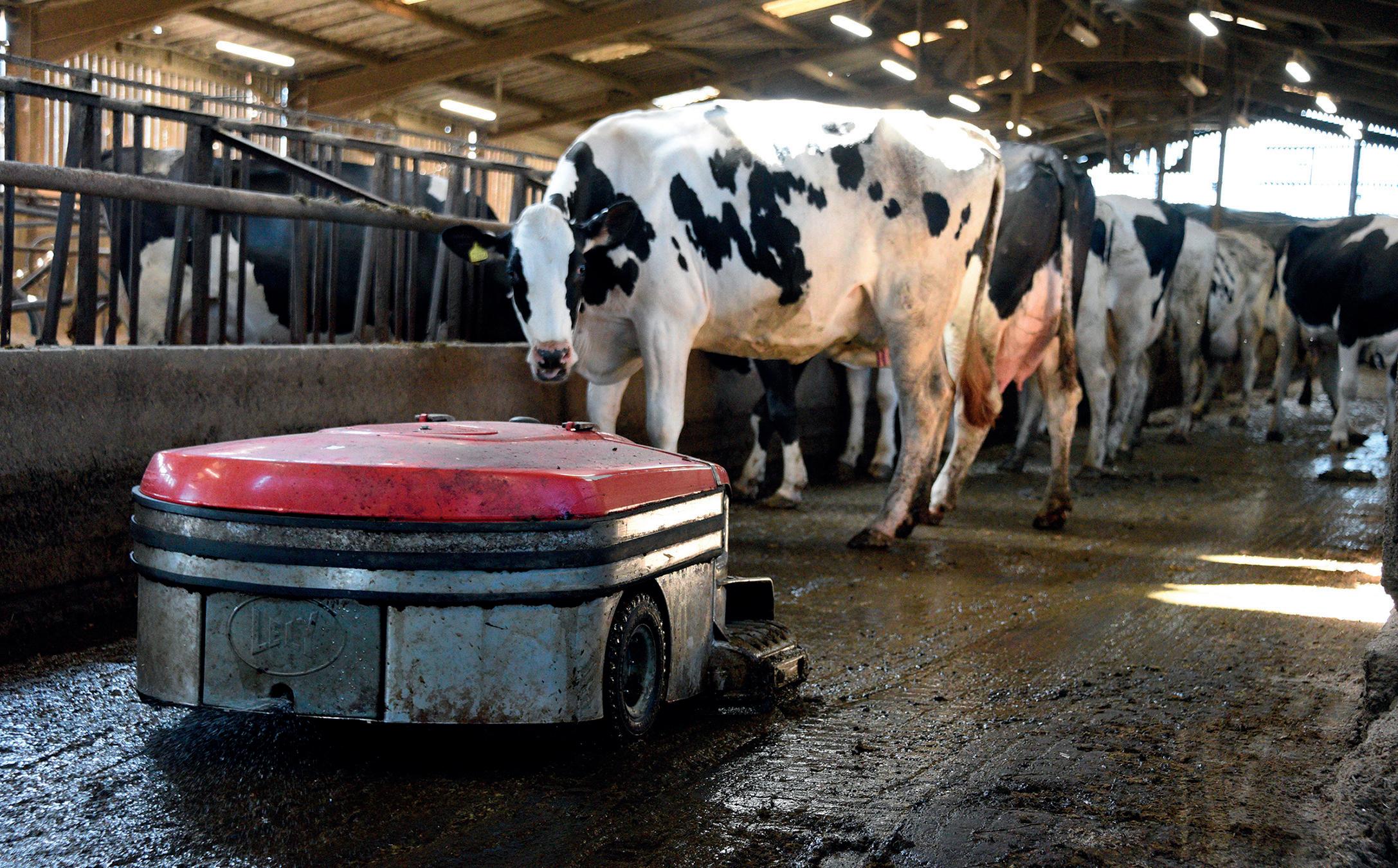
Time is o en a limiting factor for milk producers and even more so for Keith, who also manages a large dairy farm close to the family unit at Blakeney.
Keith, who farms alongside his brother Pete, switched from a standard tractor/scraper system for their Holstein herd following the purchase of a Lely
Discovery 120 Collector in early 2021. It adds further automation to the farm business, which uses two robotic milking machines in the cubicle housing.
As its name implies, the
Collector operates in a similar way to a vacuum cleaner.
It traverses the passages, using a vacuum pump to draw up slurry into its tank, while at the same timer spraying water through frontal nozzles to facilitate cleaning. Meanwhile, water is sprayed from the back nozzles to give the cows a be er grip on the oor.
Suitable for solid- oor passage systems, the Collector navigates independently through a series of built-in sensors.
It is set to collect slurry on a two-hourly basis at Daniels Farm, depositing the material in the lagoon before returning
to its docking station for a power recharge and to replenish its water tank. e operation timing is set by the user and can be controlled via mobile phone.
Keith notes that the time saving is one of the most important bene ts o ered by the Collector.
“We used to operate the tractor and scraper twice a day and it would take at least a couple of hours in total. Anyone who has this system will know that is a laborious task to coax the ca le out of the cubicles in order to clean the passageways,” he says. ere has been an estimated annual saving of £2,600 (just
The slurry channel is much cleaner because of the frequent collection
KEITH DAVISThe slurry vacuum navigates through a series of built-in sensors.
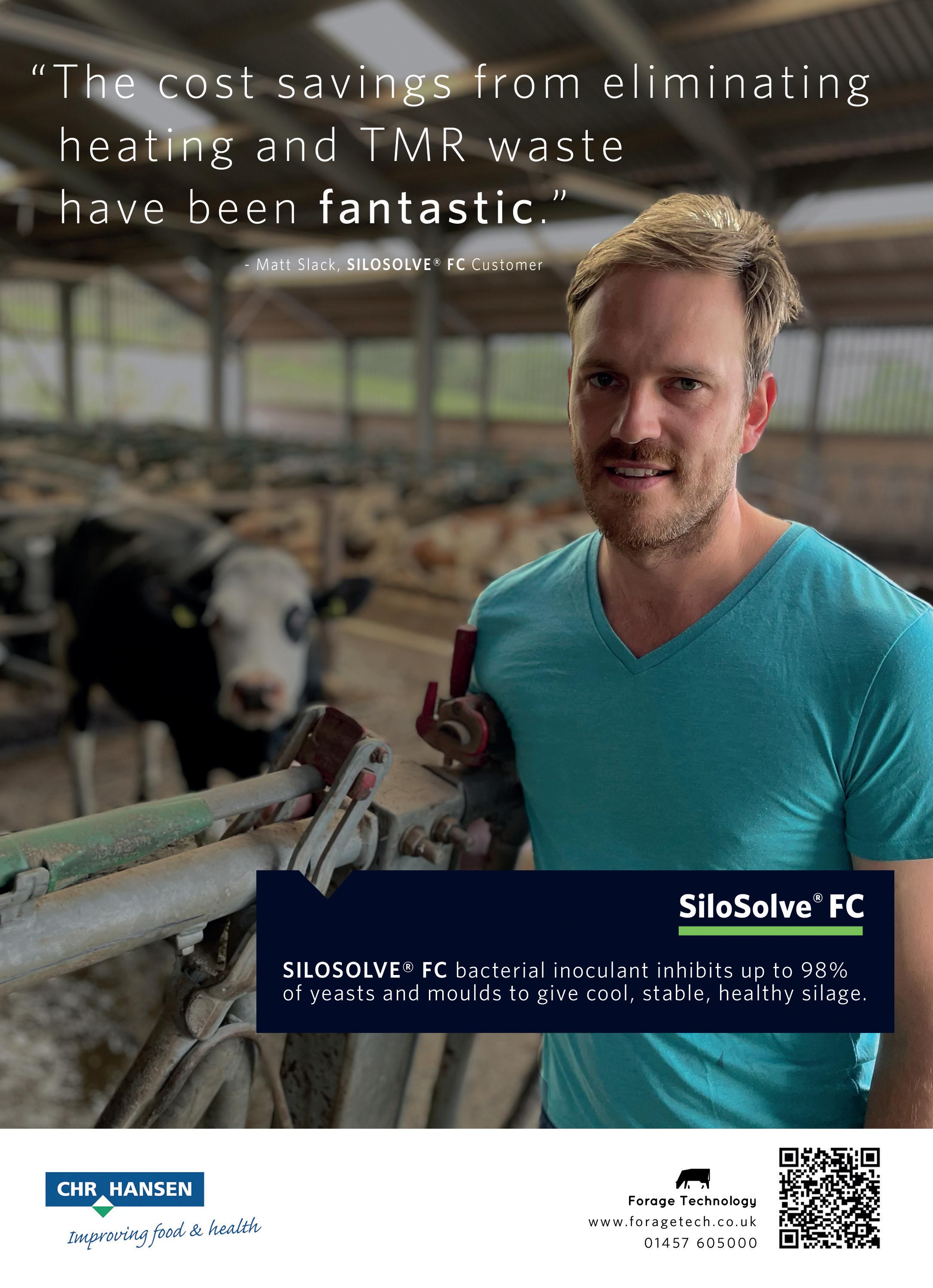
over £50/week) in sawdust bedding costs in additional to several health bene ts, he explains.
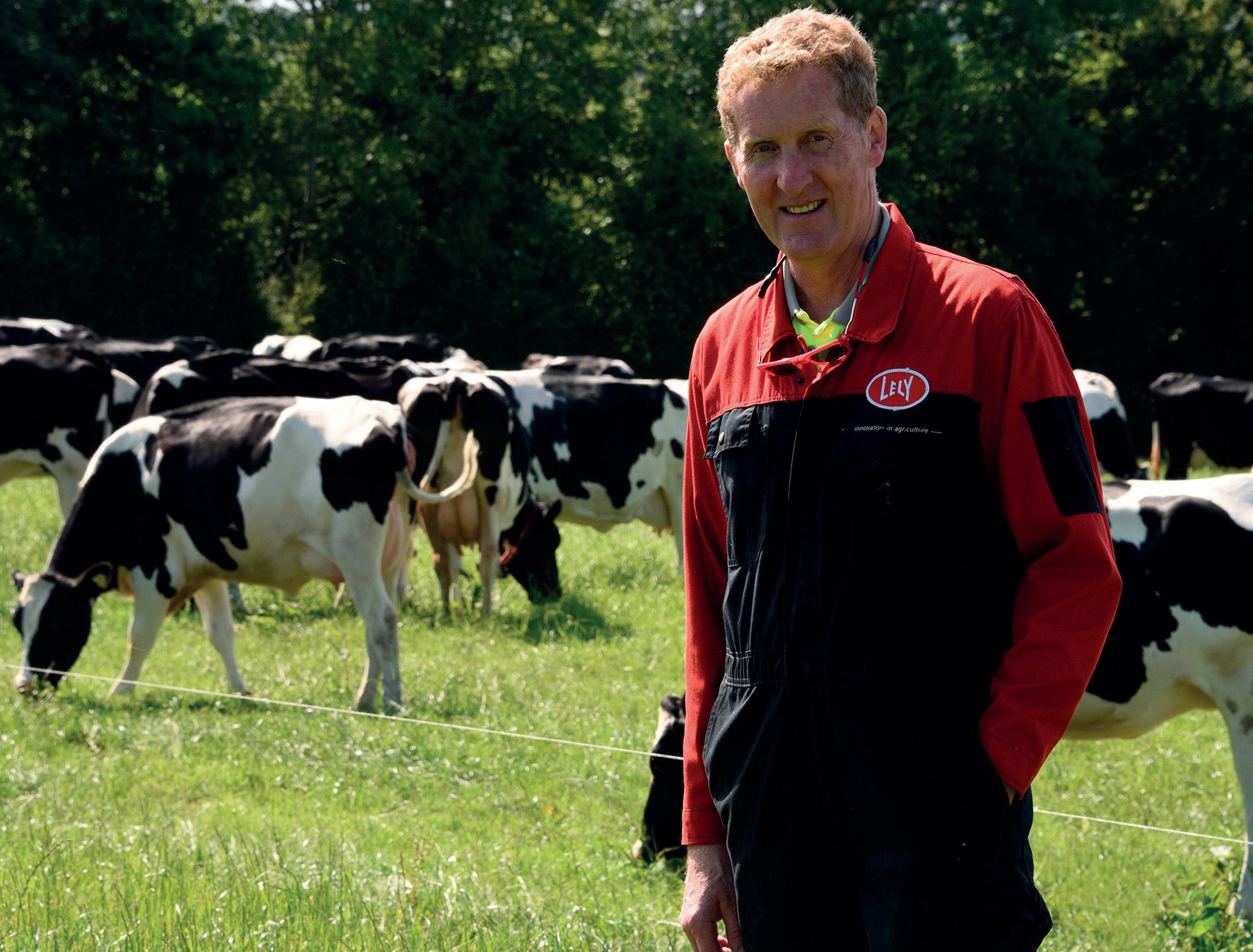
“ e slurry channel is much cleaner because of the frequent collection and washing of the passages. erefore, the bedding does not have to be replaced as o en, compared with the original system.
In addition, the cows’ udders bene t from the more hygienic environment. e average bulk somatic cell count has fallen by 110,000 cells/ml to the current level of 120,000.
“Also, mastitis cases have halved from an average 36 cases/year to just 18.”
It was not di cult to nd a site for the slurry robot docking station, despite the installation being retro- ed, he comments.
It is positioned next to the lagoon, in a corner of the yard which was previously used as a covered loa ng area.
“ e installation cost a total of £200 including the electrician’s labour and took only half a day from start to nish,” he says.
“ e water pipes and electricity cables were run through the roof purlins to connect the docking station.”
e machine requires li le in the way of maintenance and the only regular task is the weekly cleaning of the sensors.
e two tyres were replaced as complete wheels a er about 14 months at a cost of under £200. Water usage is 80 litres per run; fortunately the farm has a borehole supply, while electricity consumption is roughly £1/day.
e only problem encountered so far can be blamed entirely on human error, admits Keith.
“We quickly learned that we must close the gates properly, because the machine will continue on if it does not encounter a barrier.
“It became ‘lost’ on a couple of occasions in the early days, but it was not a serious issue. A er a while, it recognised that

it was not following the normal pa ern and it switched itself o . It was then a simple ma er of steering it back into the right position.”
e 120 ‘Daniels’ Holsteins held the title of the UK’s Highest Pro table Lifetime Index herd for several years running, but the loss of a rented unit slowed progress and e orts are being made to regain its former position.
Sexed semen from bulls which include Genosource Captain, Denovo Kenmore and Denovo Crosby is used on the upper end of the herd, while the lower end receives British Blue semen and their calves are sold at 10-14 days’ old. Heifers have been successfully calved at two years of age for many years.
The installation cost a total of £200 and took only half a day to finish
KEITH DAVISKeith Davis
e herd average yield is 11,000kg at 4.55% bu erfat and 3.50% protein, with block-calving from July to October and milk sold on a cheese contract to Wyke Farms.

e cows are given access to summer grazing for a set period and receive a 65% maize, 35% grass silage mix at the feed bar-

rier, with concentrates matched to yield in the robots.

Each year, the business buys-in four hectares (10 acres) of maize, to make up the forage requirement.
While the obvious next step would be to add automated feeding for the forage element of the diet, this is not a move that

is planned for the near future, says Keith, who is third generation on the property. However, the idea has not been completely ruled out, he states.
“My brother does not have children, but I have a son who works abroad in musical
theatre and a daughter, who is a teaching assistant.
“ ey have expressed li le interest in taking over the family dairy farm to date, but if additional automation would make the prospect more aractive then it is certainly something that we would consider,” he says.
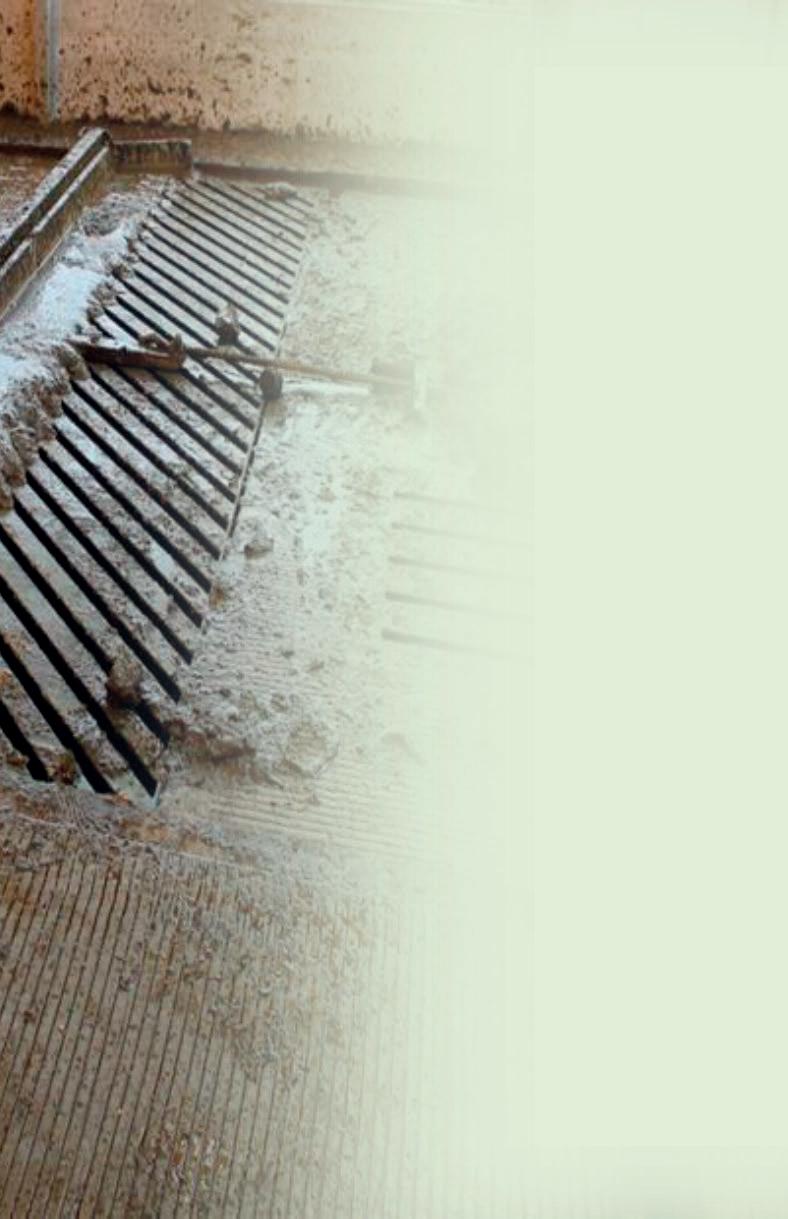


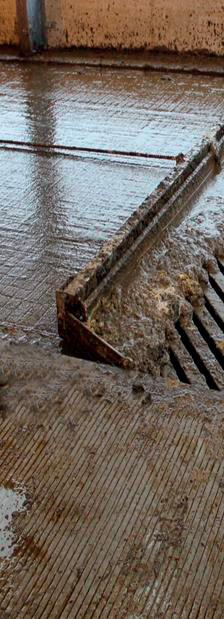
In order to manage slurry more e ciently, a much greater level of detail is needed for a product that is generally considered a nuisance rather than an asset, according to Terry Baker, of Tramspread.
“For most farmers the slurry pit has long been a waste storage problem, rather than a fertiliser store. For those willing to manage and apply slurry safely, there are signi cant cost and operational savings to be made,” he says.
e government’s Clean Air Act suggests that all slurry will need to be covered by 2027.
Grants have been made available with a minimum of £25,000 and a maximum of £250,000, covering up to 50% of a slurry infrastructure project. e guidance, published on the gov.uk website in June, explains that both landowners and tenants
Lagoons are often built too wide and are hard to mix, says Terry Baker.
are eligible and that the Rural Payments Agency will prioritise based on projects that present the ‘biggest environmental impact’.
Storage volume is a key consideration and should be calculated based on benchmarked values per animal, the herd size and the land available to apply the slurry.
Mr Baker says: “O en, lagoons are built too wide and
are hard to mix and manage. As the slurry binds together, the capacity of a lagoon will decrease and eventually areas become impossible to work with.
“Using bag tanks with integral agitators, or above ground tanks that can be easily accessed with pto mixers, will make slurry easier to manage and make it more homogenous for application.”

In nitrate vulnerable zones it is also important to account for

additional rules that may prevent spreading at certain times adds Mr Baker.
“Allowing for growth is one consideration, but if a oating tile cover is being used, the volume of the tank will increase with rainwater too.
“Fabric or rigid covers that block rainwater will prevent the slurry from being diluted and also reserve the full volume of the store for slurry.
There is an opportunity for dairy farmers to take advantage of grants to manage slurry more efficiently and reap the benefits by saving on bought-in fertiliser. Dairy Farmer finds out more.
“However, the store must have the structural integrity to bear the weight of the cover and it is important to mix the slurry to prevent a build-up of solids.” e environmental e ects of slurry lagoons and stores that have failed are signi cant, especially if the store is large. Detrimental e ects to soil and ground water should be considered.
Also, Mr Baker says above ground tanks o er a much better opportunity to monitor and maintain the integrity of a tank to prevent any leaks.

“A below ground slurry lagoon will require the retaining walls to support the external ground as well as the slurry inside the store.
“Above ground slurry storage o ers options to safely maximise storage volume for farms with limited space,” he says.
Using a slurry separator system will result in a more even product, says Terry Baker.
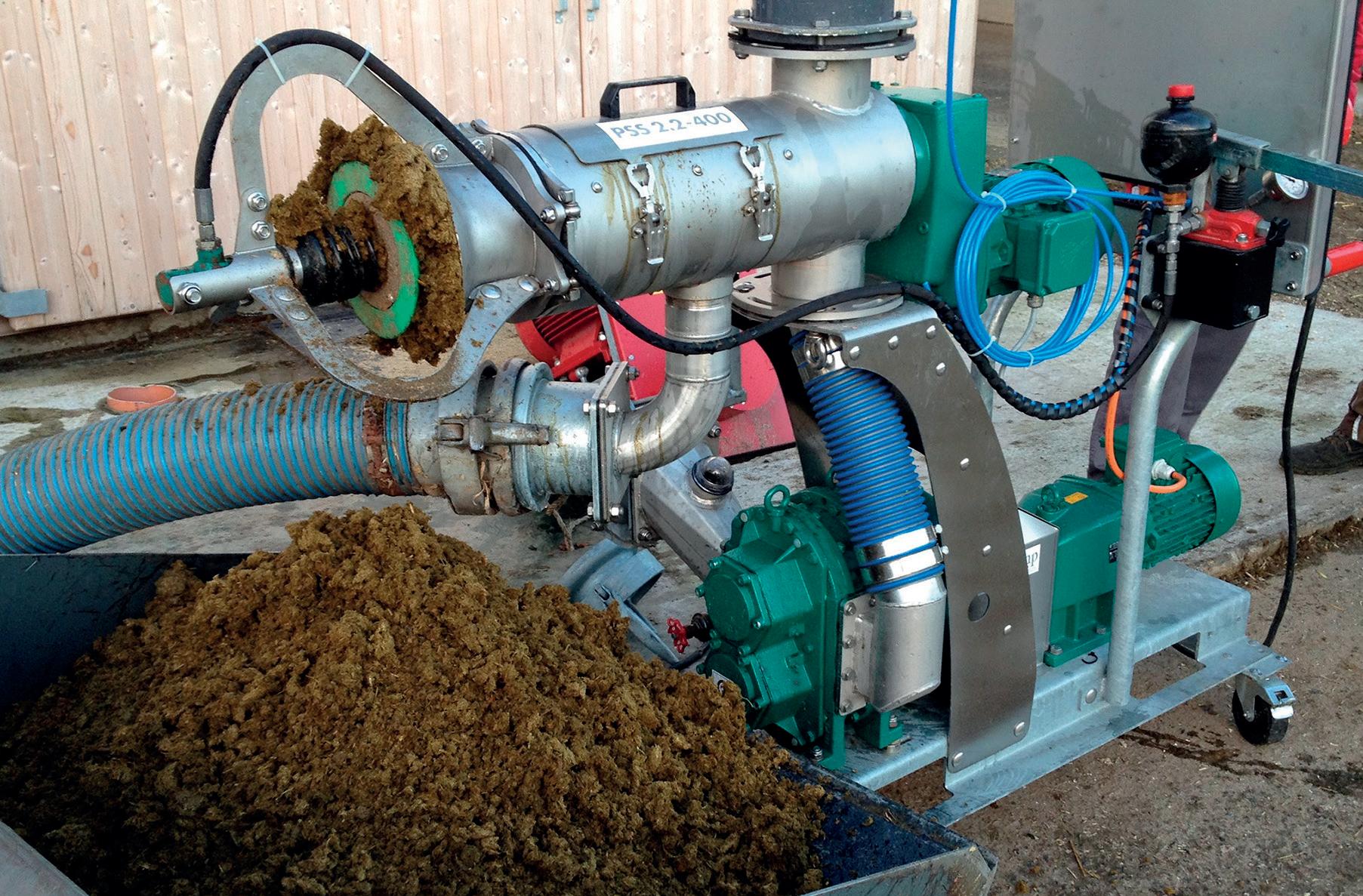
Stainless steel tanks may require planning permission and are a higher cost solution.
Covering existing steel tanks can also be costly. However, there are oating covers available at a lower cost.
“Hexa-Cover is a versatile
product. It oats on the surface of the slurry to prevent 95% of emissions escaping, and is approximately a quarter of the cost of a tensioned cover. However, it does not keep rainwater out.”
Made of recycled polypropylene, the hexagonal tiles oat on

top of any liquid and t together to ll any size space. e tiles block light out and gas in, while also helping to prevent a crust forming.
Mr Baker says: “Crucially for busy farms, it requires no maintenance and can be installed
in two to three hours. For farms with an existing steel tank, fabric covers can cost up to £30,000 for a 20-metre diameter tank, whereas a oating solution for the same area would cost approximately £8,000. It is also popular to cover lagoons because mixers can be inserted easily.”
Bag tanks range in size from 200cu.m to 7,000cu.m and can be located on any soil type as only a shallow foundation is needed. Integral hydraulic or electric stirrers enable easy and consistent agitation of slurry.
e tanks are self-venting so relatively li le management or farmer involvement is needed.
Bag tanks are manufactured in a UV resistant, grey coloured material and, when installed, are low to the ground and have minimal impact on the surrounding landscape.
“Many farmers have installed
Alligator
bag tanks without requiring planning permission. However, those looking to install a bag tank are advised to seek guidance from their local authority as the location of an installation may require approval,” says Mr Baker.
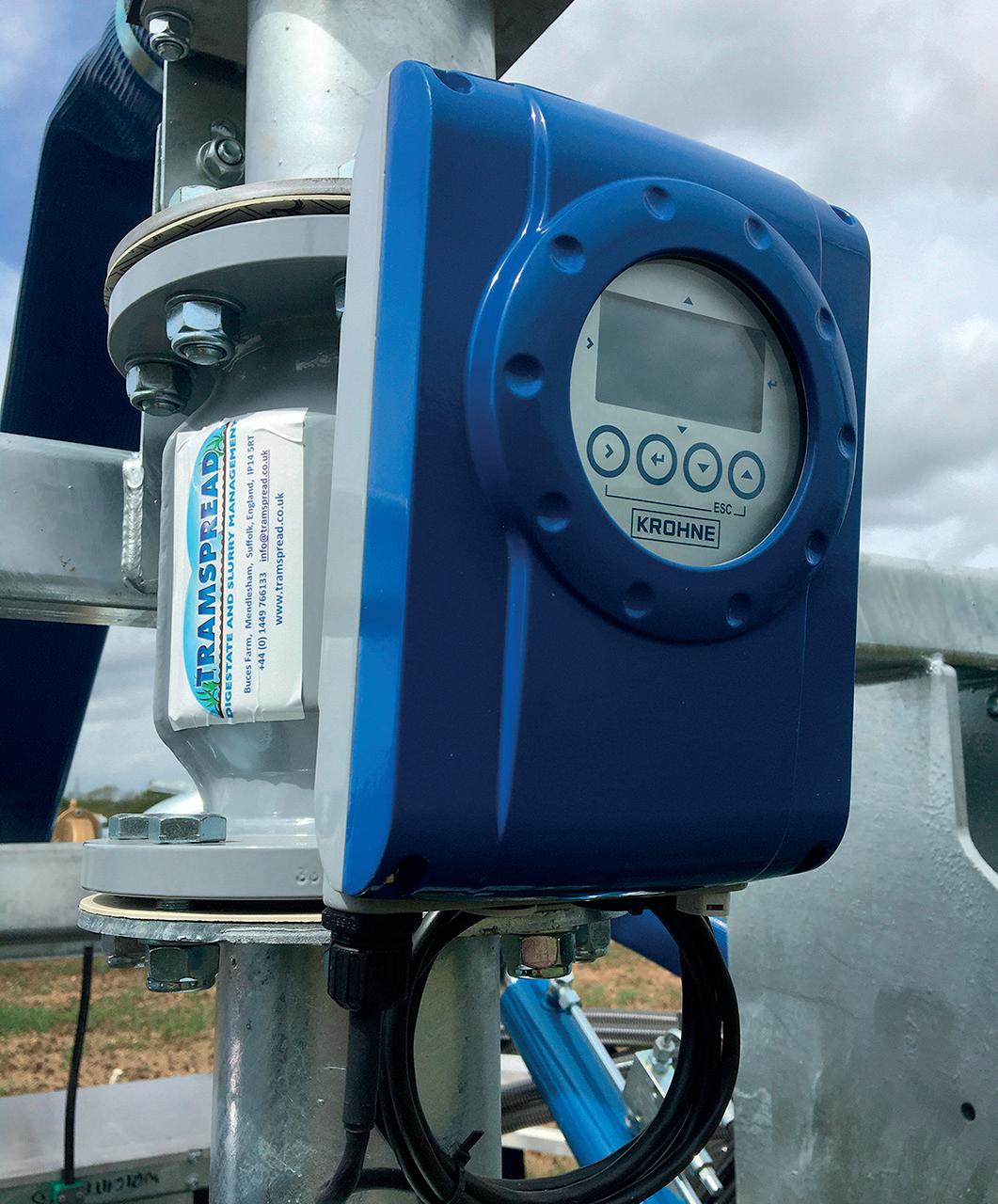
Slurry management is key to the process and Mr Baker believes that the quality of slurry

can be improved from the

point it is collected in the shed.
“Using a slurry separator system will reduce the volume
stored by 10-15% and will result in a more even product which is much easier to manage. e other bene t of separation is to minimise the potential for bedding and forage to be transferred to storage because this will make pumping more dicult and potentially interrupt the ow of slurry in the eld.”
e new grants are also aimed at increasing the volume of storage on farms. Currently, farms are expected to have four months storage, but the grants will only be issued to those demonstrating that the investment will be made in storage that will last for six months.
Mr Baker says: “ is is where separation and management
Hexa-Cover prevent 95% of emissions escaping.

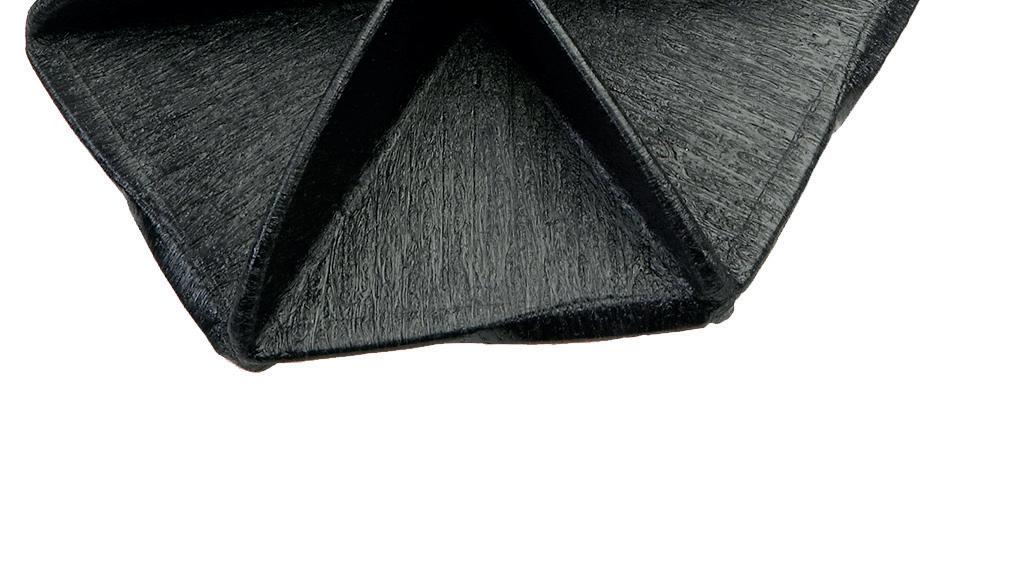

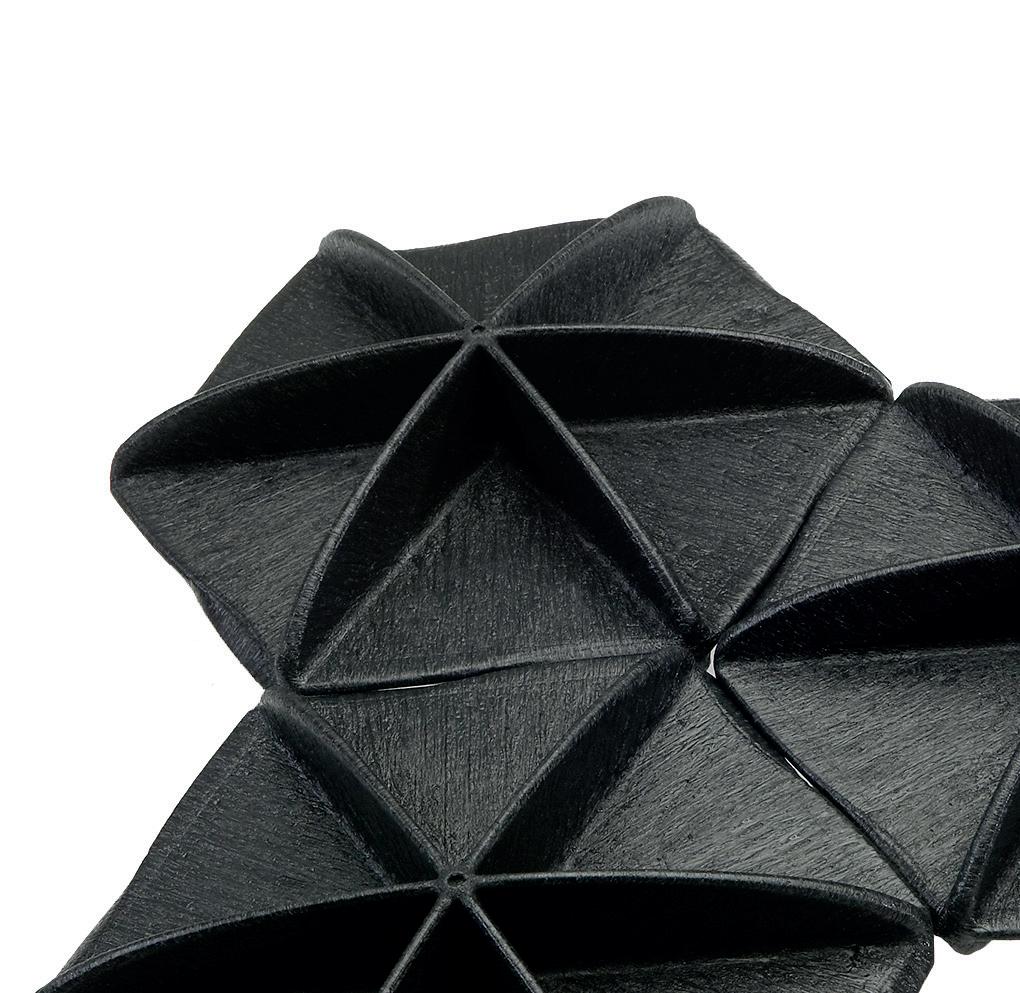
Testing slurry and using a flow meter provides detailed record of the volume and nutrient value applied to the crop.
“If 15% less concrete is
separated, there will be a sig-
ni cant saving in materials.”
“Mixing, or agitating, slurry is o en carried out reluctantly by some and rarely by others. Keeping slurry mixed helps to improve the homogenous condition, making the slurry easier to spread.”
“A well-kept slurry is the beginning of improving the accuracy of spreading. Even the best macerators will struggle with an inconsistent slurry. However, with well managed slurry, operators can fully utilise the accuracy of application methods such as trailing shoes and dribble bar systems.” e Farming Transformation
A well-kept slurry is the beginning of improving the accuracy of spreading
Fund grant scheme for improving farm productivity o ered the opportunity to apply for grants of up to £500,000 for equipment and technology.
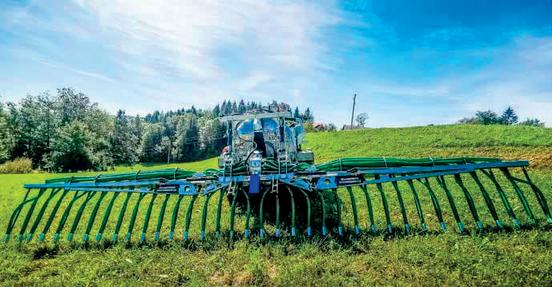

e window for applications opened for eight weeks at the start of 2022 and decisions on those successful were expected 60 days following application.
Mr Baker adds: “For those who were successful, the opportunity to invest in be er application technology and equipment will provide signi cant cost savings on bought-in fertiliser.

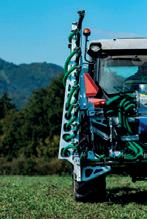




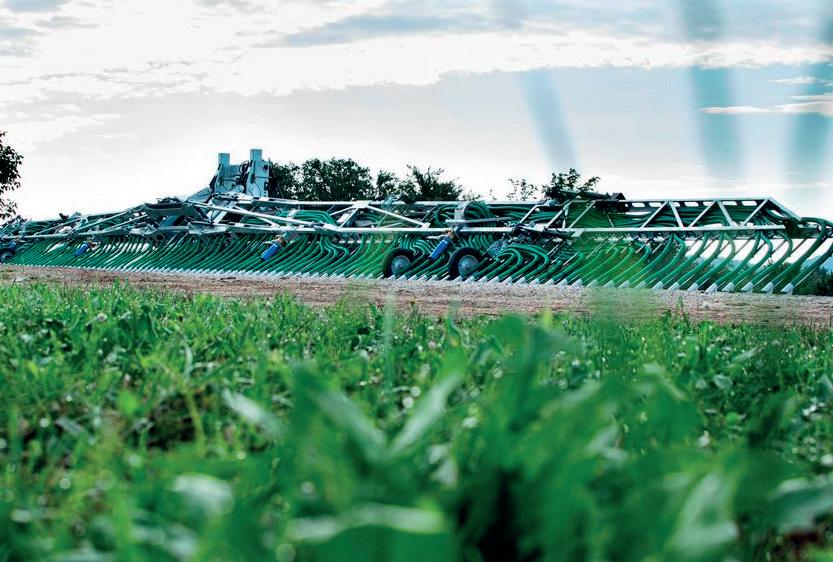
“With prices being at an all-time high, that grant could be saving those who invested, thousands. ere will no doubt be more grants in the future and I would advise dairy farmers to invest and take advantage of them to reduce input costs and make be er use of the natural fertiliser already on farm.”

Using a slurry separator system reduces the volume stored by 10-15%.




hile mobility scoring is becoming more widely practiced on dairy farms, it is o en seen as part of meeting milk contract requirements rather than a driver to further reduce lameness levels.
Tim Po er, of Westpoint Vets, says that while many farms have made signi cant improvements in lameness management, there is still scope for further gains.
“Lameness is a complex issue with a large number of factors at play on every farm.
“Generally dairy farmers have got be er at identifying and treating lame cows and the quick wins of lameness reductions such as routine foot trimming and regular footbathing have largely been realised.
“To go further, there is a need to manage lameness more proactively, to identify problem cows sooner when symptoms are less severe, the consequences less marked and when recovery can be quicker.
" is is where mobility scoring could play a signi cant role, providing an objective way to spot problems sooner and provide data to monitor trends, identify root causes and guide further investment.”

He comments that the principles of mobility scoring are becoming well understood,


providing a method of early identi cation of lame cows based on an assessment of their gait and the prevalence and extent of lameness problems in the herd.
e issue, he says, is that mobility scoring is not carried out frequently enough on many farms to allow the full bene ts from acting on the results to be realised.
He adds that there are signs that the wider industry is beginning to appreciate the welfare and economic bene ts of more regular recording.
TIM POTTER“ e most common frequency of mobility scoring on farms is quarterly as this is the requirement of assurance schemes and many milk contracts.
While this provides a valuable snapshot and allows a degree of comparison between scoring sessions, it does not allow the full potential to be realised.
It is also seen as a chore that takes time to carry out and to assess the results.
“ e more frequently cows are mobility scored, the more valuable the information can
JLameness remains a major drain of dairy farms with Kingshay reporting average incidence at 35 cases per 100 cows per year.
With the direct costs of a case of lameness including yield loss, treatment costs and


labour at £200 per case, this gives a bill of £7,000 per 100 cows per year.
When indirect costs of compromised fertility and higher replacement costs due to increased culling are factored in, the cost per case becomes £618 or £21,617 per 100 cows.
Mobility scoring could play a significant role, providing an objective way to spot problems sooner
be. It will allow cows at the early signs of compromised foot health to be identi ed sooner.
" is will allow you to intervene sooner, potentially reducing the severity of infection, treatment costs and the time taken to treat, and nally help reduce antibiotic use.
"Cows do not recover from lameness quickly so the sooner you can intervene, the milder the symptoms and the faster performance will recover.”
He believes more frequent assessment also gives the data to start making be er informed decisions by allowing more comprehensive analysis of trends and causes.
As so many factors are involved in lameness, identifying the key factors will allow targeted investment to address issues.
An increase in mobility score in fresh-calved cows could indicate a problem with transition management.
Observation of more cases in the summer in grazed cows may be an indicator of problems with tracks .
Meanwhile, higher rates over the winter could point to conditions in the housing that are compromising foot health.

“It is only by changing the way mobility scoring is perceived on farm that the full bene ts will be realised.
“But while time remains an issue on farm this is unlikely to happen where businesses rely on manual mobility scoring.” e solution could lie in systems that can automate mobility scoring.

3D camera systems which assess the mobility score of cows every time they walk under the camera eliminate the major drawbacks of manual assessment.

Stuart Adams from Herd-
The more frequently cows are mobility scored, the more valuable the information can be.
Vision, adds: “ ese systems allow cows to be assessed as frequently as required with no manual intervention or time taken away from other tasks."
“ e Herdvision camera is sited above the race so cows can be assessed a er every milking.
“Alerts sent to your mobile will notify you of any cow where mobility is beginning to decline, allowing earlier intervention with all the bene ts that brings.
“But possibly the biggest bene ts will be gained when looking at the trends in changing mobility which is made possible by more frequent assessment.
“At what time in the year do problems increase and what factors might be behind this? Is there a stage of lactation impact? Are problems worse in a particular group or building? is will allow you to target action.
“It may highlight areas where small tweaks will make a di erence or indicate where any investment will be best placed.”
MILKprices
JCost in ation aside for a moment, it is a golden milk price milestone that only six months ago seemed perhaps destined at some point well into the future, but Freshways has become the rst company to commit to pay 50ppl for our liquid standard* for its A litre milk price from September.
e company says it cannot see farm production cost reducing in the short-term and understands a milk price of this level is required to stimulate the milk it requires, while milk seasonally is falling back from peak much faster than normal years.

It is no industry secret that the company is short of milk and therefore is upfront on its desire to retain and recruit new suppliers to the business, recognising this will

only be achieved by showing price leadership rather than being a price follower.
And while retail prices for milk are now starting to increase, returns from dairy commodities continue to command a 50ppl milk price and the company sees no good reason why liquid milk returns should continue to be a poor relation to dairy commodities.
e 5ppl increase takes the company’s total increase for the year to date to 20ppl, with the new price comparing with 28.5ppl (+21.5ppl) paid for September last year, while 18.18ppl above the ve-year September average price of 31.82ppl.




JFollowing the Freshways announcment of 50ppl, Braeforge (trading as Pensworth) has also confirmed it is to increase its producer milk price by a further 4ppl to 50ppl for our liquid standard, although a month earlier from August.



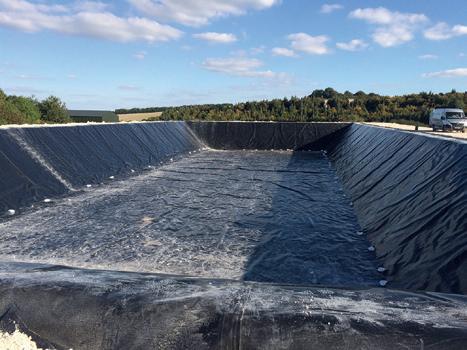

Along with no seasonality or A and B pricing, the price (which is 20ppl above its price
for August 2021) also includes 1ppl paid to all suppliers on this contract who participate in the Pensworth Herd Health Scheme.

The company reports there is clearly an imbalance with milk production and this measure on price has been taken to support its supplying farmers with ever increasing costs.







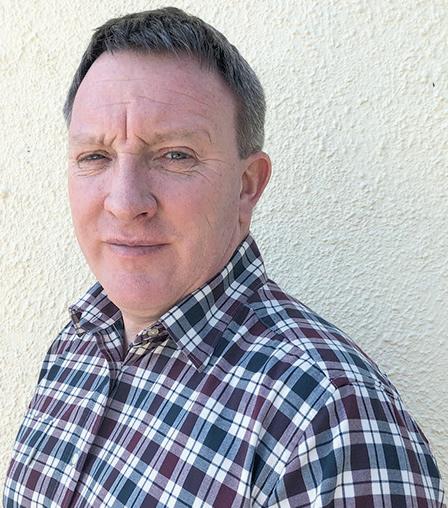
J






While manufacturing milk prices generally have not been able to keep pace with price increases for liquid for July, they are starting to catch up for August.
Aside from Arla, leading the charge this time around is Barber’s Cheesemakers. The cheesemaker has increased its standard litre headline milk price by 2.5ppl to 48ppl from August.
The increase puts its milk price near the top of our manufacturing ranks and follows its 3ppl increase from July, while taking our manufacturing standard litre* up 2.57ppl to 49.42ppl.
This price represents a total increase of 16.49ppl for the year to date from seven price increases. Our liquid standard increases by 2.48ppl to 47.73ppl.

The company reports that it remains committed throughout this unprecedented period of cost inflation to support milk production, not just for the short-term, but crucially for the longer term.

At the same time, it points out that while retail liquid milk and butter prices to consumers have risen to date, in contrast, due to time
lags involved, retail cheese prices have barely moved.
How consumer demand may react and what cost resistance may result as the inevitable costs feed through to consumers remains to be seen.

Other cheesemakers increasing their price for August include Belton Farm, which increased for the eighth consecutive month, this time by a further 1.25ppl to 47.55ppl manufacturing and 46.80ppl liquid standard litres.
Saputo
Saputo Dairy UK increased by 1.25ppl to make it nine consectuive monthly increases totalling 17.91ppl, taking our manufacturiing price up to 48ppl, while 46.28ppl on liquid.
South Caernarfon increases for the same number of months and by 1.75ppl to match the 48ppl, while its price for our liquid standard moves up to 46.35ppl.
Wyke Farms increases for the eighth consecutive month, with an additional 1.77ppl, taking our manufacturing standard up to 48.69ppl with liquid increasing to 47ppl.
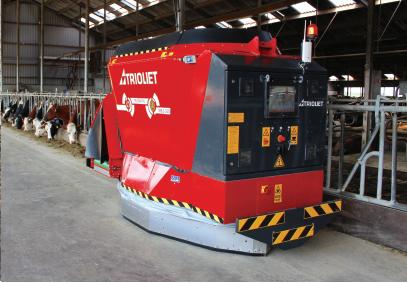



LIQUID PRICES (4% b/f & 3.3% prot)
Mar’22 Apr’22 12mth Diff Latest 4.0/3.3 4.0/3.3 Ave Apr’22 Confirmed Before Before May’21 v Milk Seas’lty Seas’lty Apr’22 Mar’22 Price
(i) (ii) (iii) (i) v (ii) (iv)
Müller Milk Group – M&S 39.54 40.02 36.40 0.48 46.27
UK Arla Farmers – Tesco 39.30 39.62 35.24 0.32 48.98
UK Arla Farmers – Morrisons (Grazing) 39.09 39.41 35.03 0.32 49.18
Müller Milk Group – Waitrose 37.85 38.85 35.02 1.00 46.20
UK Arla Farmers – Morrisons 38.86 39.18 34.80 0.32 48.95
Dale Farm NI 40.09 41.02 34.07 0.93 43.02
UK Arla Farmers 37.88 38.20 33.82 0.32 47.56
Müller Milk Group – Tesco 34.16 38.80 33.46 4.64 46.00
Müller Milk Group – Sainsbury’s 33.90 38.62 33.29 4.72 47.00
Arla Foods – Tesco 33.91 38.55 33.21 4.64 45.75
Arla Foods – Sainsbury’s 33.78 38.50 33.17 4.72 46.88
Müller Milk Group – The Co-op Dairy Group 33.91 37.97 32.45 4.06 46.33
Crediton Dairy 35.00 36.75 31.85 1.75 47.50
Dale Farm GB (Kendal) 35.39 36.64 31.52 1.25 46.39
Yew Tree Dairy 35.50 37.00 31.33 1.50 46.00
Blackmore Vale Dairy 35.00 36.50 31.30 1.50 45.50
Müller Milk Group – Müller Direct 35.00 36.50 30.83 1.50 46.00
Meadow Foods 35.00 36.50 30.81 1.50 46.00
Meadow Foods Lakes 35.00 36.50 30.81 1.50 46.00
Paynes Farms Dairies 36.00 37.00 30.79 1.00 46.00
Müller Milk Group – Müller Direct (Scotland) 34.79 36.29 30.62 1.50 45.79
Grahams Dairies 34.50 36.00 30.46 1.50 44.00
Freshways 36.00 36.00 30.46 N/C 50.00
Braeforge 36.00 37.00 30.29 1.00 50.00
Simple Average 36.06 37.81 32.54 1.75
Simple Average (excl. retail contracts) 35.80 36.99 31.35 1.20
MANUFACTURING PRICES (4.2% b/f & 3.4% prot)
UK Arla Farmers 39.38 39.72 35.15 0.34 49.45
Parkham Farms Tesco 37.87 39.67 34.06 1.80 43.70
First Milk – Haverfordwest Tesco Cheese Group 36.25 38.25 33.68 2.00 48.00
The Fresh Milk Company – Level Profile ‡ 37.00 38.55 33.19 1.55 47.78
Saputo Dairy UK – Davidstow 36.00 38.00 32.79 2.00 48.00
Barber’s Cheesemakers 36.26 37.55 32.64 1.29 49.42
The Fresh Milk Company (Lactalis) 36.43 37.98 32.62 1.55 47.21
Wyke Farms 36.50 38.31 32.58 1.81 48.69
South Caernarfon 36.00 37.10 32.19 1.10 48.00
First Milk 34.75 36.75 32.18 2.00 46.50
Wensleydale Dairy Products 36.31 39.04 32.10 2.73 48.47
Belton Farm 35.55 37.05 31.53 1.50 47.55
Glanbia – Llangefni (Constituent) 36.00 37.00 31.33 1.00 46.25
Arla Foods – Direct Manufacturing 34.98 36.80 30.82 1.82 46.86
Simple Average 36.38 37.98 32.63 1.61
Simple Average (excl. retail contracts) 36.26 37.82 32.43 1.56
StoneXMilkprices.com UKMFE (gross) 50.37 56.14 40.05 5.77
*StoneXMilkprices.com UKMFE (net) 45.45 50.86 35.85 5.41
**Delivered spot milk (net to the producer) 41.69 35.70 -5.99
























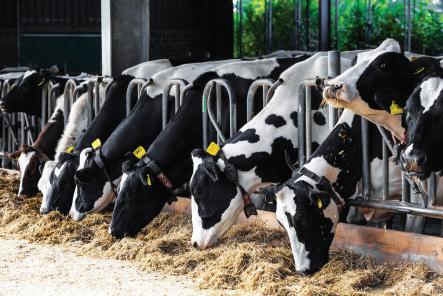




















The Defra milk price has hit 40p for May at 40.39ppl – the rst time it has crossed this threshold.
Milk quality was 4.09% fat and 3.35% protein, so correcting it back to a standard 4% at 3.3% protein standard litre gives a price of 39.23ppl.
Milk prices have continued to increase signi cantly since then, with the non-aligned average price being 45.5p for July and a fraction under 46p for August.
e aligned retailer price averages 45.4p a er scaleback, meaning there is a negligible di erence between aligned and non-aligned prices.
e latest AMPE gure
for June is 56.43p, up 1.33p on May to another record high.
It equates to a farmgate equivalent of about 50.8p a er
JEU commodity prices are on the slide, with many traders away on holiday and the market quiet. This inactivity, especially when twinned with the GDT, will probably only exacerbate
the negative sentiment. The latest official prices, as quoted by the German, Dutch and French dairy authorities, were down again in early July.
For the second week running
an allowance for a margin and supply chain costs.
MCVE is at 54.09p, up 0.95p and equivalent to 46.75p.
Milk prices have continued to increase significantly, with the non-aligned average price being 45.5p for July and a fraction under 46p for August.
there were no positive price increases across the nine EU powder categories and three butter ones, nine negative ones and three neutral moves.
SMP has fallen across all

three sources for the second consecutive week.
Despite the drops though, butter and SMP still convert into an AMPE milk price, equating to current UK milk prices.
JThe GDT is continuing to slide with the first July auction down 4.1% – the seventh loss out of the last eight auctions.
It took the average price down to $4,360 (£3,646), the second lowest price of the year after the first one.
Butter was the biggest
loser and was down 9%, while SMP fell by more than 5%. When converted into a UK farmgate price, the commodities equate to a price of 40-41p.
The auction is important in setting the tone of the market and there is little doubt about the negative sentiment setting in as a result.
JOver the last month, UK milk volumes have averaged 42.87 million litres per day, down 2.1% on last year, with GB volumes at 35.22m litres per day, down by a similar percentage.

This therefore means that Northern Ireland is not contributing significant amounts of milk to GB’s volume. So far this year, the UK has produced between 45m and 46m on 18 days, compared
to 34 days last year. Compared to what the UK could produce –if the maximum volumes which have been produced each day in the past had been produced this year – then volumes would
be 175m litres more by now. But if conventional milk volumes are down significantly then spare a thought for organic volumes. They are down by nearly 9% compared to last year.


JEU butter futures have dropped again and over the last month are down €325 (£275).
The average price is still more than €7,000 (£5,925), but that is because July contracts are at €7,300 (£6,179).
All Q4 contracts are below that level now and that has not been the case since March.
Thanks to currency changes and the decline of the euro against the dollar though, New Zealand butter futures have increased markedly recently.
They are up almost €300 (£254) on the month to an average of €5,690 (£4,816).

But the differential to EU prices is thus 25% now, down from about 30% a week ago, and this gap will either drag EU prices down or bring New Zealand prices up.
EU SMP futures have also dropped by nearly €350 (£296) over the month.
Prices were more than €4,100 (£3,470) in June, but most contracts are below €3,800 (£3,216) now.
futures are down €100 (£85) on a month ago, to an average of €3,990 (£3,377), slightly higher than EU levels.
When converted into a UK farmgate milk price, the prices equate to about 47p.

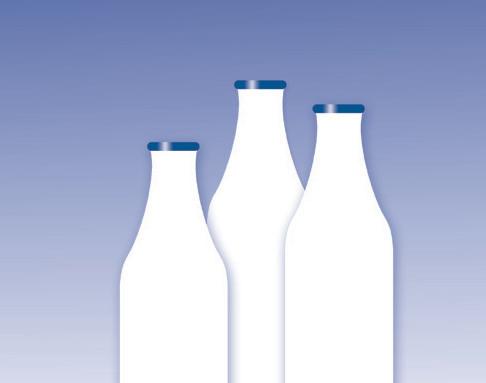

This month, we feature a new herbicide approved for use in Great Britain, a retrofit device designed to counter the impact of uneven weight and vacuum distribution of a milking cluster, a new feature added to smaXtec’s farm tech tool and MEA’s new training scheme launch.
Anew retrofit device, developed by J.F. Hudson, has been designed to counter the impact of uneven weight and vacuum distribution of a milking cluster.
Operating in conjunction with automatic cluster removal and gently supporting the cluster, it eliminates any bias between front and rear quarters, with the durable, high density polyureth ane supports also helping avoid liner slip and kick-offs and the consequential time and labour involved in re-attachment.
The product was developed after the herd management software used by NMR Gold Cup-winning Metcalfe Farms, North Yorkshire, revealed twice as many mastitis cases in front quarters compared to rear quarters, despite the herd having below average cases overall.

After trials with the units on the Metcalfe family’s 72-point Boumatic rotary parlour had demonstrated accurately costed payback in a matter of months, the two busi nesses came together to patent and market Lactalign.
JNew products are featured in each issue of Dairy Farmer.
Please send details and pictures to Hannah Park at hannah.park@agriconnect.com, or call 01772 799 450.
At Metcalfe Farms, the Lactalign supports have shown a 59% reduc tion in liner slip, a 47% reduction in kick-offs, a 65% reduction in
re-attachments and a 50% reduction in mastitis cases in front quarters.
The supports, costing from £150/point, can be fitted to most
JThe Milking Equipment Association is changing the name of its accreditation scheme for dairy technicians and launching a new category 4 master dairy engineering technician course.

The Milking Systems Training Accreditation scheme replaces Parlour Safe, offering training courses and assessment
for dairy technicians to improve their skills and gain an industryrecognised accreditation.
types of parlour, whether rotary, rapid-exit or herringbone.
rMore information at lactalign.com
The new category 4 course is an opportunity for experienced dairy technicians to be accredited with specialist status in the sector and is aimed at those looking for leadership roles which may require them to train or mentor others.
rMore information about courses available at milkingsystems.co.uk/msta
JAgritech company smaXtec is expanding its system to include categorisation of diseases by severity, a feature designed to make it easier for farmers to determine the health status of an animal.


Developers explain the technology works by analysing and evaluating cow health data using artificial intelligence, with algorithms able to process individual vital signs, such as the alarm combinations of the last 72 hours or each cow’s current phase in lactation.

Animals are then automatically ranked according to high, medium or low risk in the app.

rMore information at smaxtec.com

JA new mode of action against grassweeds and a vital tool for controlling black-grass and Italian ryegrass is now available to growers, after BASF received approval in Great Britain for its new active substance, Luximo, and the product containing this active, Luxinum Plus.

Luximo is the BASF brand name for cinmethylin, a soil residual active substance for grass and broad-leaved weed control in winter wheat,

for application at pre- and early post-emergence timings.
Luximo will be available this autumn as Luxinum Plus, in combination with partner products. Producers containing the active farmers will be able to buy are currently under evaluation at CRD and will also contain partner active substances, such as pendimethalin.
rMore information at agricentre.basf.co.uk/luximo
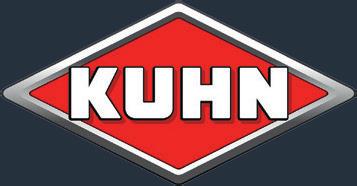
A long-term machinery strategy has brought operational savings and improved cow health at the Worsey family’s farm near Ashbourne, in the Peak District. Dairy Farmer reports.
Farming in partnership with his parents, Tom Worsey has helped to increase the milking herd to 300 at Rough Grounds Farm since the family took on the tenancy in 2005. Their strategy of buying three Fendt tractors and all of their own machinery has been fundamental to growing the herd and improving the farm.
The family has chosen to invest in their own machinery because it avoids downtime and reliance on contractors, but also because it offers flexibility and good use of capital expenditure. Fendt was partly chosen because of the resale value the tractors hold.
Mr Worsey says: “We see farm costs being either contractors, downtime due to old and failing kit or depreciation, and we have chosen depreciation.”
The depreciation is managed by assessing used resale values and choosing machinery which will fit the farming system and hold its value.
He says: “We had a Kuhn 302 mower for five years and only suf fered £1,000 in depreciation. To rent a forage wagon worked out at £14 per acre. To buy it and do 1,000 acres was only £10/acre, so we saved £4,000.
“Also it is there whenever we need it, so we have been able to increase our milk from forage, which is cutting down our input costs.”
Mr Worsey’s switch to the Bavarian brand was the beginning of his decision to bring more machinery work in-hand.
He says: “With GPS and autosteer it is so easy to cover the ground. Even headlands are easy because I do not have to press hundreds of buttons and scroll through menus, I can just flick the joystick, use the foot throttle and then turn the cruise control back on. I sometimes use an old John Deere we have on-farm and I cannot believe how I used to manage every day in a manual.”
The flexibility and reliability of machinery is the key to the Worsey’s farming system. By improving their on-farm provision they have been able to introduce new ways of managing the land and the herd.
Mr Worsey says: “Rather than just letting cows graze, we can mow ahead of the herd. Cows eat more because it is ready for them and they do not have to eat around manure.
“It is also better for the grass be cause the ungrazed areas can
become unpalatable, whereas mowing ahead, the grass grows back more consistently.”
The family farms 162 hectares (400 acres) of grassland and only employ a contractor to harvest 12.1ha (30 acres) of winter wheat.
“When I finished school, we had begun building up the amount and diversity of machinery at the farm.
“I did not really want to milk, but I could see the advantage of manag ing the land ourselves, so we started investing in the right machinery and equipment to make it possible.”
He began silaging before he left school and soon realised that for the farm to be more self-sufficient additional kit was needed.
He says: “I wanted to increase to five or six cuts in a year and to do this I needed control over the whole process. We invested in slurry tankers, more powerful and reliable tractors, a trailing shoe, a dribble bar and a forage wagon.”
To achieve the targeted five or six cuts, he is mowing every four weeks. Using Kuhn mowers he is able to cover 40-50.5ha (100-125) acres in a day. It is then rowed up for a forage wagon, another investment he sees as crucial to the farming system.
He says: “We use the 724 to
The family has chosen to invest in their own machinery because it avoids downtime and reliance on contractors.
pull the forage wagon. For me, it is comparable to the 828, but it uses far less fuel and is much easier to manoeuvre.”

Using a forage wagon has im proved the efficiency with which the farm can take advantage of the limited weather windows.
“The 724 is fast and stable on the road. It corners well and the turning circle is remarkable. The forage box will take three to four acres at a time, so we can be filling the clamp up pretty quickly when the weather is good.
“For me though, it is little things like the rear arms which save the most time. If I want to change from the highest position, which I use for the forage wagon, to the lowest, for the mower, it is just a couple of pins and takes seconds to do.
“And the visibility of the pick-up hitch from the cab makes changing implements much easier and quicker too.”
His greater appreciation is for the farm’s Fendt 516, which is fitted with an MX loader.
He says: “I can do everything on the farm with the 516, but choose to use the 724 to tow the 3,000-gallon
I wanted to increase to five or six cuts in a year and to do this I needed control over the whole process
TOM WORSEY
tanker and the forage wagon because it is more e cient. For most of our work, the 516 is smaller and more economical than the 724 and feels more agile.
“ e visibility is be er too, especially for stacking bales. While it is at home in the yard, I also use it to pick up straw from a farm in Burton-on-Trent, 20 miles away.
“It pulls an artic trailer with 44 straw bales and I can load four bales


at a time. It is faster on the road than the 300 Vario and more fuel-e cient than our 724.”
e family has two farm sites, the smaller is owned and six miles from the main tenanted farm. e tight farm buildings and narrow passages between cubicles at the smaller farm is handled well by the 516, so much so that Mr Worsey has another on order.
He says: “ e 516 is small enough





to get between 4.5-metre bays and it is not revving all the time like a manual tractor. I have used the 724 on the diet feeder and it is too big.





“Everything from the mud guards to the visibility over the bigger bonnet makes it feel less suited for yard work than the 516. at is why we are having another 500 series rather than a 700.”
e new 516 will be used for more eld work and has been speci ed with wider tyres to reduce soil compaction.
“ e aim is to have the same 650 tyres on the back and 600 on the front as the 724, to give it a wider footprint than the loader tractor.

“It will also o er us further exibility, as any of our three tractors can be used for almost everything on-farm.”






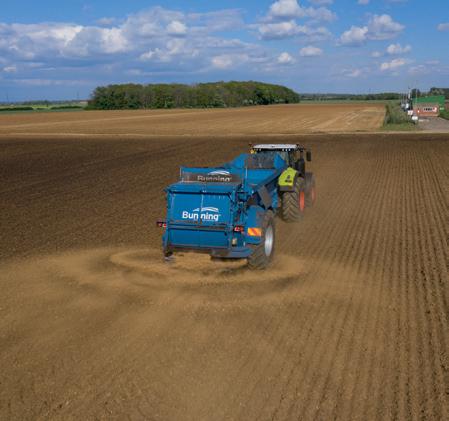

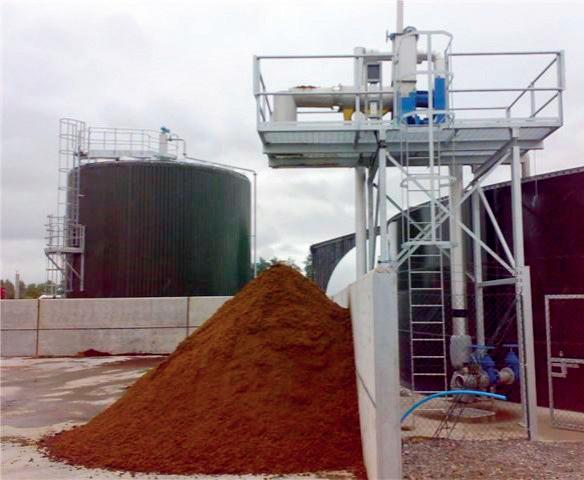


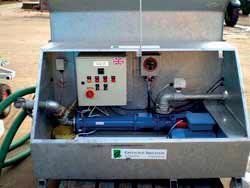


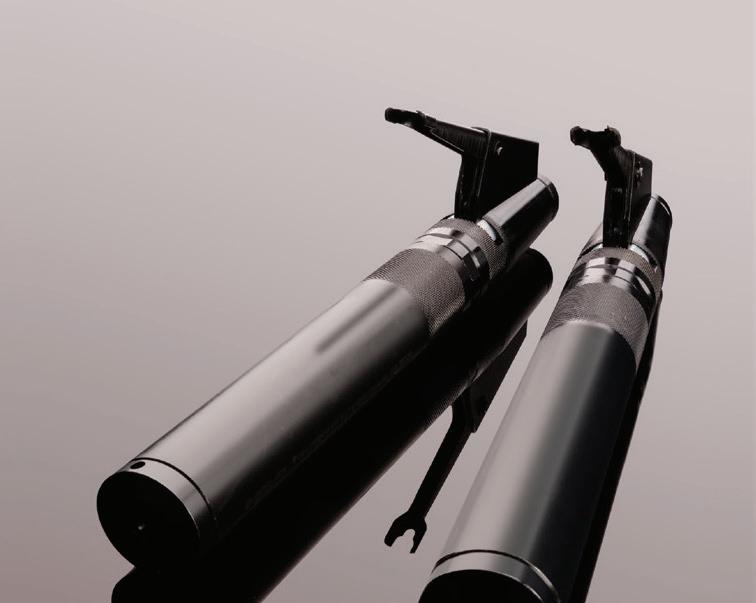




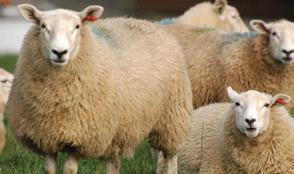

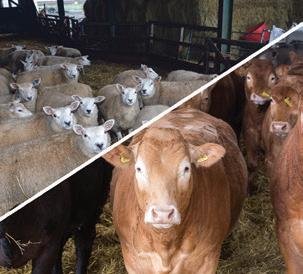

•
Agri Connect is the largest multi-platform agricultural information business in the UK. Our brands reach deeply into all the major agricultural sectors – arable, dairy, livestock, agricultural machinery, finance and equipment. We take a farmer-centric approach to media. Our job is to help farmers run their farms more efficiently and make better purchasing decisions. There are many ways in which we can do this –magazines, websites, webinars, podcasts, conferences, events, and marketplaces.
You will be a key member of an energetic, supportive, and enthusiastic team who are committed to building on our positive and dynamic culture.
The main function of the role is to develop business through growth in revenue, yield, and to increase customer numbers. You will be required to identify new opportunities and influence companies’ media buying habits within the agricultural sector. Due to the ever-changing nature of the industry, this person will have the ability to spot new avenues and exploit market trends.
• Own, support and fully develop specific market sectors
• Conduct sales presentations by telephone, email or face to face to existing and prospective clients in order to develop existing business and generate new business wherever possible.
• Advise existing and new customers on the most effective solution to meet client needs within the Agri Connect portfolio.

• Continually seek and develop new sales & opportunities.
• Achieve all pre-set sales targets ensuring a successful contribution to the business performance.
• Keep abreast of all current trends, activities and relevant news within agriculture.


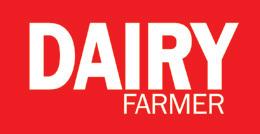

• Be enthusiastic and motivated to continually explore
• Excellent communication written and interpersonal skills.
Possess
•
natural inquisitive nature.
optimistic approach.
business at relevant industry events
of
driven and efficient.
attitude.
Maintain the highest professional standards.
system
This month, Roger Evans writes about life after selling the majority of his family’s milking cows, what the short-term future for the farm looks like, and the importance of attracting young people to the industry.
For the first time in 58 years we are not selling milk. We are milking cows every day but there is not enough milk for a tanker to call so we are giving it to calves. The first milk we will sell will go into a vending machine. We will probably get back to proper dairy farming but there’s no rush and we will take this break and make the most of it.
As an example, all of our family were down at the rugby club to watch our two eldest grandsons on Saturday. They scored three tries between them and did all the place kicking. The younger of the two was only there to do the eldest boy’s tackling and he, the eldest boy, didn’t do any place kicking in the second half. When I asked him why, he said his hamstring was tightening up and I said: “We don’t have hamstrings in this family.”
This loss of land, traumatic as it is at the moment, may look quite different in years to come. The real problem has been the price of milk, it’s been too cheap for too long. Everything we did was expensive, the rent had more to do with the Basic Payment Scheme (BPS) money than the price of milk.
We used to bring grass for silage home and for the cows to eat if grazing was short. Now I’m not so sure that the acreage we have left is viable. My son is milking part-time elsewhere and we are try ing to create a living for our eldest grandson.
Over the years I’ve met lots of farmers who have given up milk production. It may sound very obvious, and it did to me at the time, but as time goes on what they really miss is the calves. When the cows go, so also do the calves.
There is something of the self-perpetuating about a dairy herd. You get used to all those calves turning up.
What really focuses your mind is that you have to buy livestock to replace them and usually you are
not used to having to do that. Suddenly you have to know all sorts of things. You have to know the price of cattle and sheep and how much it costs to grow an arable crop. What you don’t know is how much all these things will be worth when you sell them.
Farming has always been like that. We have had the BPS payment to give us a start into the New Year but that will disappear.
We don’t yet know what all those trade deals will do to the value of what we sell, but the signs are not good.
It’s true that events in Europe have made food security climb the agenda but folk don’t have any spare money to spend on food so I can’t see it getting to prices that will cover the rise in the cost of inputs.
Looking on the bright side, which I occasionally do, we kept two cows back when we sold the rest, because they were close to calving. They calved the next day so we are away again. That’s two calves we didn’t have before.
Then there’s a bunch of heifers that we will put to sexed semen when the time comes so we will have some heifer calves in the pipeline.
Life will go on as before. We will be farming a lot less ground but in the years yet to come we might look back on this as just a blip in life’s rich pattern.
It’s not as true today as it once was but there used to be dairy farmers about that hadn’t missed a milking for years and years. I have never been in that category. I have had holidays with my family and I was lucky enough to have a friend who took me around the world.
I’ve met dairy farmers wives who haven’t missed a milking for years either and I have often had the thought ‘I wonder what he was doing while she was milking?’
I think that milking all those hours will be a
thing of the past. It’s possible that it will still occur but it’s something not to be proud of.
I’m not a big fan of huge herds. I like to see cows out on grass, but if there is some scale there’s probably a team involved in the milking and people can get proper time o . It’s the only way our industry can a ract new young people and if you don’t do that what sort of future is there?

So we have a le er from the Ministry to say that because we didn’t have a TB test in the rst week of March like we should have, we are now under
restriction until we do. We phoned back to say that we had a whole herd test at the end of February, it was clear and they organised it. And the nice lady on the phone says ‘so you did, sorry about that’. If TB wasn’t so serious it would be funny.
If the Ministry don’t know what they are doing, who does? I suspect that they are being told that an e ective vaccine is close at hand and until it is available they are just going through the motions.
Still, what do I know? As much as the Ministry apparently. But she was a very nice lady on the phone, very apologetic. Isn’t life so much be er if people are nice.

“We might look back on this as just a blip in life’s rich pattern
Rising costs, a need to address climate change and a recognition of the importance of livestock in arable rotations has shone the light on regenerative farming. But how can the practice be defined and what benefits might it deliver to a dairy farm? Cedric Porter reports.
The first use of the term regenerative farming was in the early 1980s by the Rodale Institute in Pennsylvania, which established a Regenerative Agriculture Association.
At its heart was the regeneration of topsoil, increasing biodiversity, improving water management and becoming more resilient to climate change.
Ruminants are integral to many regenerative systems because of the need for grass in rotations and the fertilising properties they deliver.
In many cases, this has involved introducing sheep and beef cattle into
the system, but dairy cattle certainly have a place.
Processor Arla has embarked on a four-year pilot project exploring regenerative techniques on dairy farms in the UK, Sweden, Denmark, Germany and the Netherlands.
It said: “Despite the growing momentum around regenerative agriculture, there is currently no regulatory or legal definition of what regenerative agriculture is.
“Furthermore, there are limited scientific examples of regenerative farming within the context of grass-based dairy farming systems in Europe.
“As a European dairy co-operative,
owned by more than 9,000 farmers across seven countries, it is critical for Arla to gain a better understand ing of how regenerative practices could be applied in dairy farming, and better understand how this approach could be adopted at scale across both organic and conventional dairy farming systems.”
Arla farmer Dan Burdett is driven by regenerative principles on his family’s 300-hectare (741-acre) Cockhaise Farm near Haywards Heath, West Sussex.
The farm is also an AHDB Strategic Dairy Farm and Mr Burdett has conducted a Nuffield Scholarship into regenerative farming, in which
Excellent Good Average Cockhaise
Cows and heifers calved within first six weeks >90% >80% <70% 95%
Herd replacement rate <20% 22% 26% 29% Milk solids (kg/hectare) >1,500 1,250 1,100 468 Milk yield from forage (litres/cow) >5,000 4,000 2,750 3,182
Full economic net margin (ppl) 7ppl 2ppl -3ppl 19.4ppl
Return on tenant’s capital (%) -20% 14% 3% 9%
Full economic costs of production (ppl) <24ppl 30ppl 34.5ppl 29.5ppl
Source:
Farm and AHDB
JFrom April 1, 2022, First Milk has paid a 0.5ppl Regenerative Farming Bonus for producers who have completed a Regenerative Farming Plan detailing current practices and planned changes to reduce carbon emissions. The system is backed up with a digital mapping tool developed by consultants Kingshay.
Yeo Valley has established a regenerative farming project for its 150 organic suppliers. It measures soil carbon using
the Farm Carbon Toolkit and is carrying out research on the use of mob grazing, diverse cropping, composting, agroforestry and the capture of carbon in the soil using biochar charcoal.
Danone says it is developing regenerative models for its 58,000 global farmers. This includes supporting national initiatives such as Ireland’s Origin Green, support for global organisation Sustainable Dairy Partnership and online seminars.
Raw milk supplier Stroud
Micro Dairy cites regenerative agriculture as one of its guiding principles.
It says: “We take a regenerative approach to farming, which means we promote plant and soil health through biodiversity and the balance of natural systems.”
It keeps calves with mothers for two months after birth with a further month where they continue to interact.
he says that while many farmers adopt regenerative techniques out of necessity because of land degrada tion, there is a real passion around the world for farming differently.
He says: “Regenerative agriculture is a broad-brush approach to farming. It is about looking at improving the health of soils, the lives of the people around the farm and the economics of the business.
“We want to create soil which is healthier and has a more vibrant eco-system in it. We want more resili ence in the grazing system. The water that comes through the farm comes out a lot cleaner and we have a higher level of ecology with biodiversity.”
Mr Burdett is building on the organic system which was established on-farm by his father. Average yields are 6,000-6,500 litres, with 95% of cows calving within a six-week autumn window.
Financial benchmarking data prepared before the dramatic rises in feed and fertiliser prices over the last year shows much lower out put per hectare than conventional
Ice cream maker Ben & Jerry’s has launched a ‘Mootopia’ project, which involves 15 farms in the USA and Netherlands with an aim of reducing greenhouse gas emissions by a half by the end of 2024.
The Unilever-owned company is focusing on changing diets, managing manure better and using regenerative min-till systems to reduce the impact of forage and cereal crops used to feed cows.
systems because of the size of the farm and smaller yields.
However, lower costs and milk premiums mean a much higher economic net margin than other dairy farms at 19.4ppl. Costs of production are similar to other farms, but Mr Burdett says his system is much less exposed to the increase in feed, fertiliser and fuel costs seen over the last year.
Integrating dairy production and









other livestock into a regenerative farming system was a feature at the recent Groundswell and Down to Earth events.
At Groundswell, US forage expert Seth Itzkan argued that grasslands have been one of the reasons why life on earth has been able to thrive over millions of years.

He said: “We did not become ‘ice house earth’ like Mars or ‘hot
house earth’ like Venus, because we have grasslands which are able to act like a thermostat, keeping global temperatures steady and regulating carbon ows between the atmosphere and soil.”
He argued that the world needs more grassland-based livestock rather than less.
Ian Bailey from consultants Triage says there is the potential
for a 75% reduction in the use of nitrogen fertiliser in a regenerative livestock grazing system, which could sequestrate between eight and 18 tonnes of carbon a year. at could be worth £160-£180/ha (£65-£73/acre) when the sequestrated carbon is traded. Aside from input savings, Sustainable Farming Initiative soil payments of at least £40/ha (£16/ acre) would also be available to English regenerative dairy farmers.

Selling milk direct to the public is becoming an increasingly popular way for dairy farms to add value to their milk and other dairy products.
Milk sold in this way can either be pasteurised or sold raw, with batch pasteurising a method used to achieve the former which can be done on-farm with the right piece of kit.
Bruce Dalby, director of Batch Pasteuriser, a company which makes, retails and distributes batch pasteurisers to customers around the UK, is passionate about the bene ts batch pasteurising milk to sell direct can bring to dairy farms and their margins.
He says: “Batch pasteurising is a process which heats milk in a vessel rather than a continues ow which is what the supermarkets use. e process produces non-homogenised pasteurised milk – the way milk used to be supplied when it was delivered to doorsteps.

“What di erentiates the process from mainstream methods is that the milk is heated very gently by hot water in a jacket around the milk at 63degC for 30 minutes.
“While this is not feasible on in large-scale production, it works well for individual farms.”
is milk can then be marketed direct to the consumer, either in liquid form or in products such as yogurt, cheese, ke r and so on and retailed via various methods.

Vending machines in particular appear to have seen a particular boost in popularity recently – a concept which sees customers bring their own bo les or use those provided by the farm at a cost.
Money is then paid into the vending machine which then lls up their bo le with milk. ere is also the opportunity to add value further by o ering avoured milk options, an addition many selling milk direct have opted for.
In terms of set-up cost, Mr Dalby explains that his pasteurisers start from £10,000 and range up to £17,000 depending on size.
He says: “A 150-litre capacity
pasteuriser will retail for just over £10,000 and we would expect that machine to pay for itself within three months.
“We have manufactured pasteurisers with up to a 1,000 litre capacity and we now have more than 100 of our pasteurisers in use in the UK.”
According to Mr Dalby, customers purchasing batch pasteurised milk at the moment are happy to pay, on average in the UK, about £1.50/£1.60 per litre for the product.
Selling raw milk is another way milk can be sold direct, but this has a di erent set of requirements.
JThe farm’s milk buyer and local health officials need to be informed before even considering this route to market.
This is the advice from Gemma Smale-Rowland, who set up one of the first vending machine direct selling business to sell milk direct from their 120-cow Holstein herd in 2019 – Cornish Moo.
Ms Smale-Rowland says: “Two phone calls I would say are essential before you even consider [selling milk direct] is one to your milk processor to see if they will allow it and then one to your local food standards agency to get their input.
“Some milk buyers might have restrictions in place, while your local food standards
office will be able to talk to you about what inspections need to be carried out, whether you can sell milk raw in your area or whether it is required to be pasteurised – rules and regulations will vary between regions.”
Another important consideration Ms Smale-Rowland highlights is location.
“Location is key and I would say I am way too rural. Those vending machines situated on the side of a main road or route will do best out the direct milk selling route.”
Alongside the initial set-up cost, Ms Smale-Rowland also stresses the time involved thereafter to keep machines well-stocked.
She says: “For us and I think most others who do it would say the time, it is an extremely time-consuming thing to do.
“There are businesses that have put them in but have since taken them out for that reason.”
The boom in popularity of direct selling milk does however mean there is more availability of information and equipment do to so.
Ms Smale-Rowland explains she imported her pasteuriser in from overseas at the time it was installed in contrast to now where several UK-based production companies have been established alongside advice forums for those interested in going down this route.
Batch pasteurising on-farm is becoming a popular method for those wishing to sell their milk direct to the public, but what are some key things to consider before taking this route? Hannah Park reports.A 150 litre capacity pasteuriser will retail for just over £10,000, says Bruce Dalby.





















